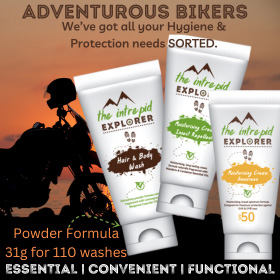 1Likes 1Likes
 |
|

11 Mar 2011
|
|
Registered Users
Veteran HUBBer
|
|
Join Date: Oct 2010
Location: Krasnoyarsk, Russia
Posts: 216
|
|
|
2/11/11 Santiago, Panama City - Panama (Part 2)
We bid our friends in David goodbye and headed towards Santiago, about four hours away. Kathy had given us the name and number of her son, Ahren, who had invited us to stay with them for a few days. Ahren was an avid motorcyclist in the states, and he recently moved to Panama, having also met a Panamanian doctor.
Ahren and Magally:

We ended up spending almost two weeks here, partially because our hosts and their family was incredible, partially because we were helping Ahren deal with shipping a container in from the USA.
Santiago, with Magally's family, was incredible. Probably the best we've gotten to know a family on this trip. They welcomed us with open arms and we spent many days immersed in the Panamanian way of life. I don't know where to start with our time in Santiago, so I'll just tell some highlights.
Family trip to the river, first day:
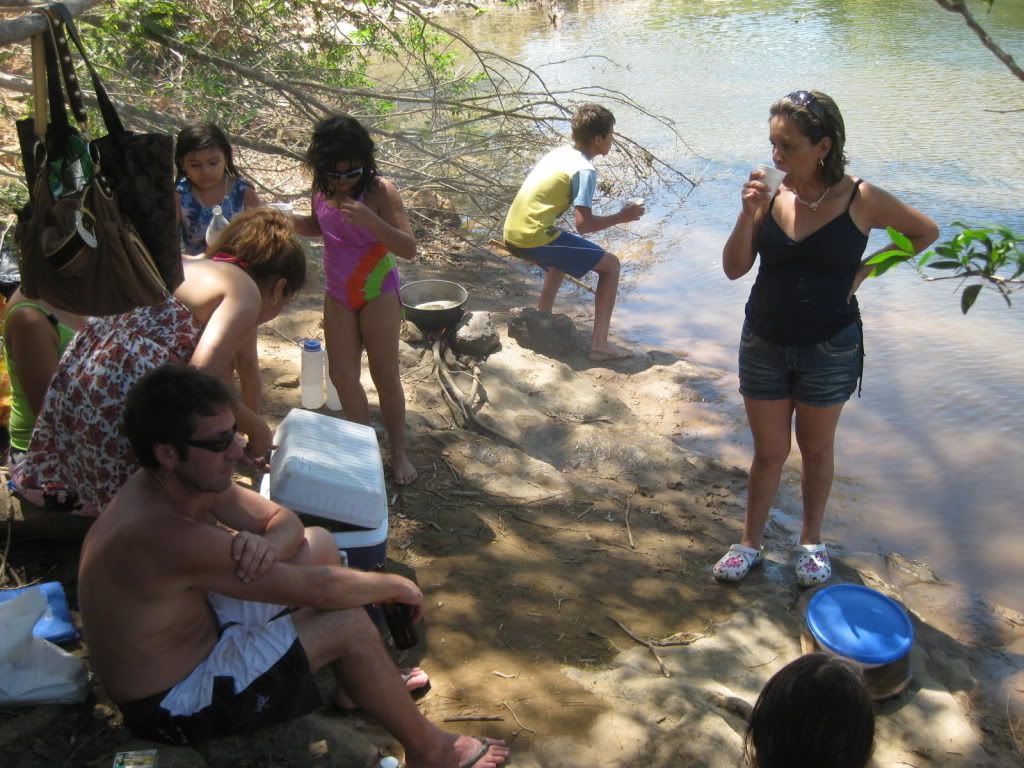
Feasted on chicken, rice and guandu. Guandu is a bean grown in Panama, that only grows for two months a year. During these two months, everything is served with guandu.

Crazy fruit I don't remember the name of:
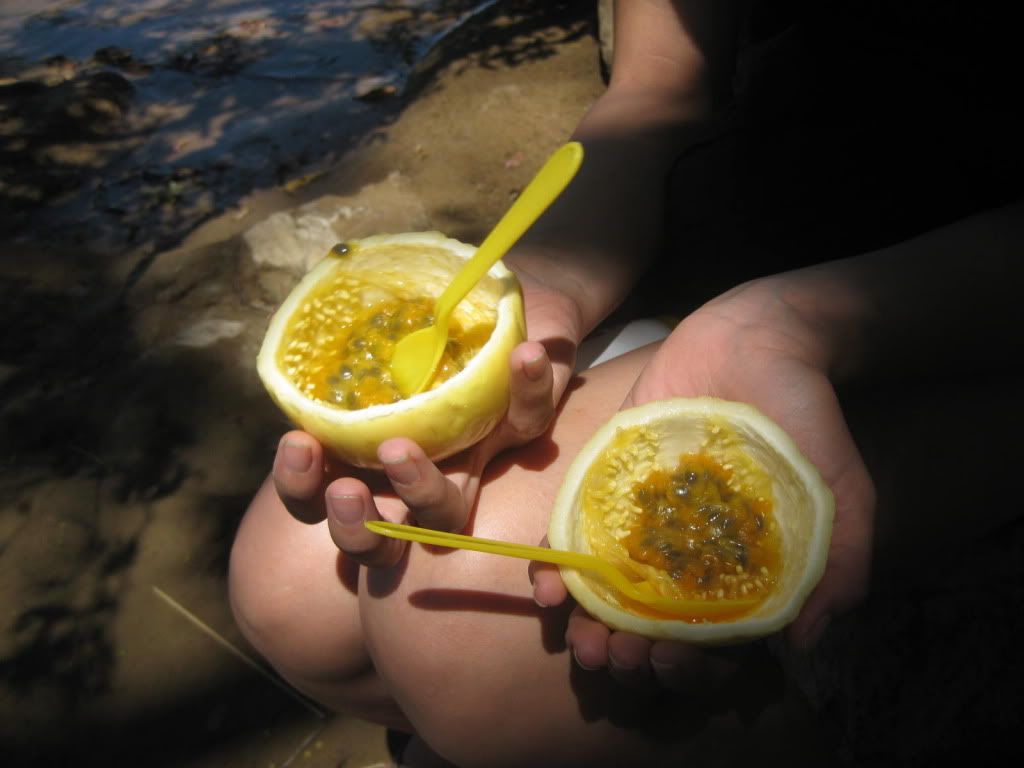
Going out to a little port town for dinner with the family.


Dirt cheap fish plates, before and after.
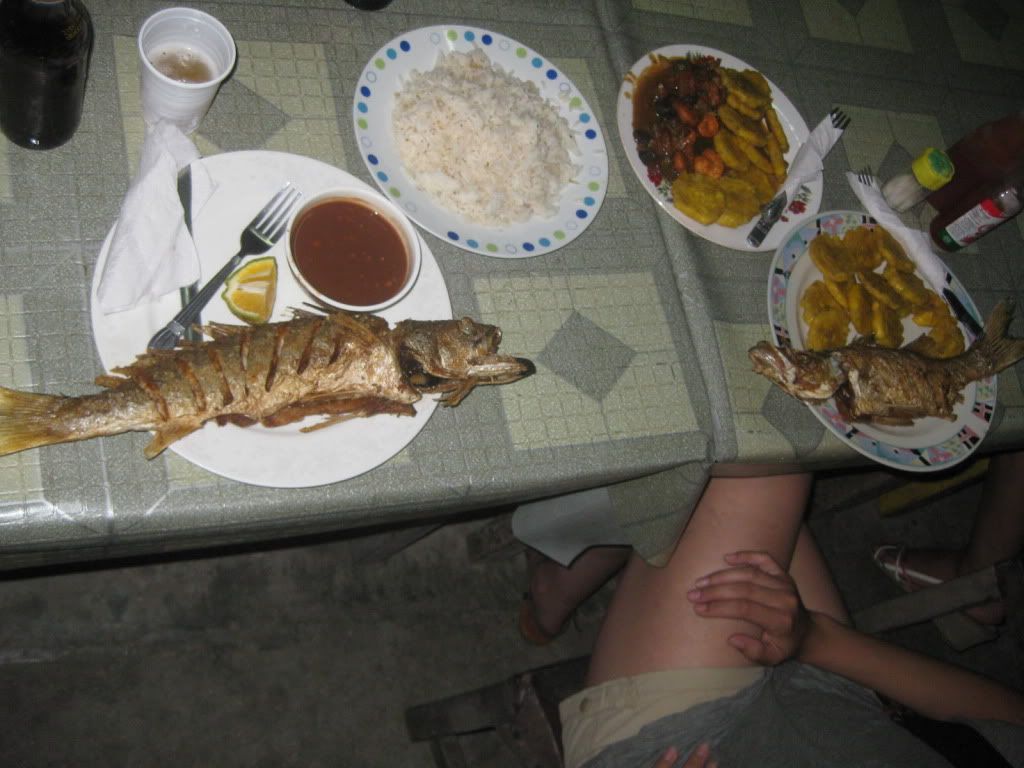

It was Oriel´s (Magally's nephew) 16th birthday and we bought him a cake.

Vicky is a professor at the local highschool, which is apparently the biggest in Central America. She gave us a tour of the school and Santiago.
The school was incredible:


The artist died while painting this auditorium and it was left unfinished.
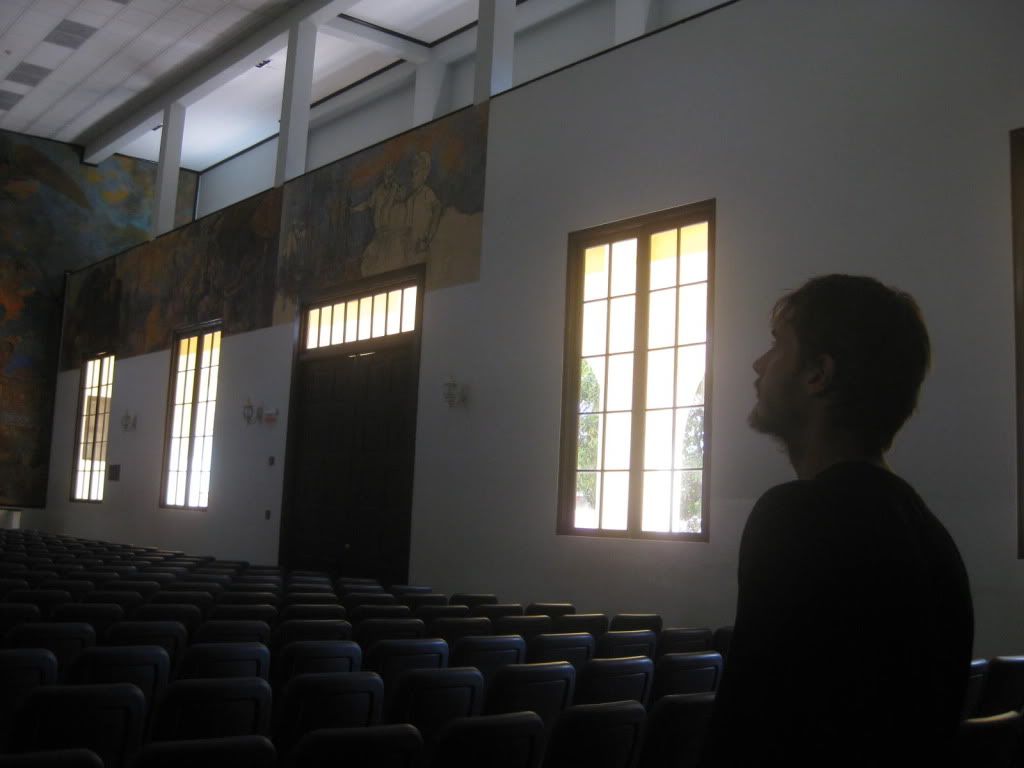
Beatiful, detail everywhere.
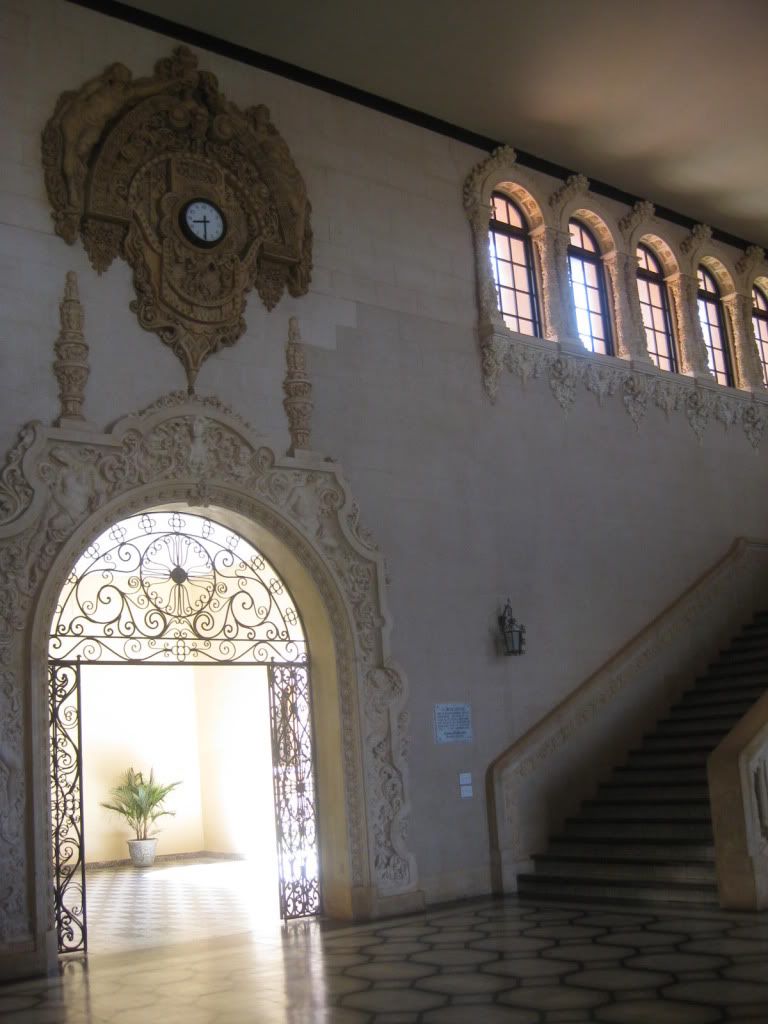
Museum of Santiago displaying traditional Panamaian wear:
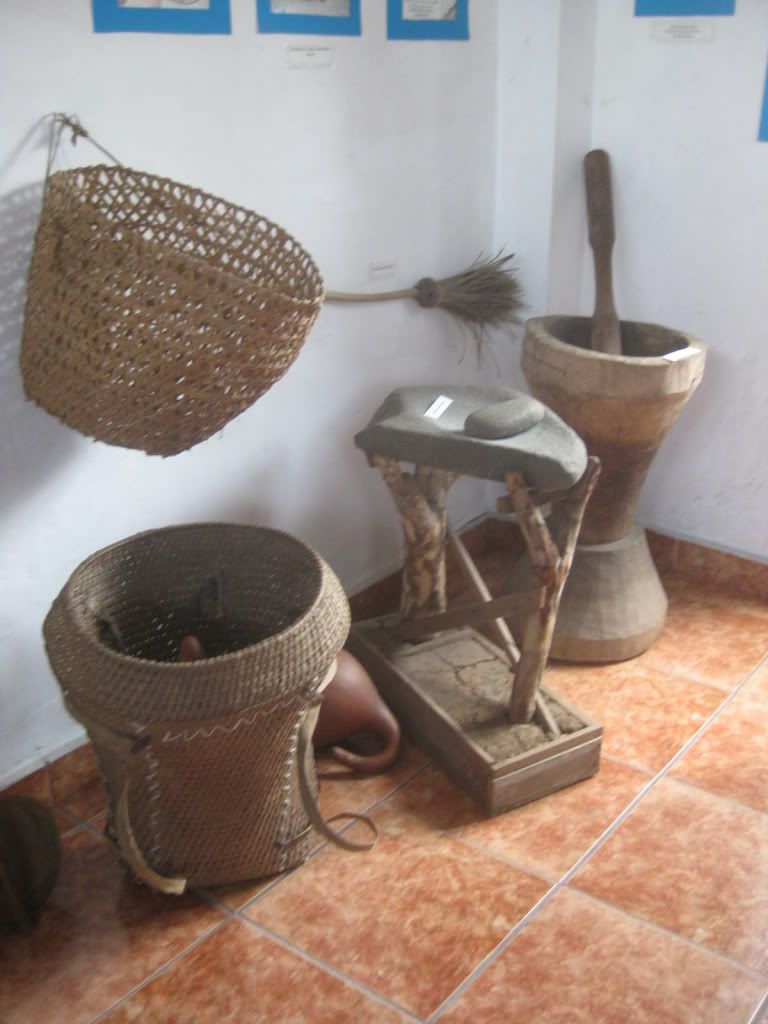
Bascillica outside of Santiago:

Vicky also killed some of her chickens to make us Panamanian sancocho (delicious soup of onion, garlic, cuillantro(?) and chicken). Also, Panamian tamales (a little different, they have olives in them).
Went to the Veraguas fair:

The young ones love the horse rides:

We also spent several days driving to and from Panama City with Ahren, Magally and Beto. Panama city has insane traffic, and Magally will not drive there and Ahren does not have a license yet. Beto is Magally´s uncle, who volunteered three full days of his time to driving us around Panama city, skipping work to do it. Because "you're family". I saw time and time again friends and family going to extreme lengths to help one another out. Quite incredible.
The reason for our trips to Panama city were to retrieve a container of tools and furniture that Ahren had shipped to Panama from the states. It was supposed to be a simple, drive up, sign, pick up deal. Done by lunch. It ended up being three days (20+ hours, no exaggeration) of driving through gridlock traffic from office to office, so Ahren could fork over hundreds of dollars to shady middlemen or useless buearucrats. We would get marriage papers, employment papers, residence papers in order, and then we would spend hours to find out that X document wasn't valid, Y document needed to be translated, Z document needed to be notarized again. It was a heroic effort. We drove to and from Panama (8 hours round trip) city twice, had to spend the night there once, and spent days driving around in Panama city gridlock. 10 days late and $1500 later, the container was home.
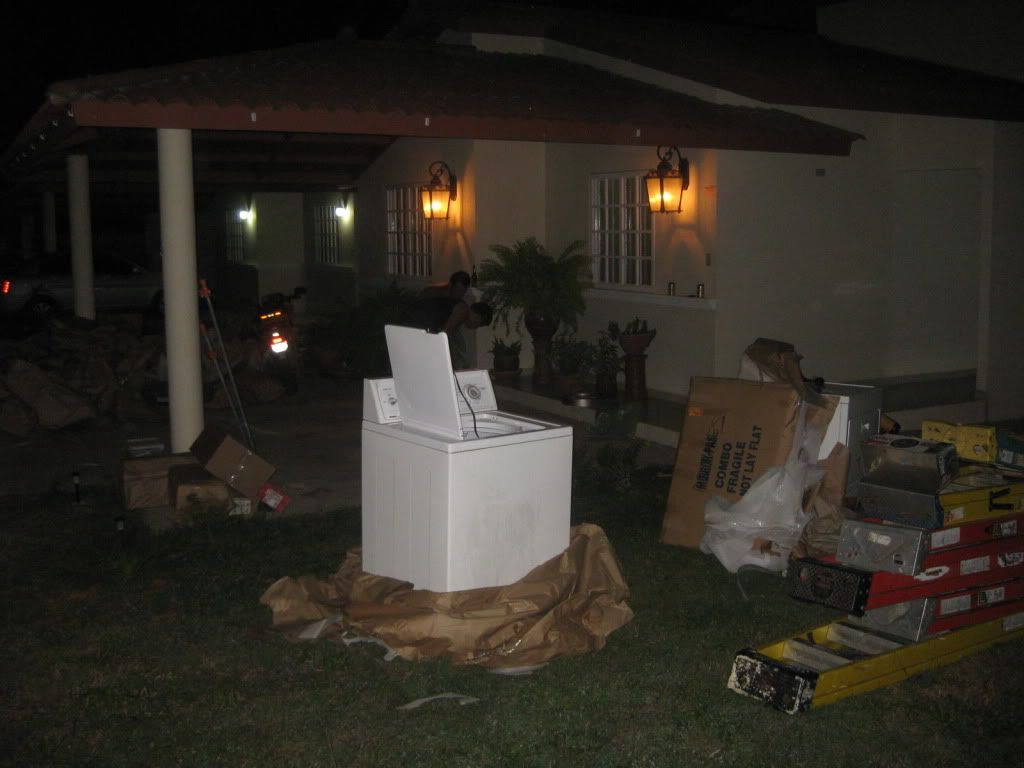
A miserable experience for Ahren, but me and Michelle didn't mind it. We got to see Panama city without the stress or expense of navigating it ourselves. What a city! Huge skyscrapers everywhere. The most extravagant and modern city we've seen all trip.
Popping up over the hills on the road in.
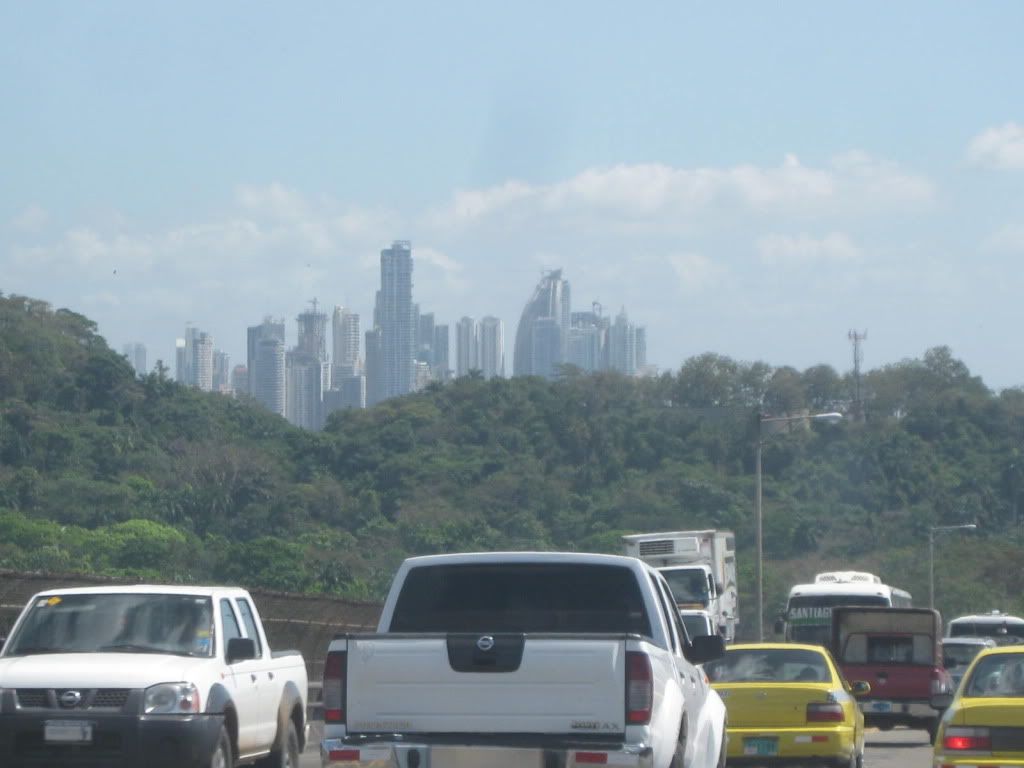
Unforunately no good pictures, so I stole this one off google to give some idea of the scale of this city.

Muchas gracias a todo la familia en Santiago. Me encanta la experiencia que yo tuve en su ciudad. Nunca voy a olividarlo. Espero que puedo regresar muy pronto.
2/22/11
After such a long time in the Panama interior, we were looking towards the South, excited about South America but with still no idea how we could do it with our budget. We said goodbye to our friends and headed for Colon to find out...
|

11 Mar 2011
|
|
Registered Users
HUBB regular
|
|
Join Date: Jul 2009
Location: Utah
Posts: 33
|
|
|
I seriously laughed out loud when I read the welding job in David didn't even make it out of Panama.
If you want anything done right you have to do it yourself here. Problem is, somethings you aren't allow to do yourself. And it's all down hill from there. Thanks for the great stories and pics.
|

12 Mar 2011
|
|
Registered Users
Veteran HUBBer
|
|
Join Date: Oct 2010
Location: Krasnoyarsk, Russia
Posts: 216
|
|
|
2/22/11 Panama coast (Panama part 3)
We headed towards Colon, the big port town on the Caribbean side. We were told that Colon was not a nice place... and it wasn't. Kind of cool though, all the buildings are really old, and still used, but not maintained at all. The people mostly live in a tall, delapidated buildings. Seems like the pictures I've seen of overcrowded African cities.
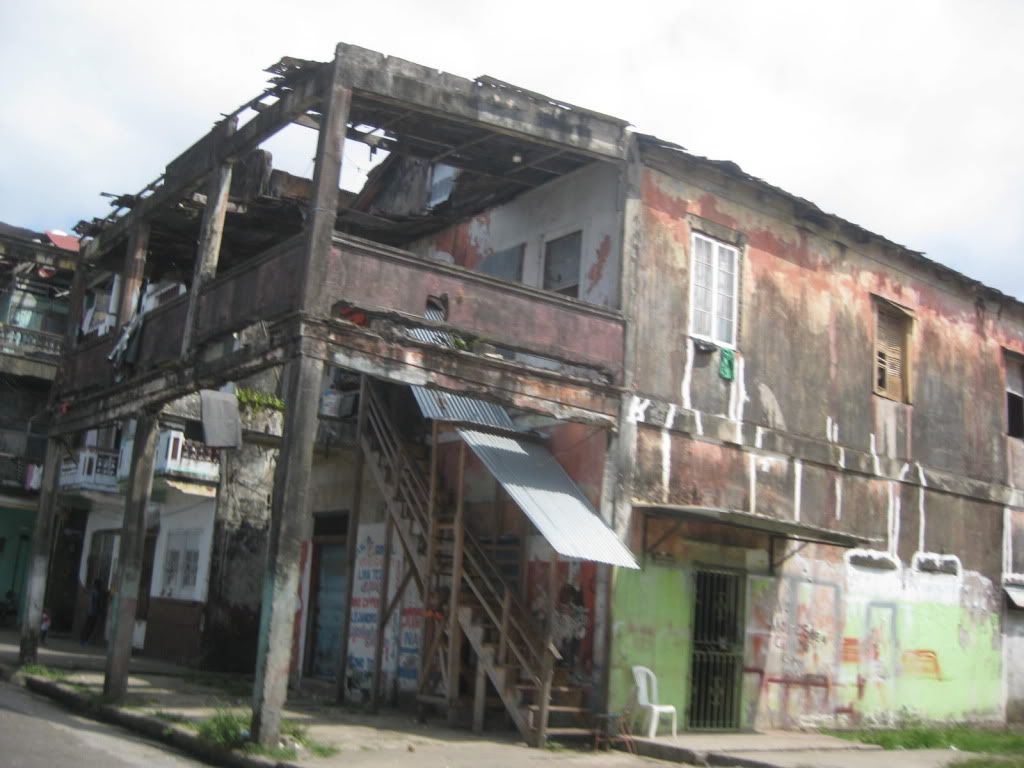
Very cool.

"Hotel Garcia" was $9 a night, not a bad deal.
There is no road between Panama and Colombia. It is separated by what is called the "Darien Gap", 80 miles of thick jungle that is impossible to cross. Flying the bike to Bogota is an option, but very expensive ($900 for bike alone). There are also several captains shuttling tourists between Panama and Colombia on sailboats, but these are also very expensive ($1200-$1600 for the bike and two people). Our budget would not allow for either of these options, so we were hoping to find some local boat that we could get a better price with.
Next day we started asking around at the docks. We talked to a captain who gave us the number to Captain Sierra, who makes the trip to Colombia frequently. Michelle called him and got a price of $300 to Puerto Obaldia, a port town on the Panama - Colombia border. The trip would take three days, and food was included. We would still have to catch another boat or two to get to Turbo, but we were assured these would be cheap. Settled!
Our boat didn't leave till Sunday (it was Wednesday when we found that boat), so we killed a few days in Colon.
We went to the "Zona Libre", a huge shopping center in a tax-free grey area.

This place is wierd. You have to get a permit to enter (for tourists it's free). I think partially it functions as a place for merchants to buy their goods in bulk, alot of stuff didn't have prices, just technical information and number of pieces in a box. But you could also buy individual pieces at some places, including incredible deals on designer clothes and accessories. The catch is, you can't just walk out with the stuff after you buy it. According to the sailswoman, you can either have it shipped to the airport, or you can put it in the trunk of a taxi (the police can't search the taxis). There were several vendors of Chinese motorcycles, I saw a brand new 125cc work motorcycle for $300. Bulk price?
My birthday is Febuary 25th. We celebrated with cake!

But.... it wasn't the 25th. It was the 24th. We lost track of what day it was. We celebrated again the next day.
On Friday we headed to Miramar (small port town 3 hours West), where our boat would be departing. Fun tropical road along the beach, but you never want to go too fast because you never know what might be in the road around the corner.
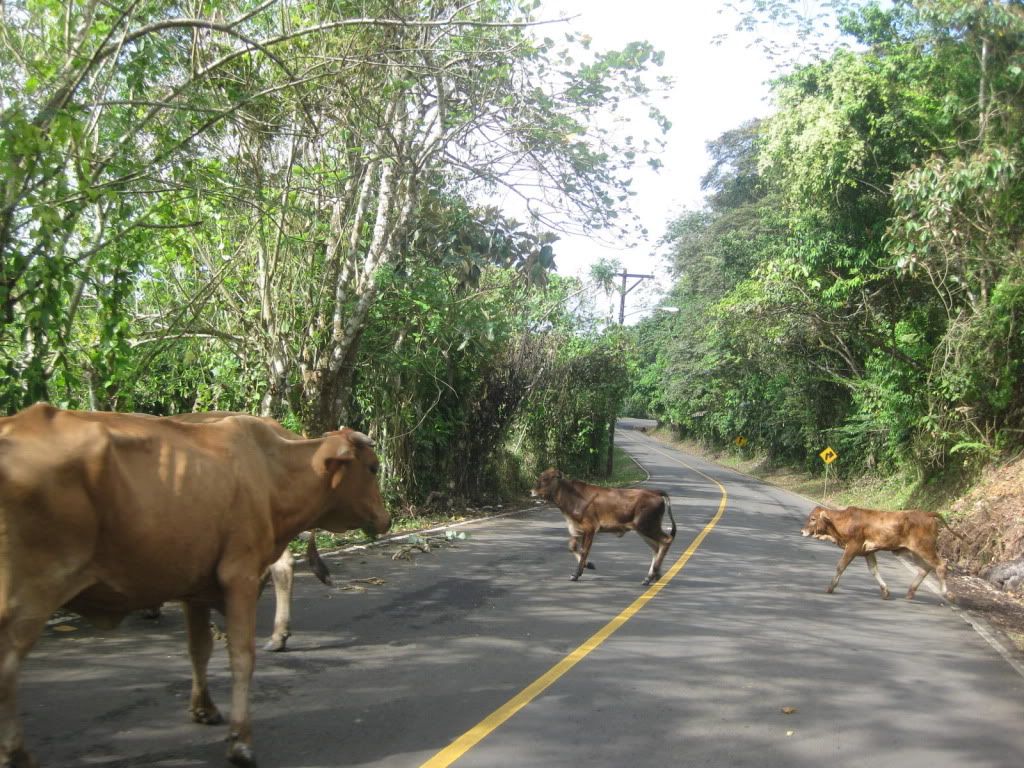
We got to Miramar, but found no affordable place to stay. We headed to the next town up, called Palenque, where we asked around for a woman named "Sista" and found lodging for $10. Very small, very poor town. We went to find something to eat at 5:00pm but the two restaraunts were both closed. Luckily we had more canned food left. Nice beach though, if you ignored the trash.

Saturday and Sunday we spent all day sitting around at the dock waiting for the stuff to get loaded onto the boat. We were supposed to leave on Sunday but the boat was still awaiting more supplies so we put our stuff on the boat and slept on the deck. Monday we continued waiting. Word on the docks was the boat wouldn't leave until Wednesday. A Candian backpacker named Mark wandered onto the dock that morning and asked where we were going. Turns out he was looking for ride to Colombia as well, so we talked to the Captain and got a price of $50. Mark would be our maritime traveling companion for most of our adventure to Colombia. He is also a fantastic photographer with a nice camera, and I was lucky enough to grab a few of his pictures before we parted ways. If you see a good picture in this section, it's his.
Mark and Michelle were not enthusiastic about the prospect of sitting on the dock for three days, so we took off on two day trip to the famed San Blas on a little lancha. The seas were rough, the boat tiny, and it ended up being a 90 minute rollercoaster.

San Blas is hundreds of incredibly beautiful, tiny islands on the Atlantic coast of Panama. The Kuna Yala indiginous are semi-autonomous and have a very distinct style of building, rituals and dress. Unfortunately, our lancha was going to Porvenir, the airport island and staging ground for the rest of the islands. Small, beautiful, but not all that interesting after you've seen everything there is to see in 15 minutes. We were all on a budget and didn't have much time, so paying lanchas to shuttle us from island to island wasn't in the cards either. We ate octopus, swam in the crystal clear water, slept in the top floor of a kuna museum, and generally had a good time.
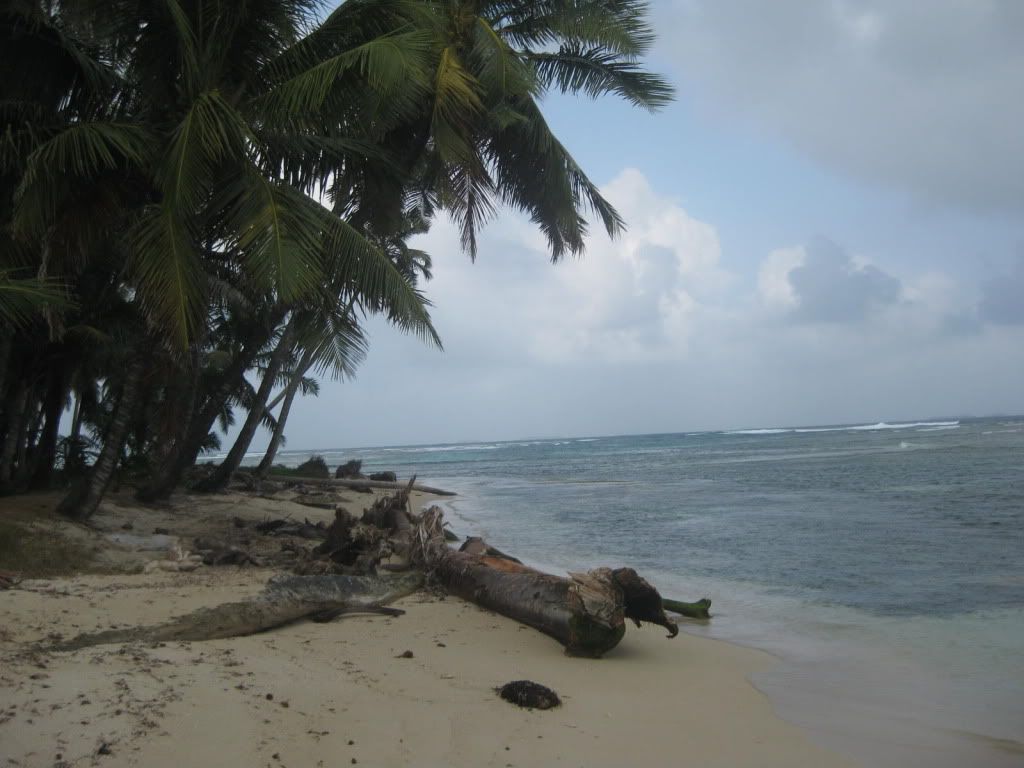
(Photo by Marshal Chupa)
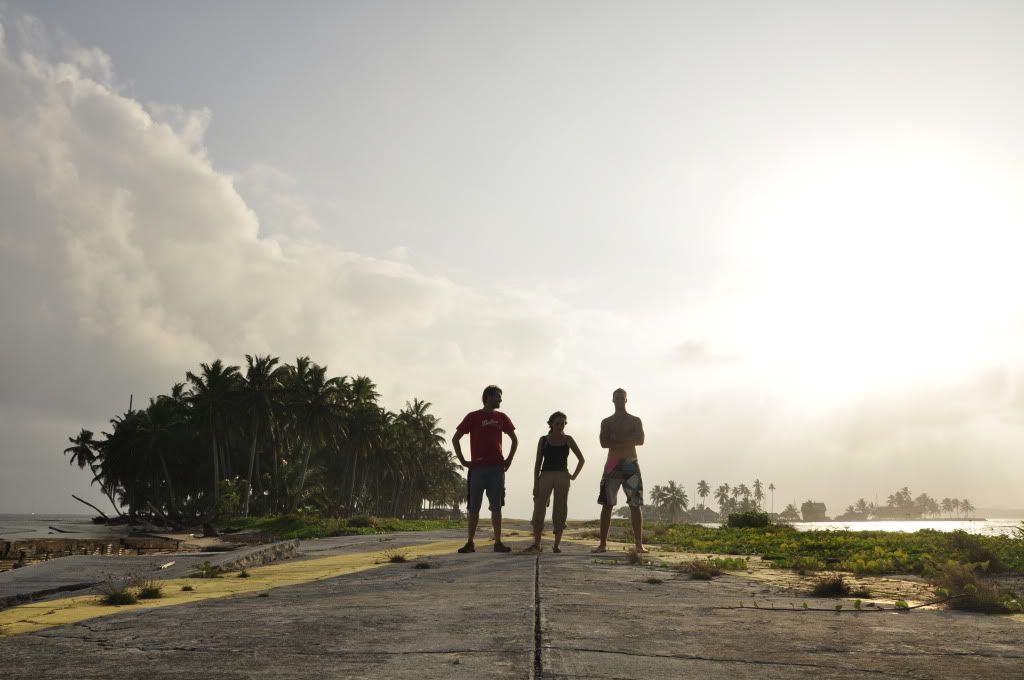
Our sleeping quarters:
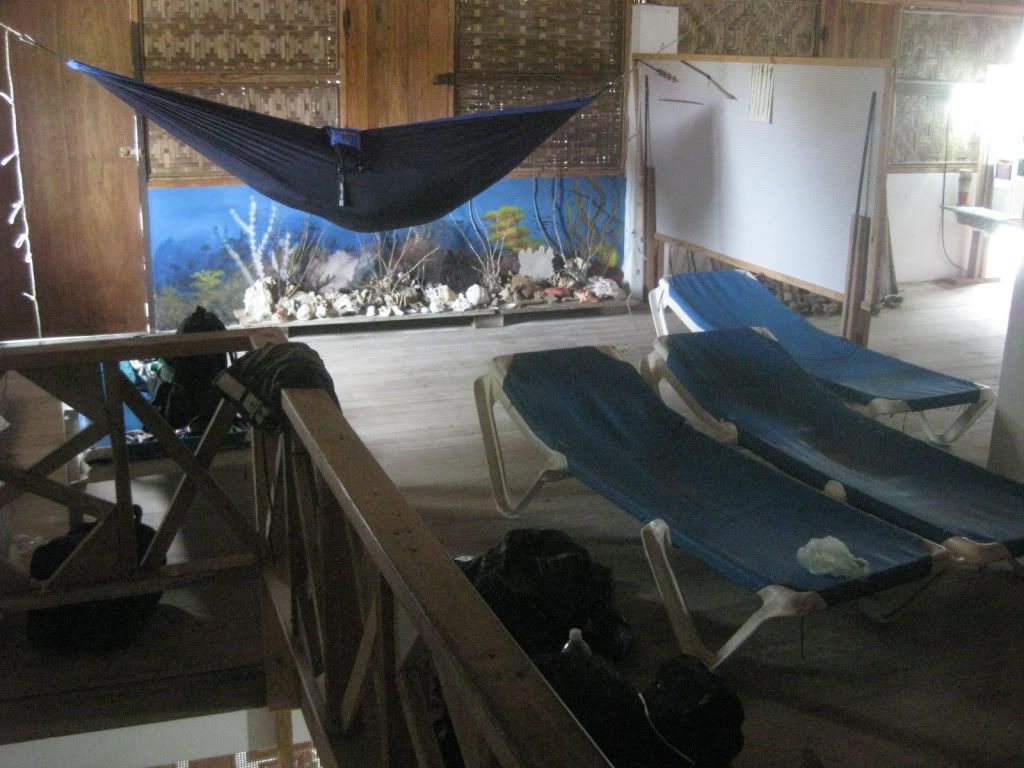
I would come to regret this little day trip, and not just because of the unexpectedly high cost (almost $100 for 24 hours of food, lancha rides and lodging).
On the way back from Porvenir we caught a little cargo ship going back to Miramar. This boat took twice as long as the little lancha, and Michelle and Mark succumed to seasickness. Michelle went to sleep in the little bunkbeds the sailors used. A while later we hit a big dip, and Michelle flew out of the cot and gashed her head on the opposing metal bunks. It was bad. One of the sailors gave her alcohol to disinfect it. She was bleeding profusely, and I gave her my shirt to hold against her head for the rest of the trip. Once back in Miramar, we headed to the little health clinic. The nurse cleaned the wound, but said we would need to get stiches in another town called Nombre De Dios. We headed out carefully, Michelle unable to wear her helmet. Half an hour later we were in Nombre de Dios, and Michelle was getting anesthesia shots and stitches. I've got a picture, but it's a little graphic, so I'll just link to it.
http://i1138.photobucket.com/albums/...2/IMG_3671.jpg
Three stitches, two hours and one awesome hat later, we were eating fried fish and laughing about the whole thing.

During this ride I also noticed that the bracket I had fixed in David had broken again. Oh well, I would worry about that again in Colombia.
The next day we left for Colombia
|

12 Mar 2011
|
|
Registered Users
Veteran HUBBer
|
|
Join Date: Oct 2010
Location: Krasnoyarsk, Russia
Posts: 216
|
|
|
3/1/11 Crossing the Darien Gap
The motorcycle couldn't be loaded directly onto the ship from the dock because the water was too shallow. We had to load it into a little lancha, go out 20 feet to where the ship was, then manhandle it onto the deck. The crew strapped the bike to a pile of stuff and there it stayed, getting soaked with salt water and bonking repeatedly against everything it was tied to. One of many great things about taking a small, cheap bike. These sort of things don't bother you (that much).
This was our ride:

(Photo by Marshal Chupa)
The Lya Del Mar, 69' of pure Panamanian Cargo ship. Very crowded, very dirty. Powered by an un-muffled 18 wheeler motor, it is incredibly loud. Top deck, bottom deck, cargo area, you are not going to escape the deafening motor. Our trip was going to be 3 days. We took some backpackers with us, including a Brazillian who was also going to Colombia. After 4 hours of big waves and crazy noise, he wished the three of us good luck and got off at the first stop.
Our first stop, as it turns out, was Porvenir, where we had been the day before. We were told this cargo ship was going direct to Puerto Obaldia, but apparently it was going to be stopping at many islands in San Blas to sell supplies and deposit passengers. Awesome! We get the San Blas tour after all. Unforunately it made our expensive Porvenir trip the day before completely pointless.
The people on the boat included me and Michelle, Mark, two colombian passengers, three military, eight crew and an endless stream of Kuna passengers getting on and off. Every few hours we would stop for an hour at a random Kuna island and everyone would jump out and explore the town. At night we would dock at bigger Kuna islands. A truly incredible experience.
The deck:
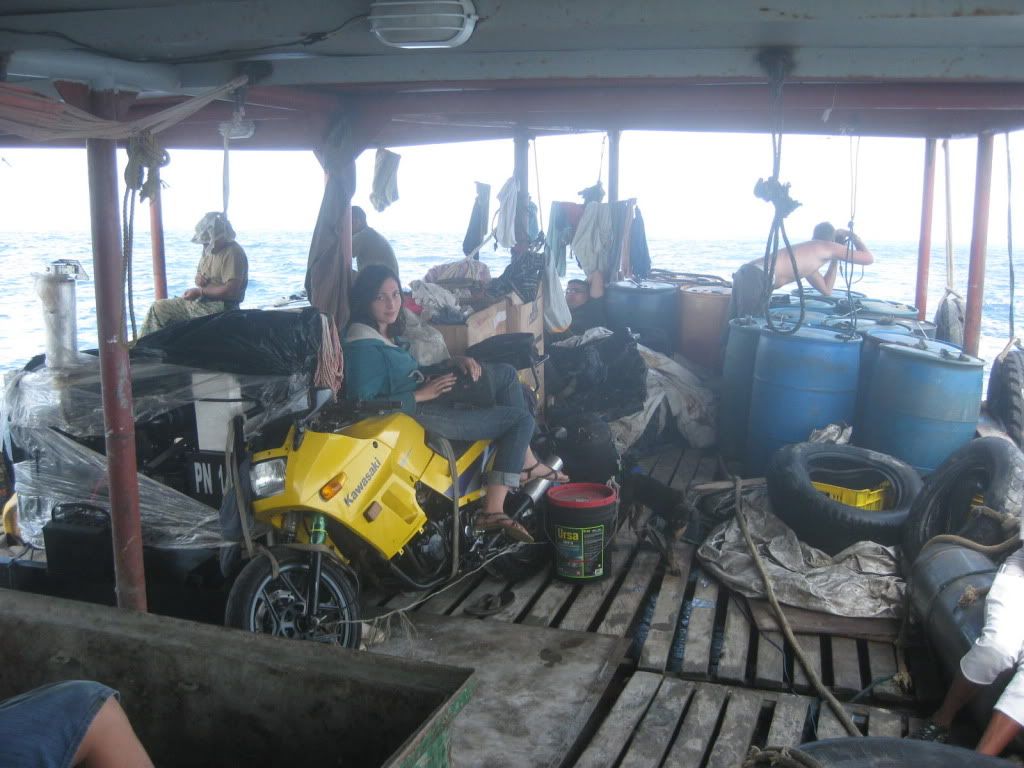
Sleeping against the bike.

The islands, ranged from tiny single-house islands to small, crowded islands of several hundred.

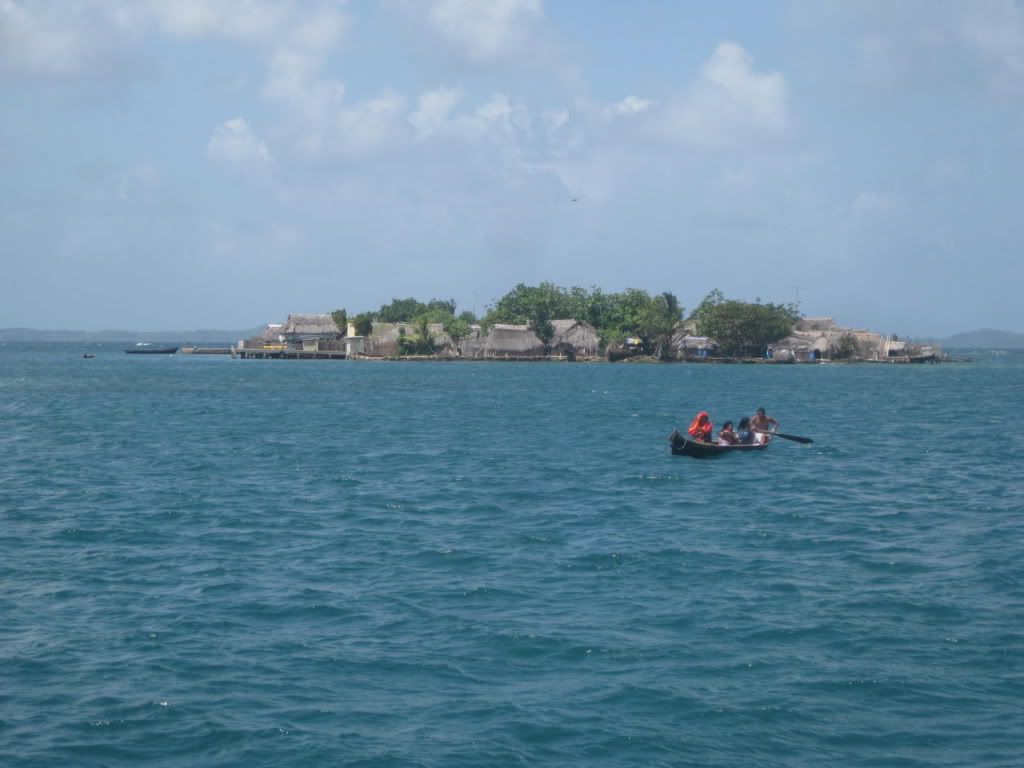
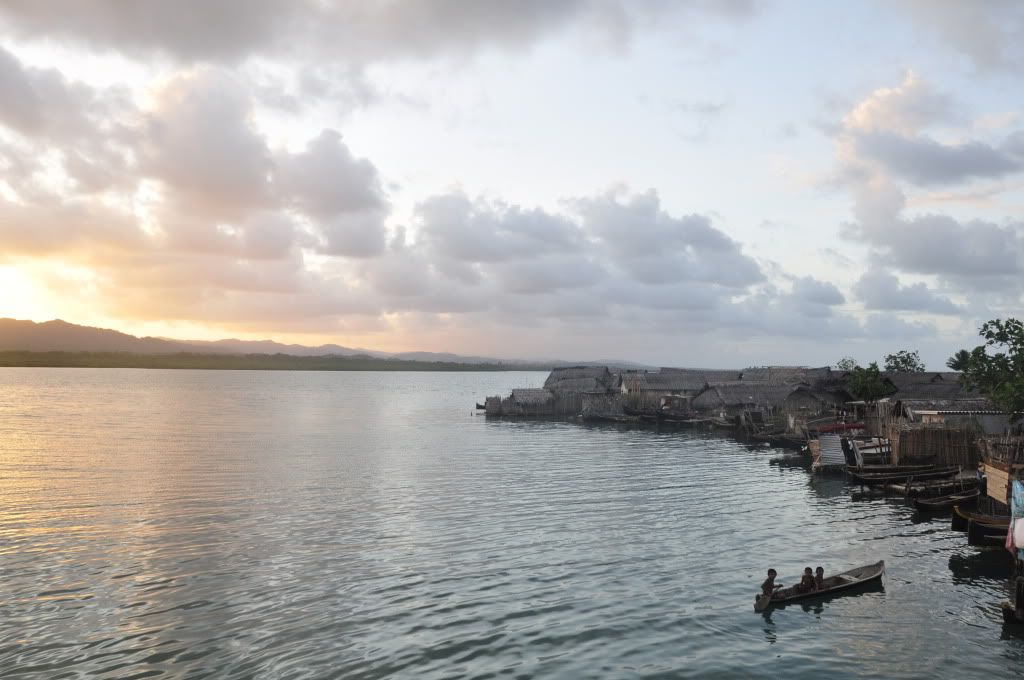
(Photo: Marshal Chupa)
The streets of a Kuna village:
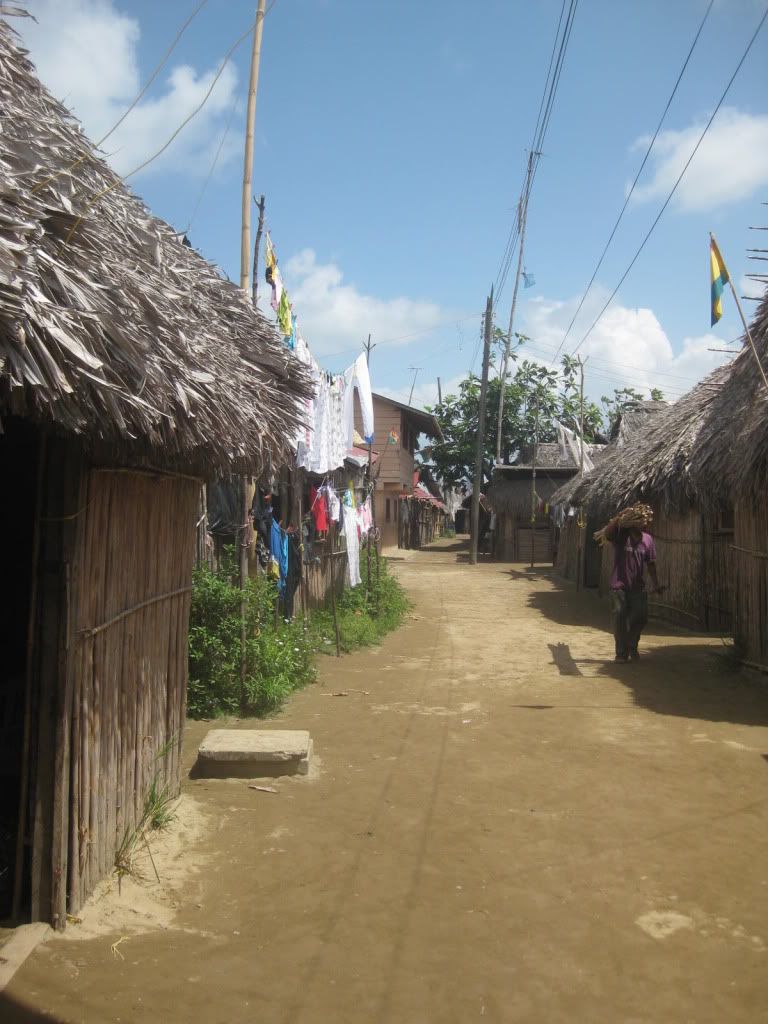
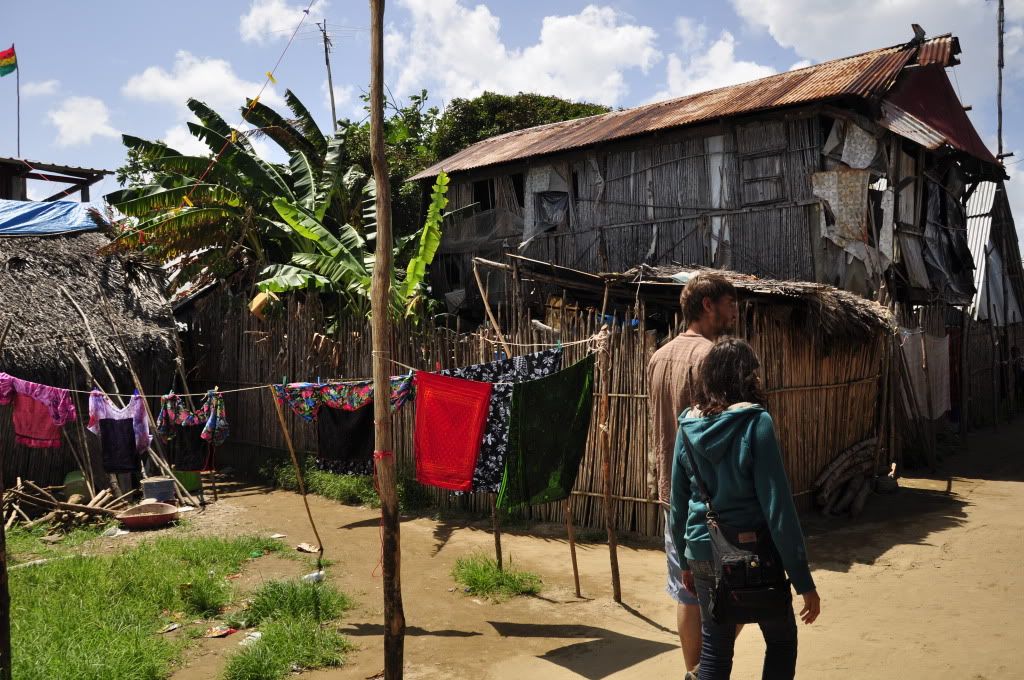
(Photo by Marshal Chupa)
Delivering supplies and people:
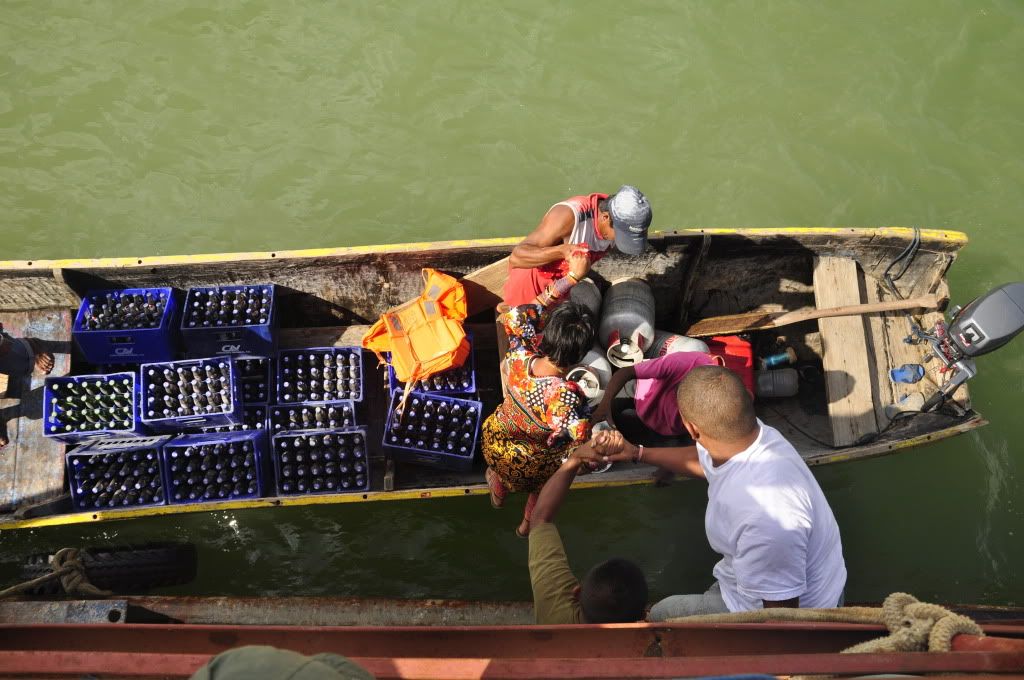
(Photo by Marshal Chupa)
To deliver fuel they throw the barrels off the side and the Kuna swim to shore pushing them:

Catching baracuda for dinner off the side of the boat:

(Photo Marshal Chupa)
Food was included on the trip, and it was delicious but a little sparse. We ate what the crew ate, unfortunately the crew was made up mostly of Kuna Yala, who are small and who must not have very large appetites, because I was constantly starving. Each island we stopped at I would search for bread to suppliment my diet.
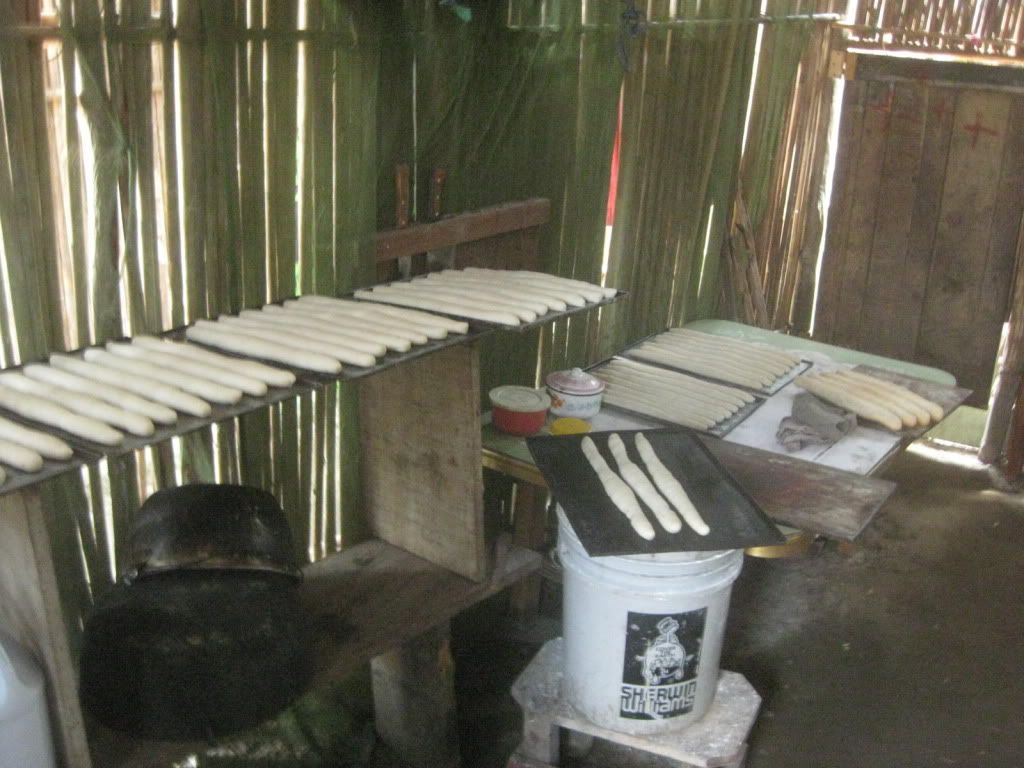
Ronald, the Colombian friend we met on the way. He has invited us to stay with him in Bogota.

At night the crew strings up hammocks everywhere. We slept in sleeping bags on the deck, but Mark, that lucky dog, brought his hammock from Canada.

I actually have the exact same hammock at home, but there was sadly no room for it on this trip.
Once we got to Puerto Obaldia the Colombia-bound passengers disembarked and stamped out of Panama. No cost, just a single copy of your passport. We returned to the boat and the captain had called a lancha over to take us to Capurgana, the little port town on the Colombian side where we could stamp our passports in (but not the bike, needed to go to turbo for that). The 1/2 hour lancha from Puerto Obaldia to Capurgana was $12 per person, but he wanted $70 for the bike alone! We argued him down to $70 for the bike and us, but it was still too expensive. Unfortunately we had no other choice, so we paid $70 for that leg of the trip.
It was no easy feat to move the bike from the deck of the ship to the little lancha in open water. It was raining and the sea was not calm. A tense minute later and we had the bike loaded on it's side in the bottom of the lancha. The sea was rough and I could do nothing but watch as the bike bounced around on it's side. More bike abuse.

We made it, and Mark helps me lift the bike onto the dock.
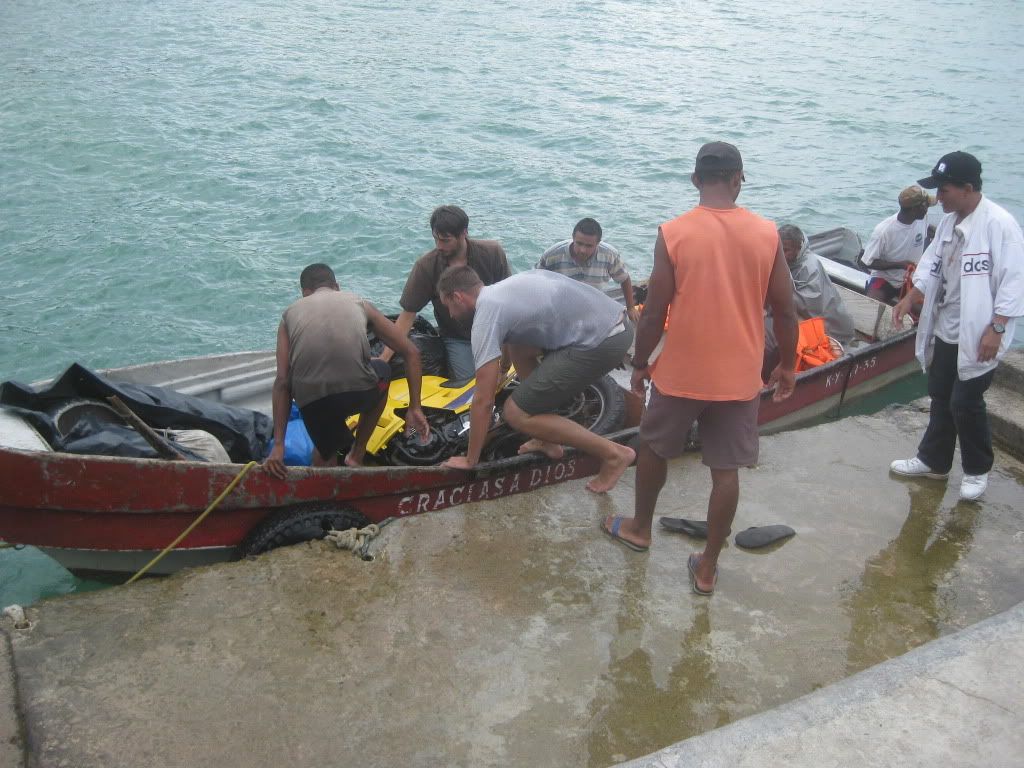
There is no electricty till 6pm, so the passport office is closed. We explore the town and try to find a good rate of exchange for our dollars. The best we can find is 1800 to the dollar (ATM rate, 1890). Thanks to the pointless Porvenir trip, the delayed ship departure and the expensive lancha ride, me and Michelle are now dangerously low on money, having only the equivalent of $100us to get us to Turbo. We get our passports stamped (free!) and wait till tomorrow morning, when the next lancha comes.
We stay in El Lutivo hotel. For $5pp. I know we should be saving money, but we havn't showered in 6 days and things are getting desperate. This hotel is very nice, they have free coffee, and I could pull the bike into the courtyard for the night.
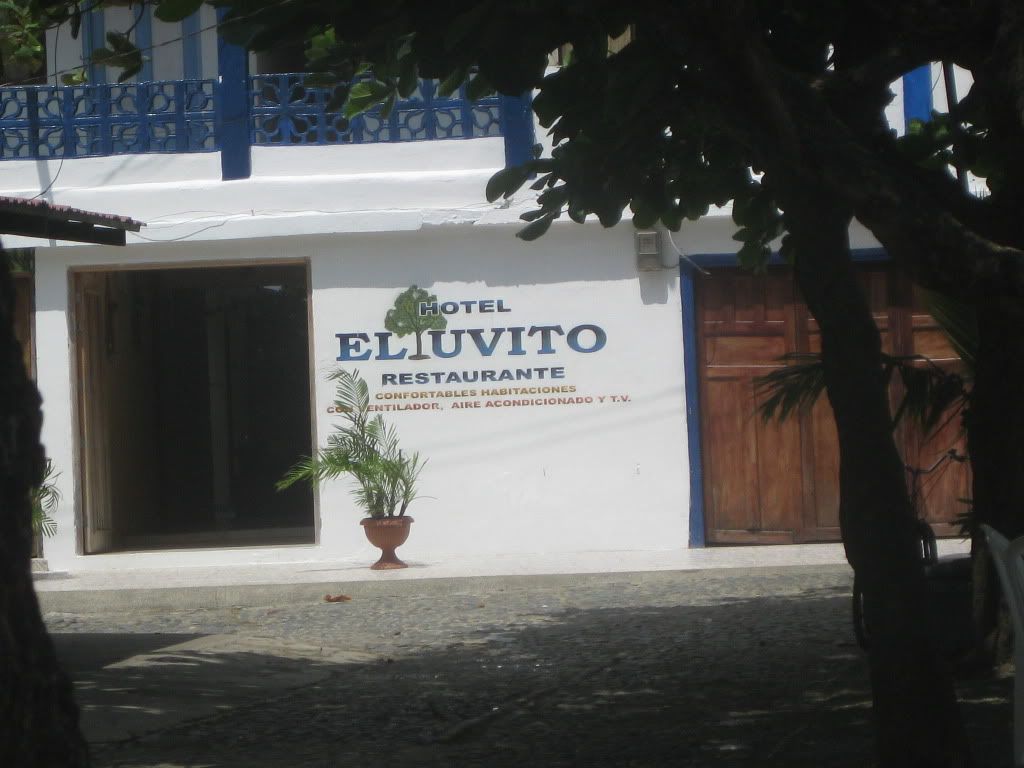
We have a pretty big crew of people by this point, and for the first time Michelle and I are not travelling alone. We began to miss it. It was us, Mark the Canadian, Ronald the Colombian, an older Colombian man and a crazy Argentinian backpacker who had snuck onto the boat off one of the islands and had 3 dollars to his name. Ronald and Mark were awesome. The other two were driving Michelle crazy. The older Colombian was far too talkative and would interfere when Michelle was trying to negotiate. The Argentinian was insane, dead broke and was relying on everyone else to feed him and get him across. Michelle and me were low on money too, and we had barely enough food for ourselves. Everyone pitched in what little they had that night, but it was Ronald that ended up giving his large supply of canned food to feed everyone. Michelle and Ronald spent the evening trying to help the Colombian sell his camping equipment so he could afford the voyage to Turbo, where he could wire for money from his parents.
The next morning the lancha ticket office told Michelle that it would be $300,000 pesos to take the bike across, plus $50,000 for each one of us. That comes to about $220us, which was ridiculous. We weren't leaving on that lancha, even if we had that kind of money we wouldn't throw it away like that. We would be waiting for something else.
We bid our friends goodbye.
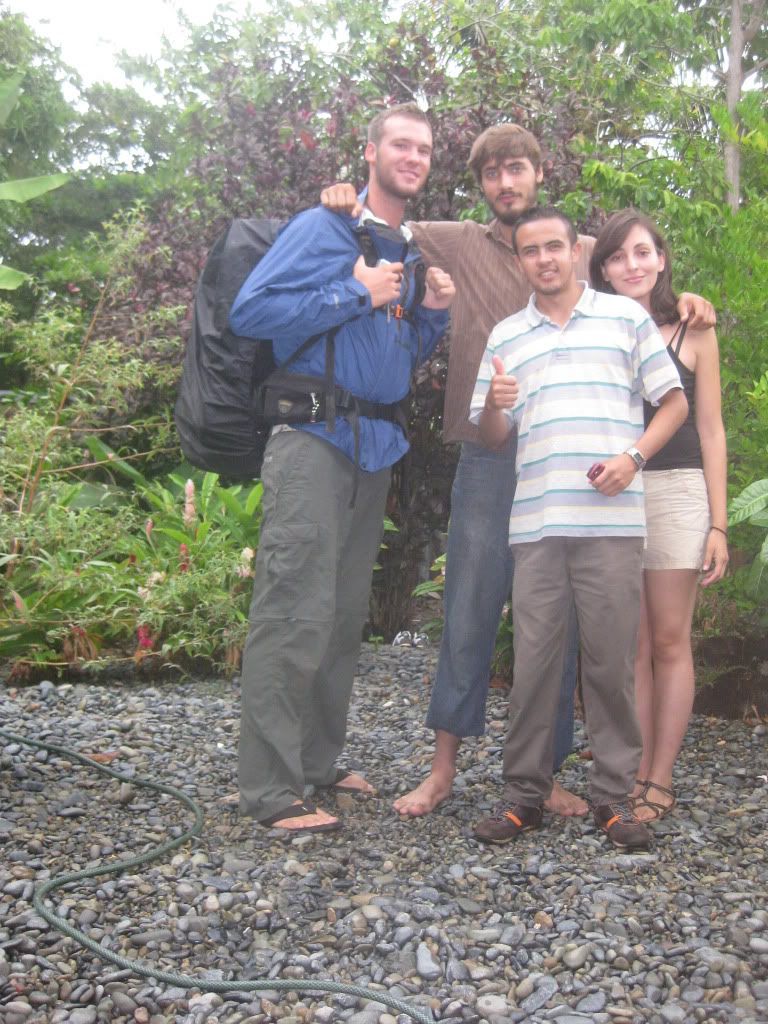
The Argentinian had managed to sell enough of his stuff to afford the ticket, so we were all alone once again. It felt good, but we were in a tough spot. There was talk of a turbo-bound cargo boat stopping later that day, and one the next day, but nothing definite. We had precious little money, and every peso we spent would be another peso we could not bargain to the boat with. Furthermore it is illegal for a cargo boat to take passengers in Colombia, so there was no guarantee we could even find one. We were both starving, but food was very expensive in this town. We bought bread and sardines and waited.

Later we learned that the cargo boat coming arriving that day wouldn't depart for another 4 days. The boat coming in the morning, "El Pipe", was our best hope. We camped on the seafront that night, enjoying another meal of bread and sardines.
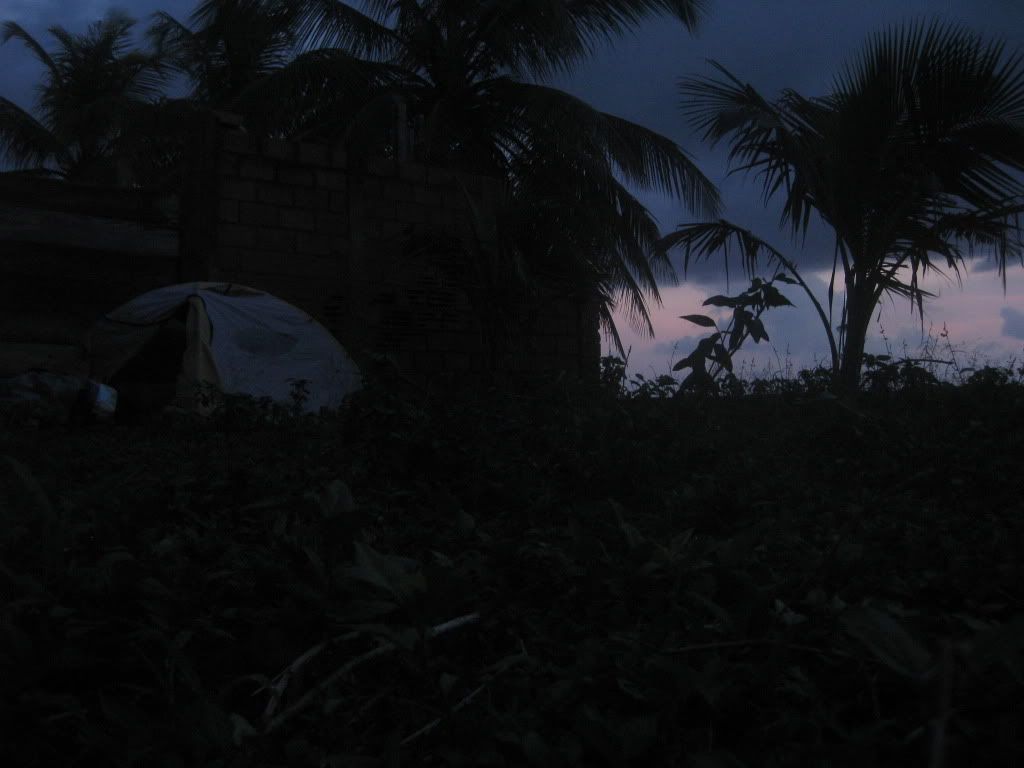
We woke up at 5:30am the next day and resumed our sitting by the dock. At 7am the boat came. I stayed out of sight and Michelle, who is often mistaken for Colombian, went to get a price. I held my breath as she walked back, desperately trying to read her face... They accepted! $170,000 pesos for us and the bike! I felt a rush of relief. They loaded the bike on with the big dock using a board as a ramp, making it the easiest load yet.

The bike was actually sheltered and

We had to wait a few more hours for the boat to finish loading. We departed at noon, but first we had to go to Sapzurro, to pick up more cargo. The cook fed us lunch, a hearty meal of beans, rice and beef. Amazing after being famished for so long.
Sapzurro:
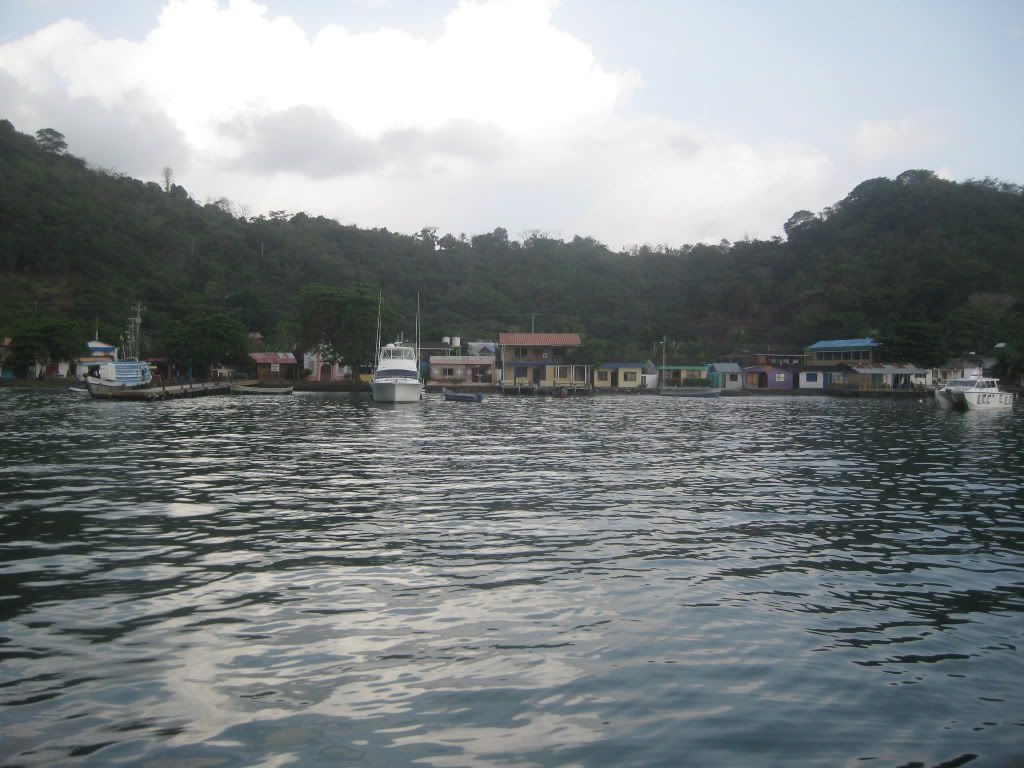
We got to Sapzurro quickly, but soon learned that a shipment of coconuts was late, so we would not be departing for Turbo until the morning. Oh well, another day of lazing around port towns. We took a hike around Sapzurro.
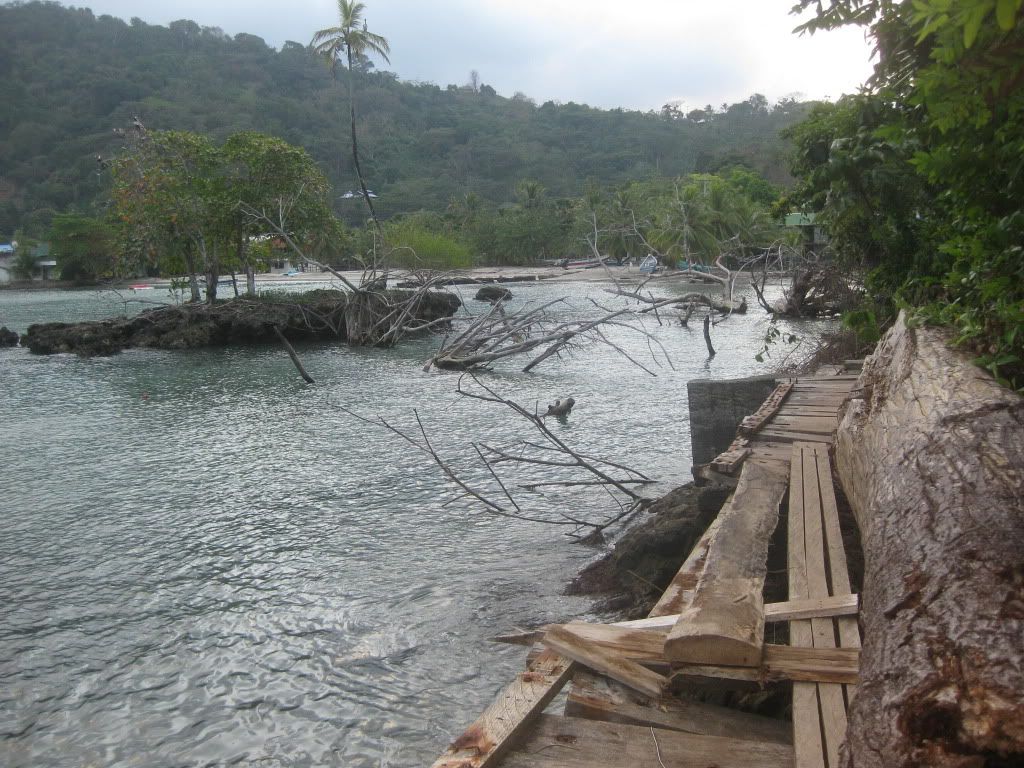
I was hungry and spent 20 minutes opening a coconut using only a pocketknife.

We ate dinner on the boat, a delicious colombian style Sancocho with beef and plantains that somehow tasted exactly like potatos. We camped another night.
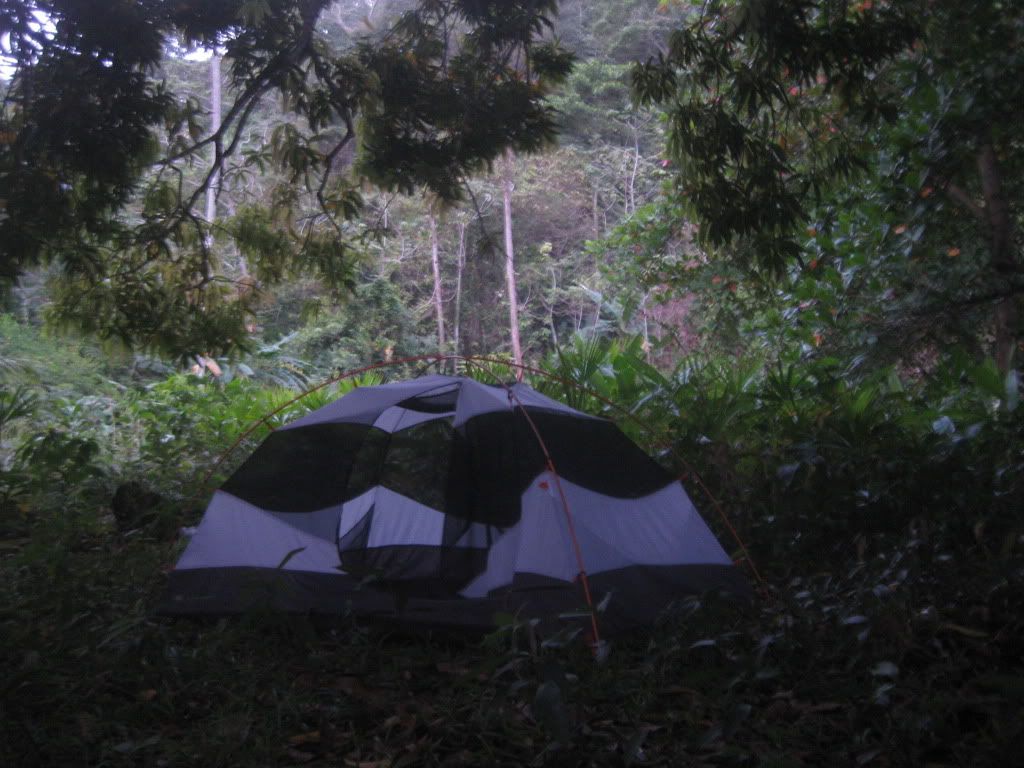
Early next morning the coconuts arrived and we were soon loaded up and on our way to turbo! By lancha this trip is two hours, but on our slow cargo boat it was more like 6. The cook fed us breakfast and lunch, both full of yucca and plantain. The food was heavy and it felt so good to be full again.
At about 2:00pm we were instructed to get out of sight incase a military boat should spot us (passengers being illegal on cargo boats). At 2:30, we had arrived in turbo.

They park the boat on the side of the canal, we quickly throw our stuff overboard and roll the bike onto dry land again. The entire process, from arriving to Colon trying to find a boat, to disembarking in Turbo, 100 miles away, took 14 days and cost $460 for two people and the bike. The bike came out surprisingly well considering the abuse. A fair amount of rusting (exhaust especially) and a few new paint blemishes, throttle and clutch feel a little loose, but nothing major. I cranked her for a few seconds and she sprung to life.
It is done, we are in COLOMBIA!
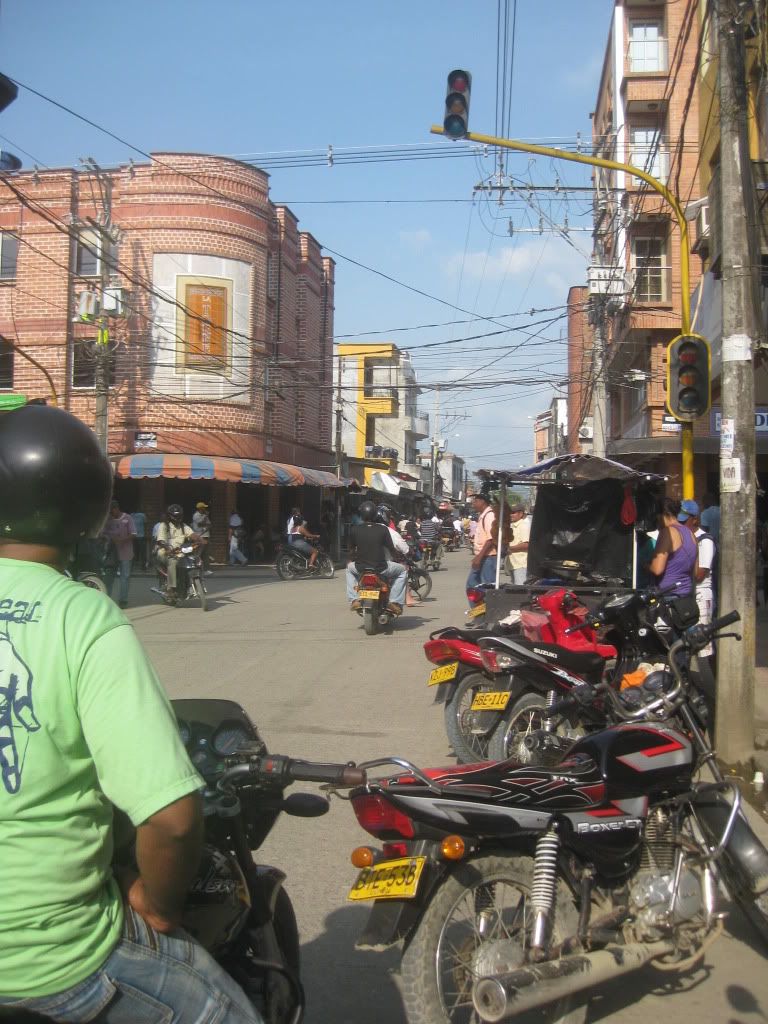
|

13 Mar 2011
|
|
Registered Users
Veteran HUBBer
|
|
Join Date: Jun 2009
Location: Ottawa
Posts: 100
|
|
|
Interesting ride report. Enjoyed the pictures and stories.
Confirms what I keep saying to people, "You don't need a big bike to go touring"
I think you will find that things get better from Colombia onwards.
I am headed down to Colombia my self this summer for a few weeks of motorcycling adventure.
Cheers
Ride4Adventure
|

23 Mar 2011
|
|
Registered Users
Veteran HUBBer
|
|
Join Date: Oct 2010
Location: Krasnoyarsk, Russia
Posts: 216
|
|
|
Colombia part 1
Turbo 3/3/11

Colombia Coca-Cola, 2007
Antonio Caro
Museum of Modern Art, Medellin
We reached Turbo dirty, broke, with no idea where to go and a rusty motorcycle without a permit. Very happy to be on the mainland finally.

First thing I noticed when getting off in Turbo was the motorcycles. 9 out of 10 vehicles is a motorcycle, most being 100cc 2 strokes or 125cc 4 strokes.
We had several things to do.
1. Find an ATM. Easy. Rate was about 1900 Colombian pesos to the dollar.
2. Find a hotel. "Hotel Good Nigth" (no typo) fit the bill, for 20,000 pesos.
3. Wash the salt off the bike. There was a "parquedero de motos" (parking place for motorcycles) across the street, which had water and I washed it there.
4. Get a bike permit. The friendliness of the Colombian people really came to light at this point. Buisness owners volunteered to watch the motorcycle. Police were friendly and helpful, apparently not perturbed by the fact that we were riding an illegal motorcycle. Buerecrats made phonecalls for us. Eventually we found out we needed to go to the DIAN office, that was located on the military base on the beach. Sometime in the past I remember reading that Colombians customs were very difficult and could take weeks. Not sure where I heard that, but Colombian customs were a breeze. In and out 5 minutes, very simple paperwork. Plus, it cost nothing.
Turbo is one of two big port town destinations on the North side of Colombia. If you take the cheap route across the Darien Gap, you will probably end up at Turbo. If you take a nice sailboat cruise, you will end up at Cartegena. Cartegena is famous for Colonial Architecture and tourism. Boring! Turbo is famous for being dirty and dangerous. Give me Turbo any day.
We spent two days in Turbo doing some busy work. Getting the stitches out of Michelle's head, updating the blogs, getting the motorcycle permit, things of that nature.
We began the road to Medellin, which brings me to the next thing I noticed about Colombia. Incredible variety of scenery. A few hours ride in any direction and you will be in a completely different climate. Beaches, amazonian jungle, Andes mountains, desert. You have it all in Colombia.
The route to Medellin is a rough one. Takes 8 to 12 hours. There are frequent closures due to landslides, protests or Guerilla action. Luckily it was open when we were coming down.
Colombian security is much improved over the past few years, but there are still signs of unrest. On the radio a few days earlier we heard that the Guerilla had burned four cars. Sure enough, we saw all four of the scars on the road.

Crazy scenery. Dense jungle to the Andes mountains in a few hours.

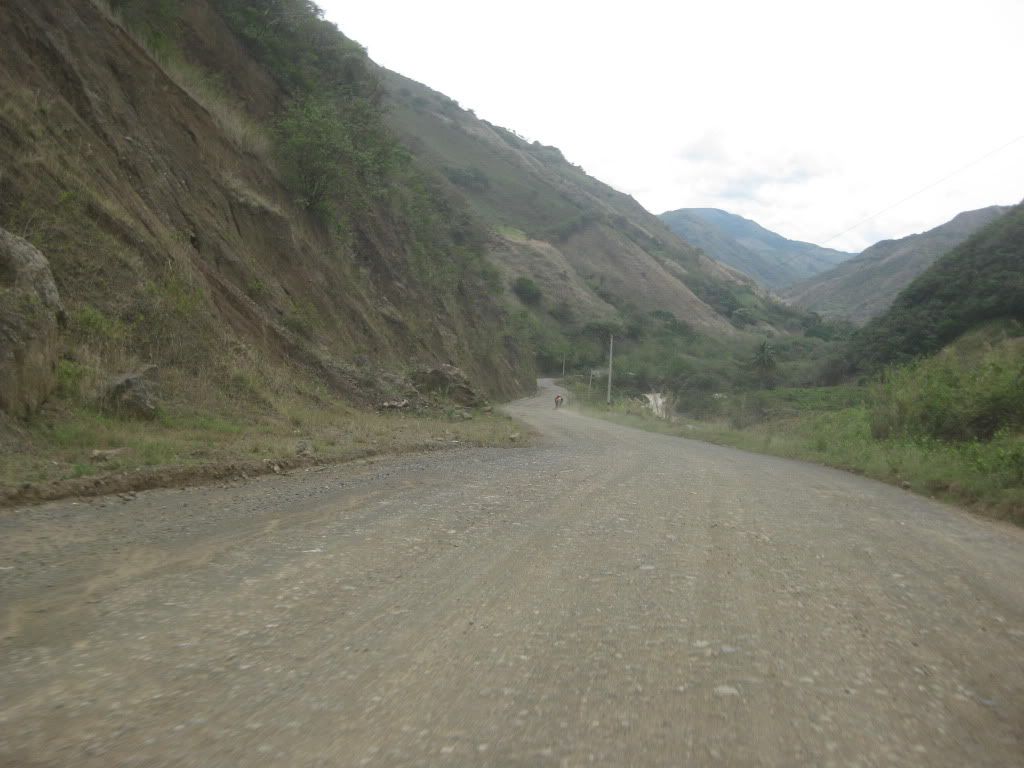
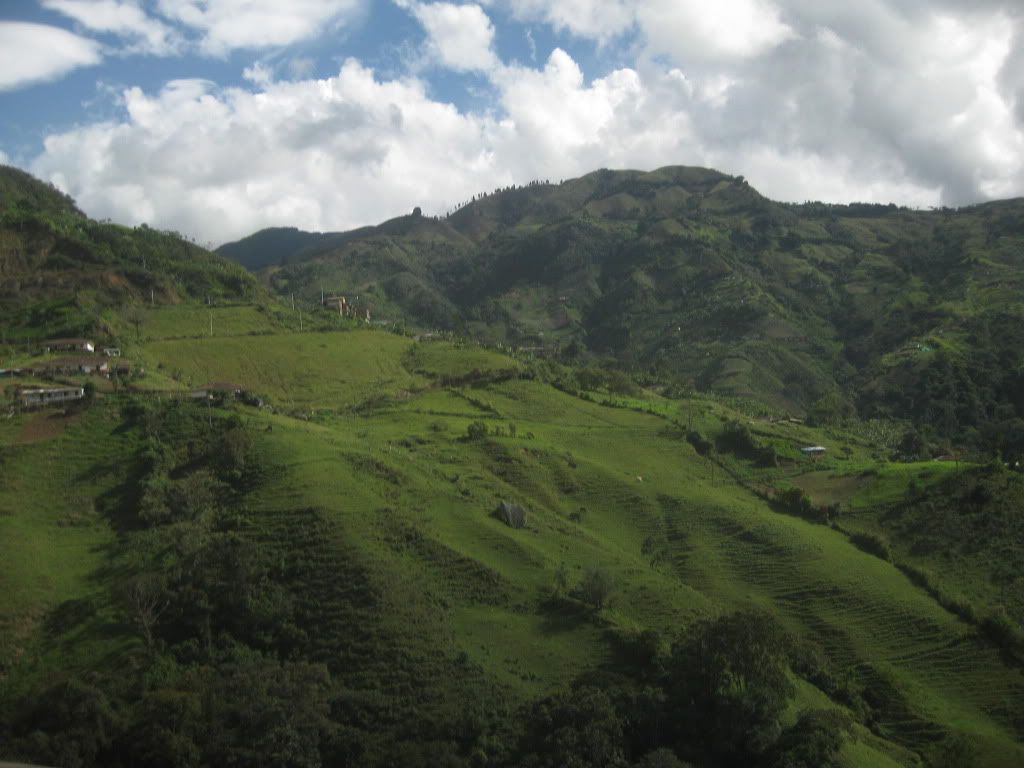
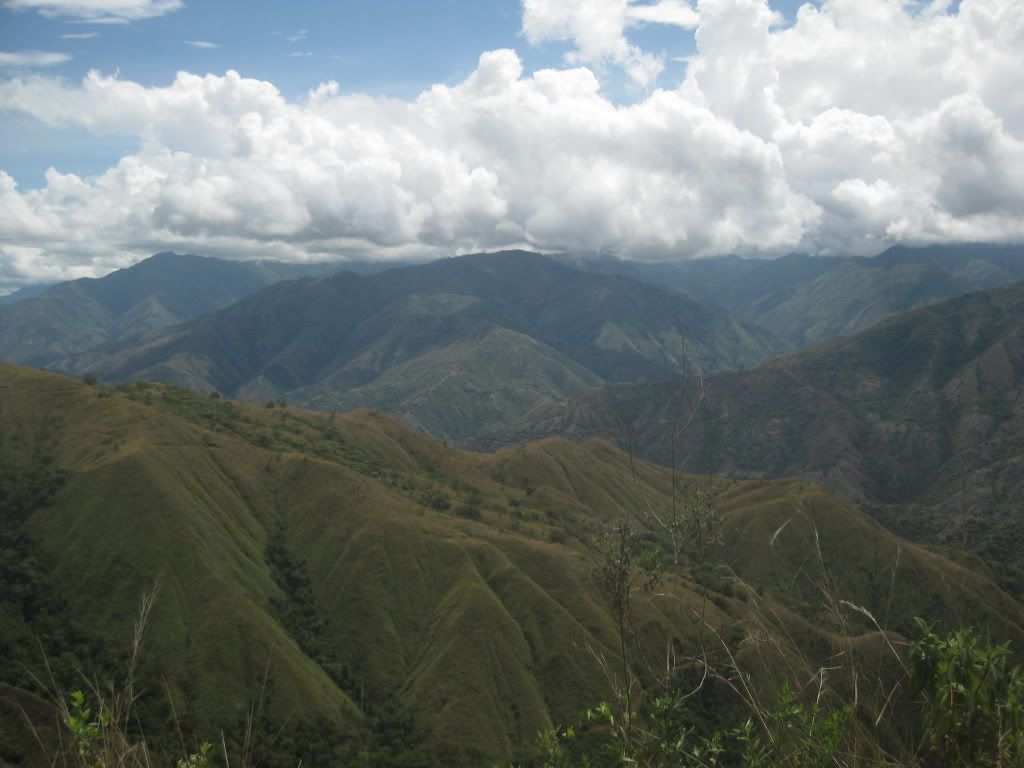
And of course the road itself was amusing too.

We stopped at a small roadside fruit stand for some Avocados to supplement our lunch. "How much for these two?" "Oh just take them, their a gift." Things like this would be common in Colombia. Latin America is generally an incredibly friendly place, but Colombia stands out.
Slept in the small town of Debeina for the night. Lovely little hotel for $6us. Clean, small, cool. I recommend it.

As I unpacked I realized that sometime during the process of packing up to leave Turbo I lost the tailbag with all my tools and spares. We called the hotel but no luck. I felt completely naked without a set of tools with me. This would have to be fixed soon.
Medellin 3/6/11
Next day we arrived in Medellin. I will never forget coming around the corner and seeing Medellin for the first time. Surrounded on all sides by the towering Andes mountains, Medellin's red brike houses overflow onto the mountain sides. Skyscrapers shoot up from the center, almost as high as the small mountain that sticks up from the center of the city. We were moving too fast to take any good pictures, but here's a shot anyway.
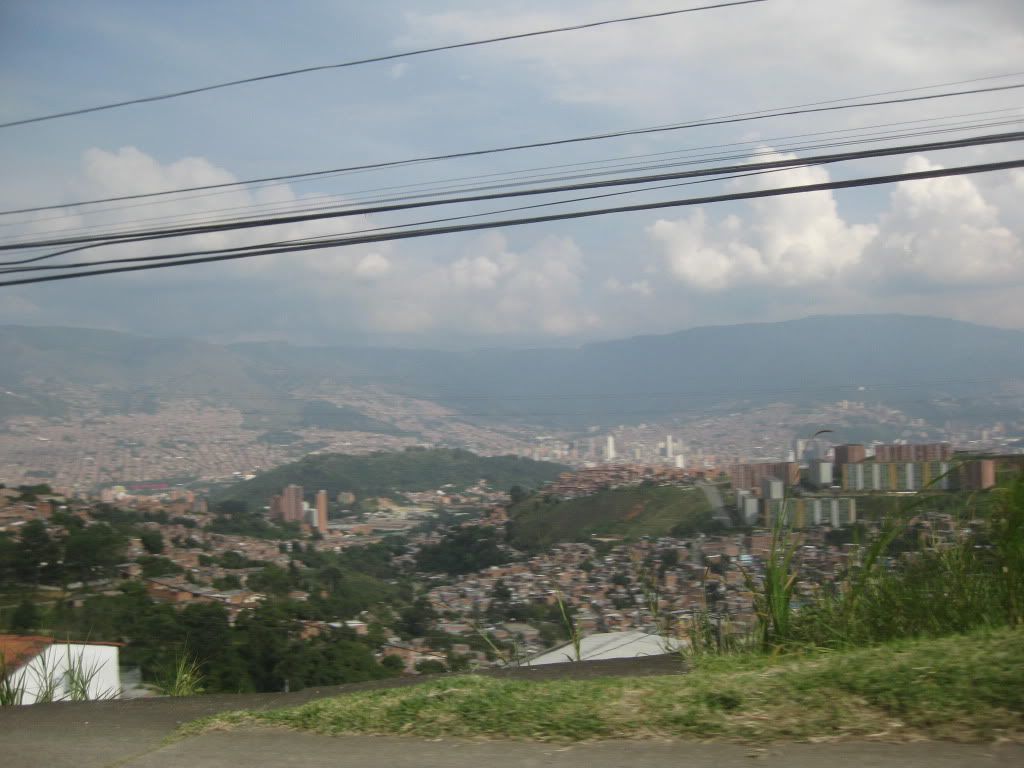
Again, tons of motorcycles.
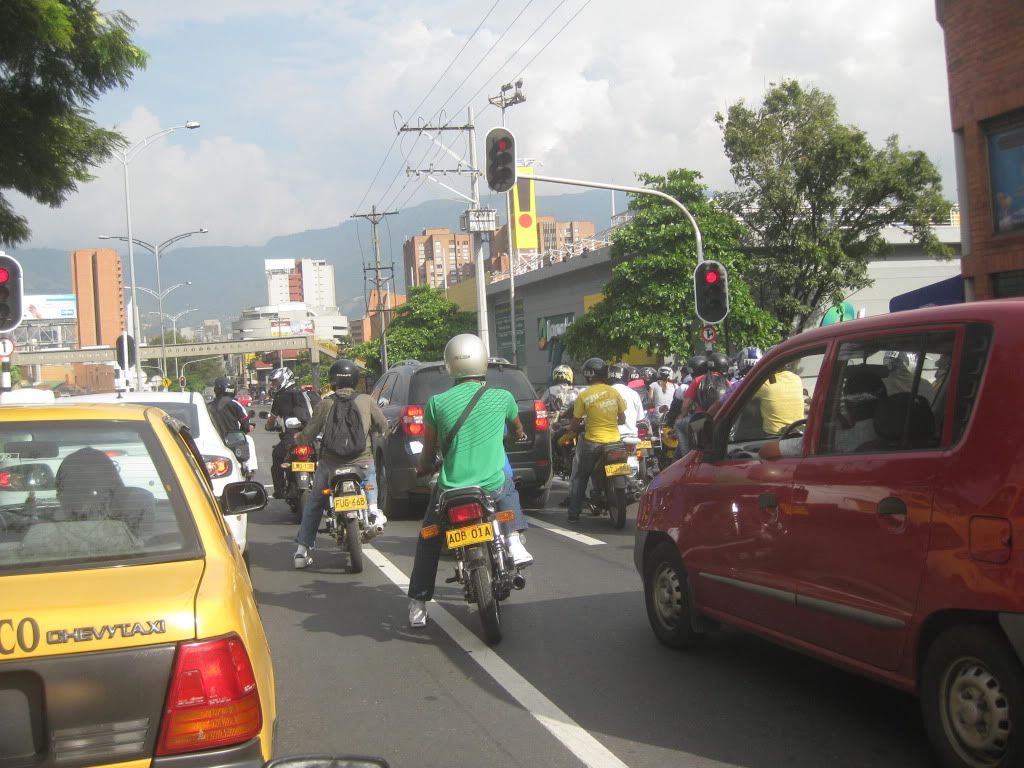
You may remember we repaired a flat front tire in Guatemala. We had unsuccesfully been search through 7 countries of a correct 100/90/16 tire. Well after we had patched the tire for the third time on the way to Medellin I decided it was time to stop being picky. We stopped at the first tire shop as we entered Medellin and they quickly located a 110/90/16 tire. Close enough right? Once they had mounted it I realized what a monster it was. Big dirt tire. I love the look, but the low speed handling did suffer.
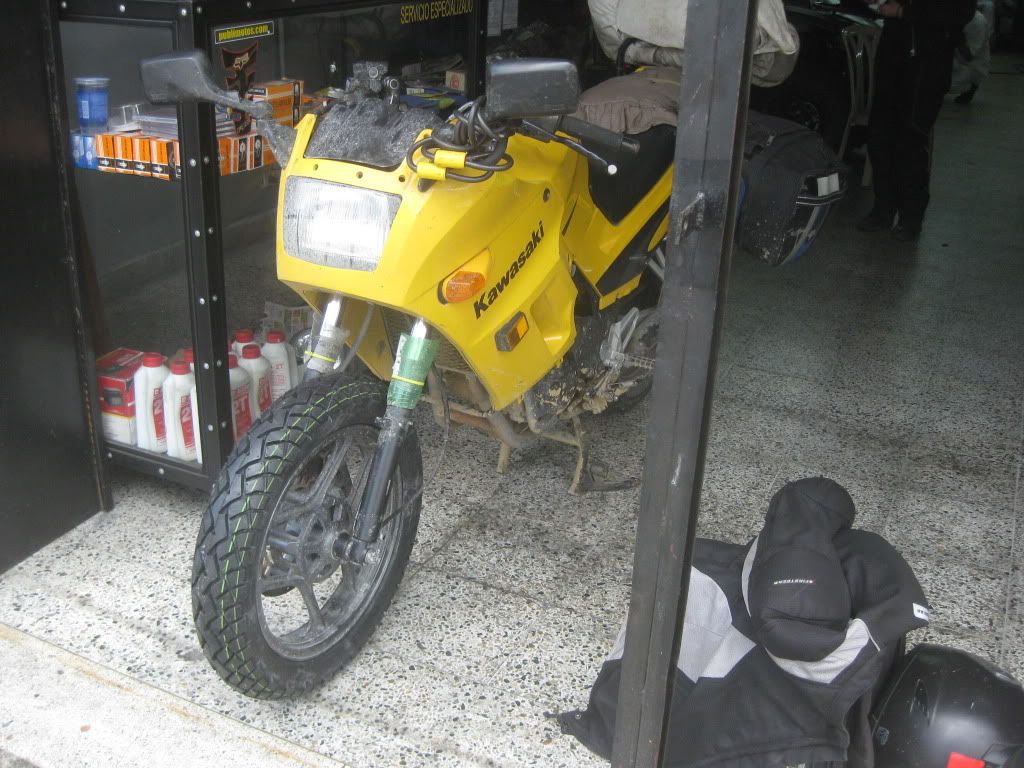
$43 installed. Random China tire.
Medellin is the former capital of Colombia, and it's home to almost 4 million people. It has an interesting reputation. Some will say it's a historic cultural center, others will talk about crime and prostitution. Definitely both of these things. Theaters, museums and history combined with the grime, characters and convenience of the big city. Definitely my favorite city of the trip so far.
No shortage of cheap love hotels. We stayed in "El Encuentro" for $6us per night. Tiny room, but it had a private bath, cable TV and an ipod-ready stereo system. The downside was the other guests. Some nights we were kept up by two rooms battling to see who could turn the stereo up the loudest, other nights it would be somebody jamming out on the bongos, sometimes it would be a nosiy client with his prostitute. Ah, the memories.
We did the touristy thing, checked out the museums of modern art and the Botero plaza.
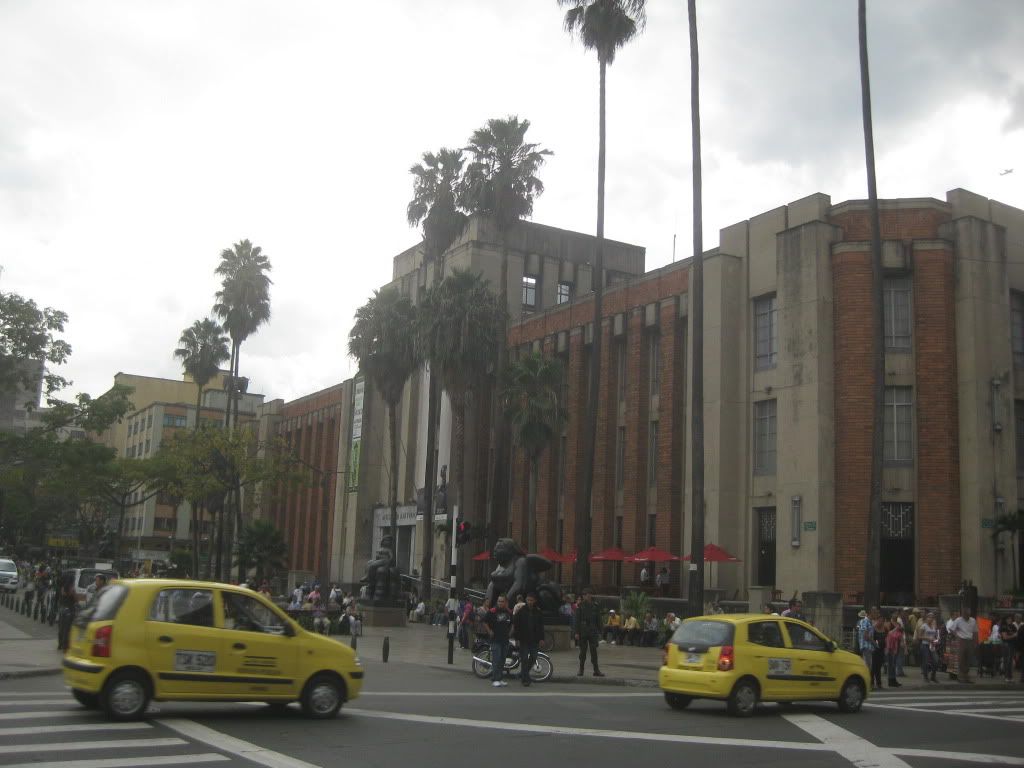
Fernando Botero is probably the most well knwon Colombian artist, famous for his "volumous" interpretations of people and things. Medellin's contemporary art museum had a whole floor dedicated to him, and the plaza outside had huge Botero statues.

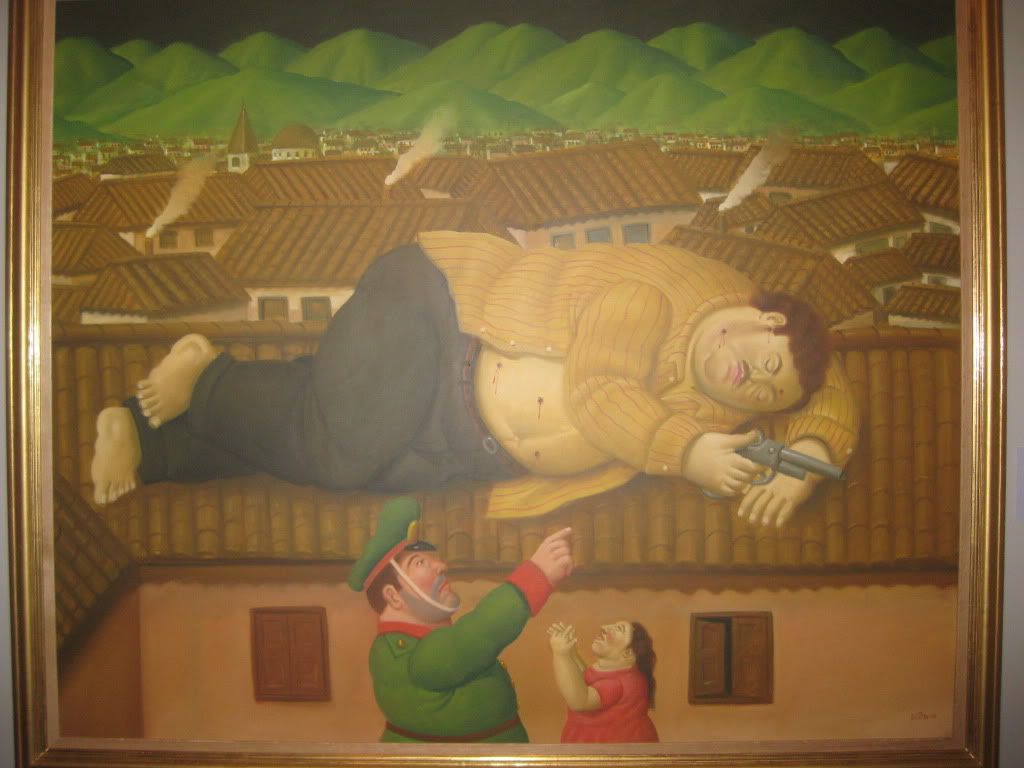
"Pablo Escobar is Dead"
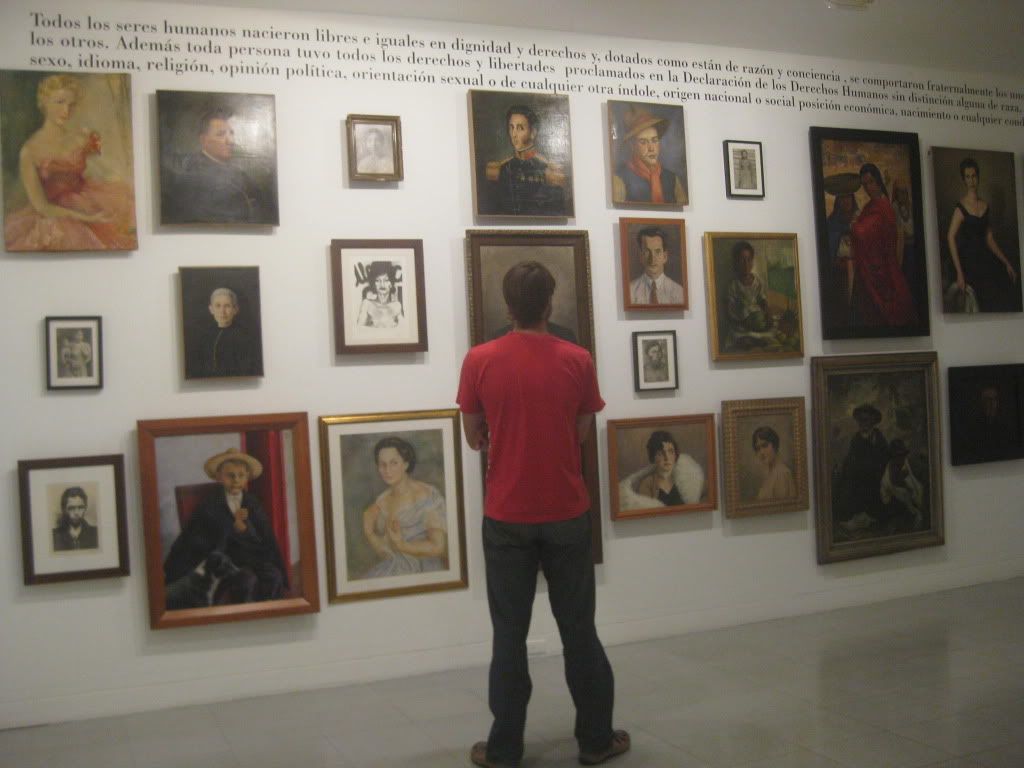
With the Botero Statues;
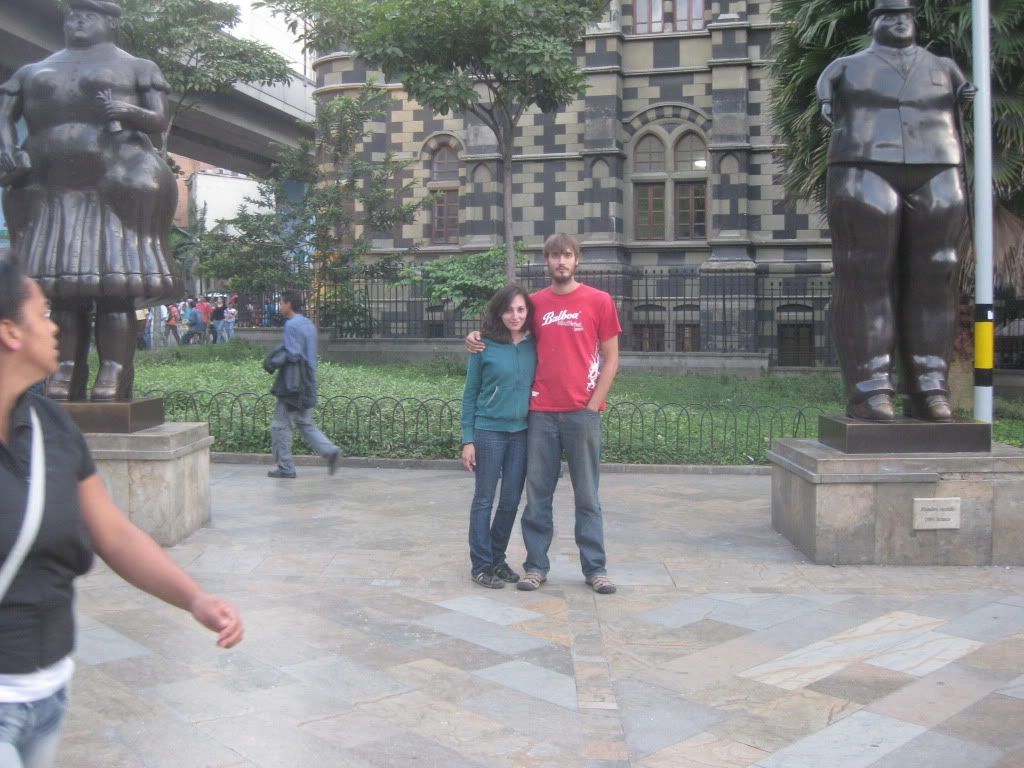
Cool plaza.
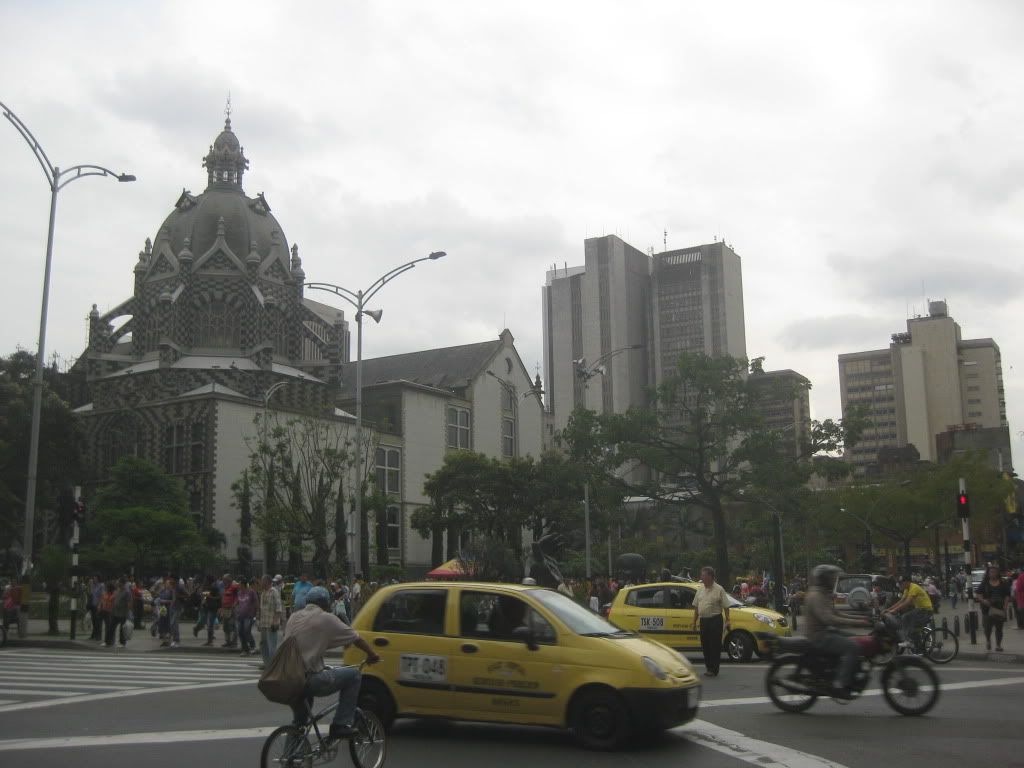
Lots of little theaters around Medellin, doing performance and film. One night we went to a theater doing a performance of Synthia Plath´s (the poet) life. $5us for students, comes with a  and coffee. Live music, incredible actors and actresses. Very cool.

The food in Medellin is great. You can get a delicious dinner on the street for $3000 pesos ($US 1.60).

Also tried Arepas. Similar to the pupusas of El Salvador. Arepa de Chocolo (left) is made with a sweet corn dough and topped with white cheese and butter. The Arepa de Quesito is made from a lighter dough (rice?), filled with cheese and topped with lecherita (condensed milk cream stuff). Incredibly delicious, incredibly bad for you. A must try.
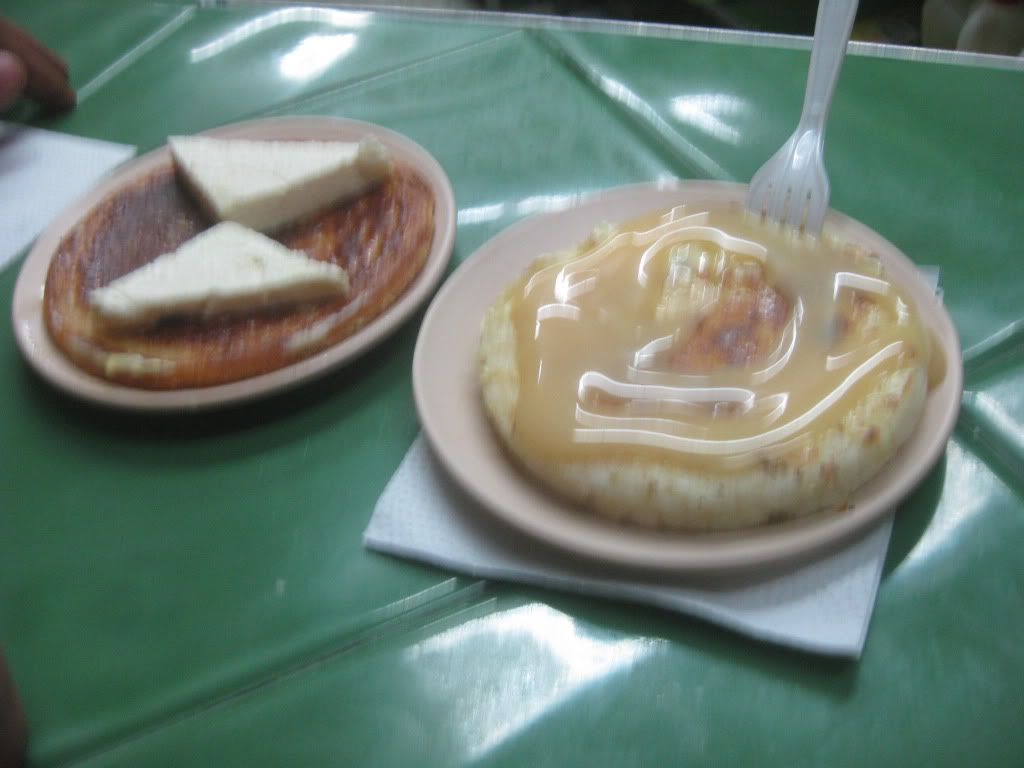
The last night in Medellin was a Saturday night. Apparently all the hotels increase their prices, and we couldn't justify $20,000 for our current hotel so we searched for something cheaper. We found a little green door downtown, and inside was the equivelent of a tenement house. Big space subdivided into makeshift rooms with cardboard-thin plywood. Mostly for long term rental but they offered us a room for $4.00us for the night, bike parking included. Our room was a closet with a mattress and a black and white TV with one channel. Perfect! Cheapest hotel of the trip yet.
The plan was to go to sleep early, get up at 6am and do the 8 hour drive to Medellin. Just as were about to go to sleep the kids living in the building discovered us. We spent the next four hours chatting and entertaining them. They brought us sweets, a bit of sausage, a bottlecap, their english homework and a prized 12" LP record (Golazos Del Mundial '94). Really sweet kids, very cool experience.


We got to sleep just around 2am. There goes our plans! Worth it.
|

23 Mar 2011
|
|
Registered Users
Veteran HUBBer
|
|
Join Date: Oct 2010
Location: Krasnoyarsk, Russia
Posts: 216
|
|
|
Bogota - Colombia part 2
Bogota 3/10/11
We left for Bogota at 10:30am. Going to be a long day!
Great thing about riding in Colombia: Motorcycles don't pay tolls. Every toll station has a tiny lane on the far right for motorcycles and bicycles.

Ate lunch next to a picturesque river.


After a grueling 9 hours of riding, we arrived in Bogota.

We had planned to meet with Ronald (Colombian we met on the boat, lives in Bogota), so we gave him a call once we hit the city. "Oh, you're 4 hours away. Better find a hotel!". Bogota is an ENORMOUS city. Ronald says it has 12 million people and takes 4 hours to cross by car.
We searched and searched, but Bogota is so sprawling it took forever to find anything remotely reasonable. It always seems like it's the really long days where we had this trouble. Eventually we found a place to stay for $20,000, and we collapsed into sleep.
Next day we decided to ride around Bogota to see the city. Not really a great idea. Bogota is so huge and sprawling we rode around for hours without seeing anything interesting. Just an eternal sprawling metroplex. It is very clean and cool, but reminded us too much of Houston back home.
When we were stopped at a stoplight, waiting for it to turn green, a man approaches us. "I found this screwdriver on the road, I don't need it. You have it."

Since I had just lost my toolkit a few days before I was very excited. What a nice guy. Just long enough to adjust that pesky carb calibration screw too.
We were supposed to meet Ronald that day in the Simon Bolivar plaza, so we headed that way. The plaza is very beautiful, very European, but somewhat irritating to hang out in. Every two minutes somebody will approach you asking for money or offering to sell you something.



On the plus side, there are many little vendors selling interesting Colombian treats.

It's called Obleas. Two big paper-thin wafer cookies filled with cream, lecherita, crushed peanuts, cheese and fruit. Delicious.
We waited for two hours. Apparently Ronald had missed the last bus into the center. Damn! I guess we'll be finding a hostal.
... or not. After an hour of riding around we found the historical area with all the hostals. Unfortunately in the hostals it would be $40,000 for the two of us, and this was just too expensive. We settled on a hotel 3 blocks away, for $15,000 for the both of us, private bathroom.
Next day we did a little run around to take some pictures of Bogota. It grew on me during our stay downtown. Quite a beautiful city, just too big for it's own good.
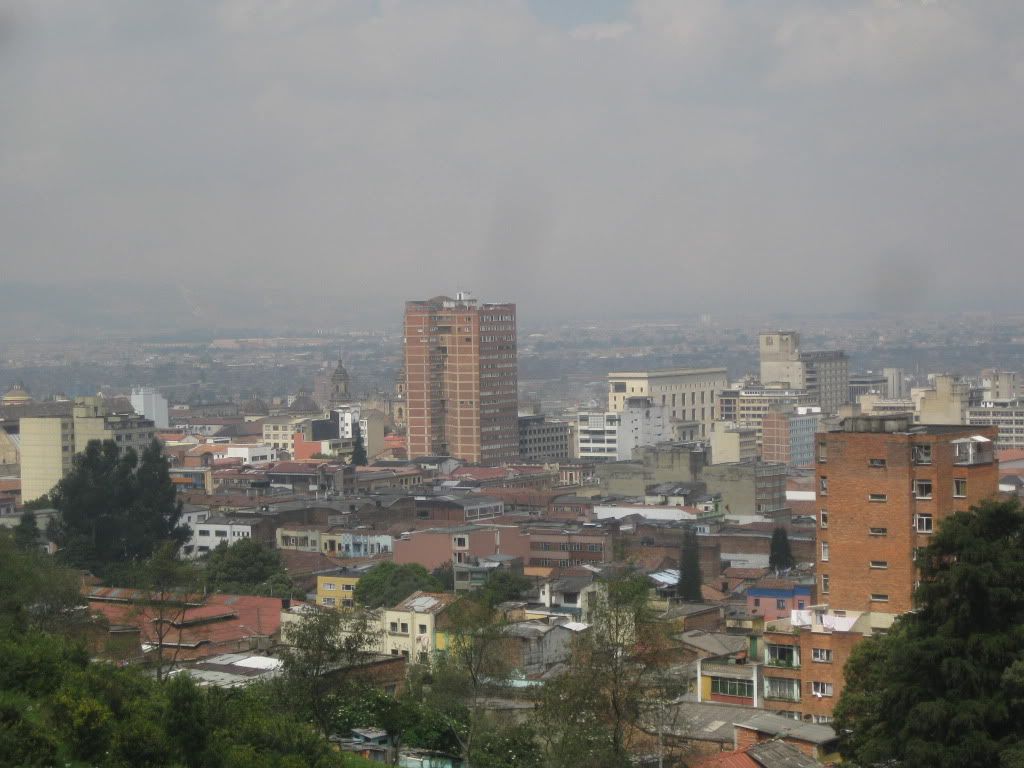

Park close to downtown:
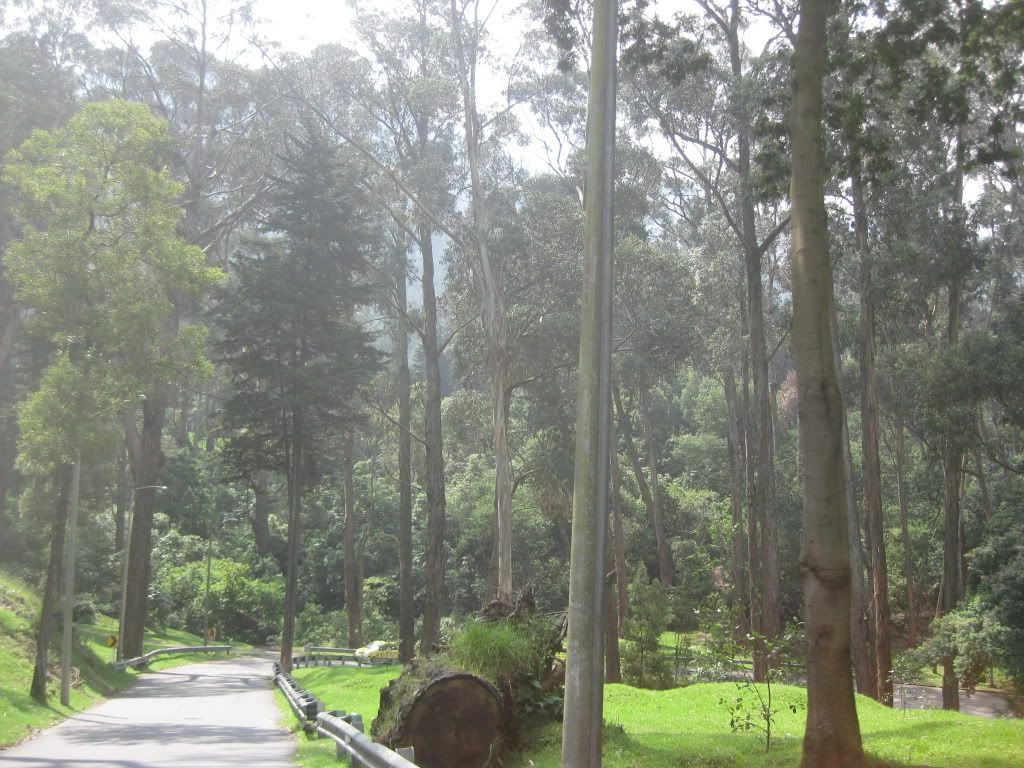
We met up with Ronald and his girlfriend and did the tourist thing. Museums!
Museum of gold:

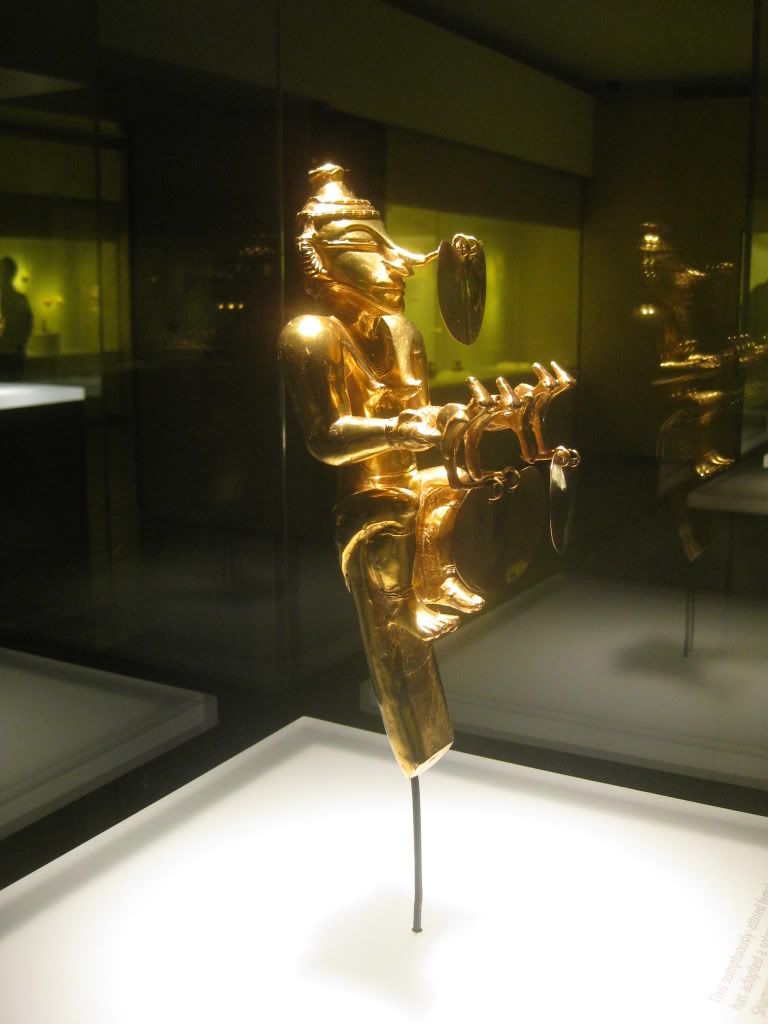
Museo de la florero (flower vase): Colombian indepence was sparked by an argument over this flower vase.

The locals asked to borrow the vase for a dinner, knowing the request would be refused, and the Spanish government official refused. The vase was broken, a fight broke out and the Colombian revolution began.
Random museum of the HJCK radio station. It's free! Why not?
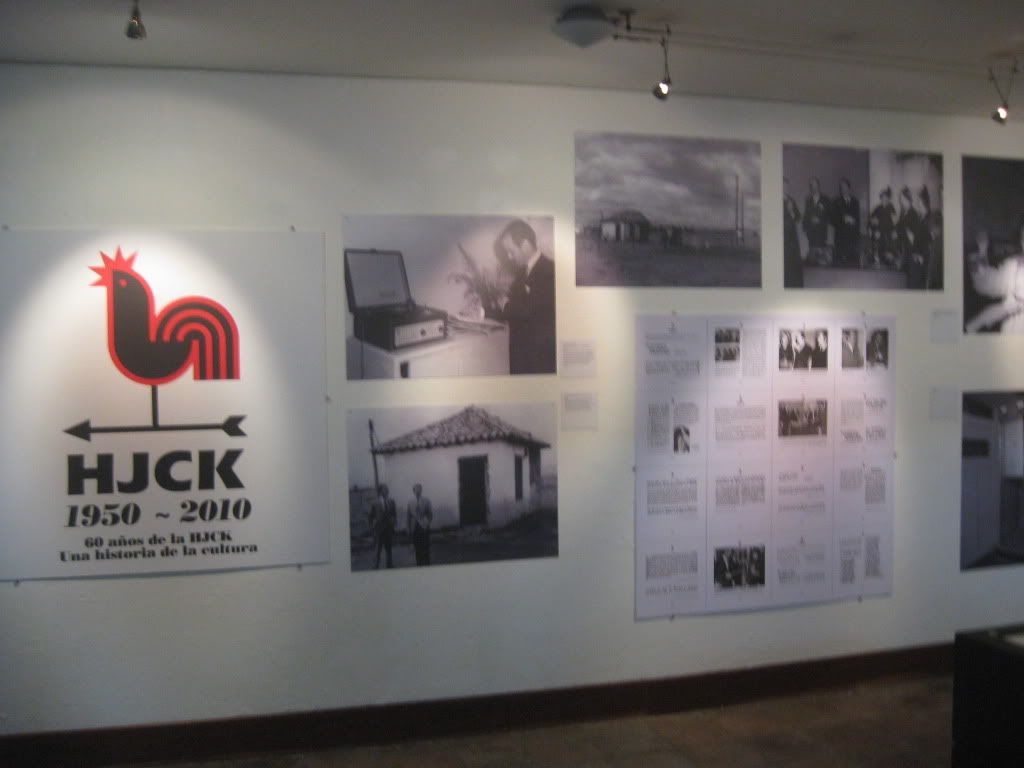

Their original record player, I love record players, I miss mine.
We could have spent days doing all the Museums in downtown Bogota. There are tons.
The ninja on the streets of Bogota:

Police motorcycle.
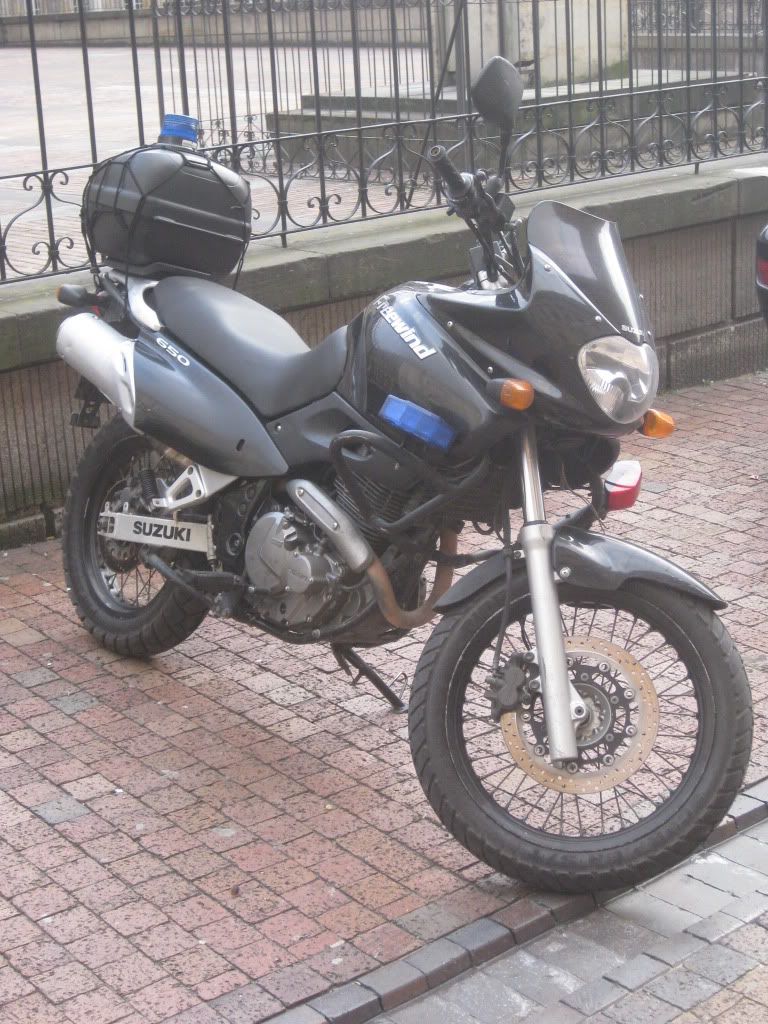
Suzuki Freewind 650. Never heard of it before, but it's a cool one. They also use DR650s and GS500e´s. I love police motorcycles down here!

I gave Ronald a ride on the motorcycle and we bid our friends goodbye.
That night we met the other hotel guests, a group of 5 Colombian military. They were all in town to collect their government disability benefits. One was missing a finger and had been shot in the leg, one had been hit by lightening while on patrol and his heart was connected to a battery on his belt. They were all our age or younger. We chatted for hours. Talked about music, culture and the guerilla. One of them showed us some pretty ghastly videos on his phone. Interesting night, but the talking lasted so long it was too late to grab any real dinner. We settled on empanadas and arepas down the street, which can be found at any time of day.
Next day we left for Cali, Colombia, the third large city of Colombia. On the way out we took a little detour to the kawasaki dealership to find an oil filter. Had to pay OEM prices, but since the filter hadn't been replaced in 3 oil changes I didn't care. Just happy to have found one. We also came across a little outdoor market with a guy selling tools, and I began to rebuild my tool kit.
Our little detour took up a good part of the day, so we didn't get very far on the road towards Cali. We spent the night in Fasafasuga, two hours away. Nice hotel for $20,000.
Bogota was high, but we'd be going even higher. Within a few hours we were in the clouds once again.
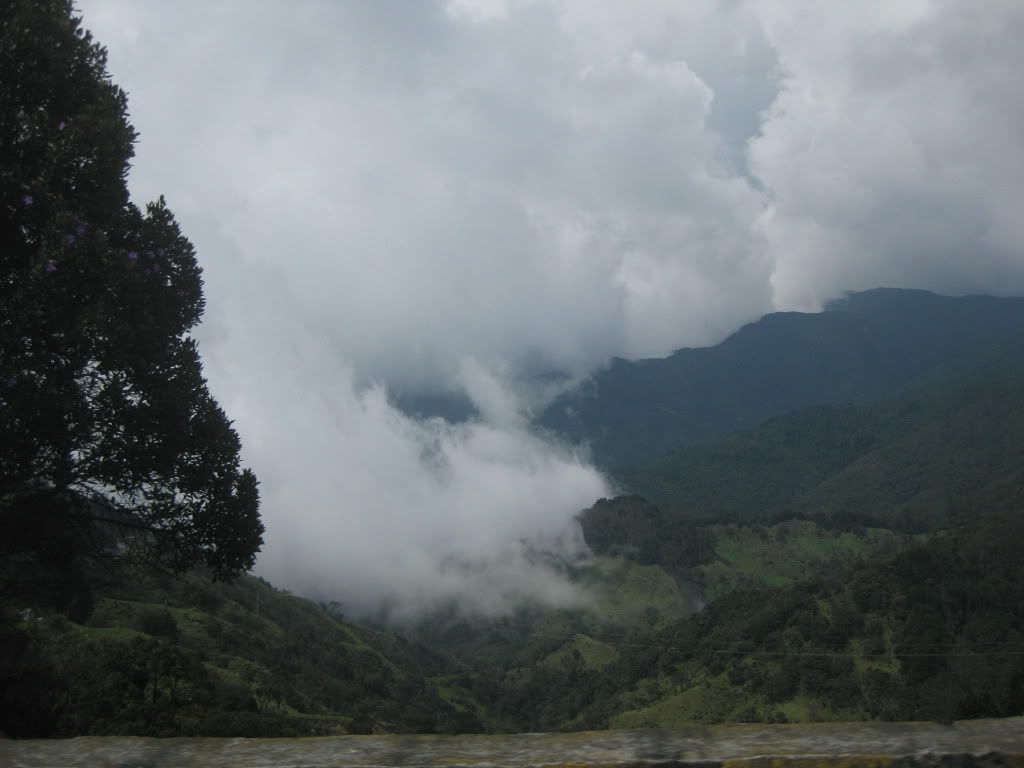

Crazy low visiblity up there in the clouds.
|

23 Mar 2011
|
|
Registered Users
Veteran HUBBer
|
|
Join Date: Oct 2010
Location: Krasnoyarsk, Russia
Posts: 216
|
|
|
Cali, Pasto - Colombia part 3
Cali 3/16/11
The road from Bogota to Armenia was in great condition, but plenty of traffic and tight twisty stuff kept us down to an average of 20mph all the way to Armenia. I didn't think there was any way we'd make it to Cali, but once we turned South from Armenia the road turned into flat plains and pure straight highway. I pushed the bike up to 80mph for the first time in weeks and we flew into Cali before dark.

The exhaust had turned from a nice black to a red rust during the boat trip to Colombia, and I took some time to care for the bike with my "new" tools. Changed the oil and filter finally, gave everything a once over, and painted the exhaust with some rustoleom BBQ paint.

You might notice there is a big hole on the inside of the exhaust. There is one on the other side too, where the exhaust was rubbing on the trailing arm. I hadn't noticed that until Panama, I have no idea how long it's been like that. That explains why I've been setting off all those car alarms...
We were told to try a few things in Cali.
Manjar blanco: a thick milk-based confection, served in something like a coconut shell.

Pan de Bono: A yucca based bread filled with cheese.
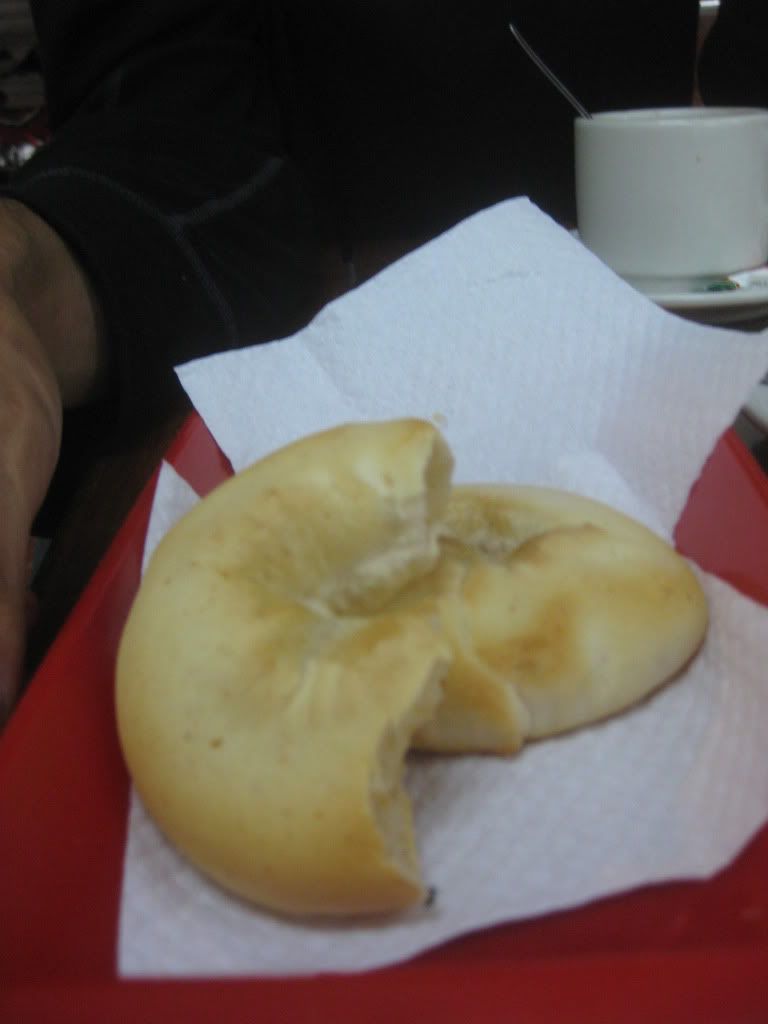
We also tried Bandeja Paisa, a crazy huge dish, which in order to be considered a real bandeja paisa must include these 13 ingredients:
red beans cooked with pork, rice, ground meat, pork rind, fried eggs, plantains, chorizo, arepa, hogao sause, black pudding and avocado. Ours was missing the black pudding, but it was still amazing. Supposedly it's best in Medellin.
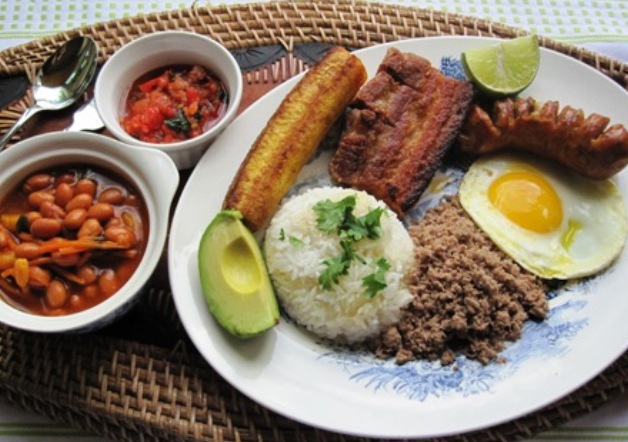
(not my picture)
We spent two days in Cali, nothing of interest really, and then left for the Ecuador border... or we tried to.
The 12" LP record we were given in Medellin was becoming somewhat of a burden. It was too large and fragile to be put into the luggage, so Michelle had been carrying it for hundreds of miles. It was such a important gift that there was no way we would leave it behind. It was clear that it would not survive the trip for much longer, so we decided to send it home. We spent a good deal of time locating the post office and spent a hefty $45 to ship our little package home. Nooowwww we can finally start on our way to Ecuador.
Two hours into the trip Michelle tells me to pull over. She has been keeping a journal full of all the information she's learned, names, addresses and phone numbers for everyone we've met, information on fabric suppliers she's found, sketches. She truly treasures this trip journal, and now she has no idea where it is. We look through the luggage and find nothing. I guess we're going back...
We checked everywhere we had been the night before. The restaraunt didn't have it, the hotel didn't have it and the bakery we had coffee and pastry didn't have it. When we returned to the bakery we were befriended by the owner. Alberto had been running the bakery for 14 years, and had lived in Colombia all his life. He brought us out different breads and cheeses to try for free. When I inquired as to where I might find a grocery store he said "let´s take my truck!". Incredibly friendly fellow.
He invited us to come to the river with him the next day. Apparently he has a friend who has a lot out there, and he goes frequently. I guess we'll be staying in Cali a little longer than expected!
The next day we arrived at the bakery hoping to grab a quick breakfast before we left. Just as I was ordering he stuck his head out of the back and asked "you want eggs?". In a few minutes we had big plates of eggs, rice, beans, bread and coffee in front of us. Very tasty, his bread was truly incredible. I went to pay and the cashier refused, saying that the boss had sent it. Good start to the day.
He drove a little chinese brand work truck with two seats. Since there were four of us going out to the river me and Michelle opted for the back. It was pretty interesting carving around the mountain roads, sliding around on little plastic crates with the door open in front of me.
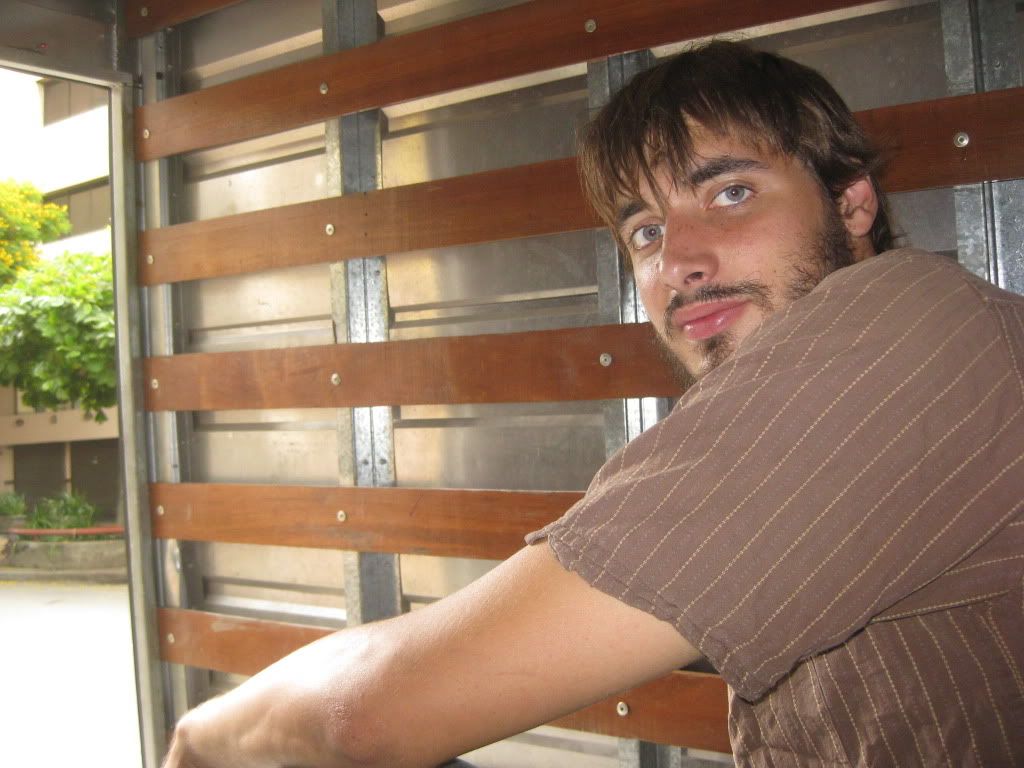
Half an hour later, we arrived in the little pueblo called "La Elvira".
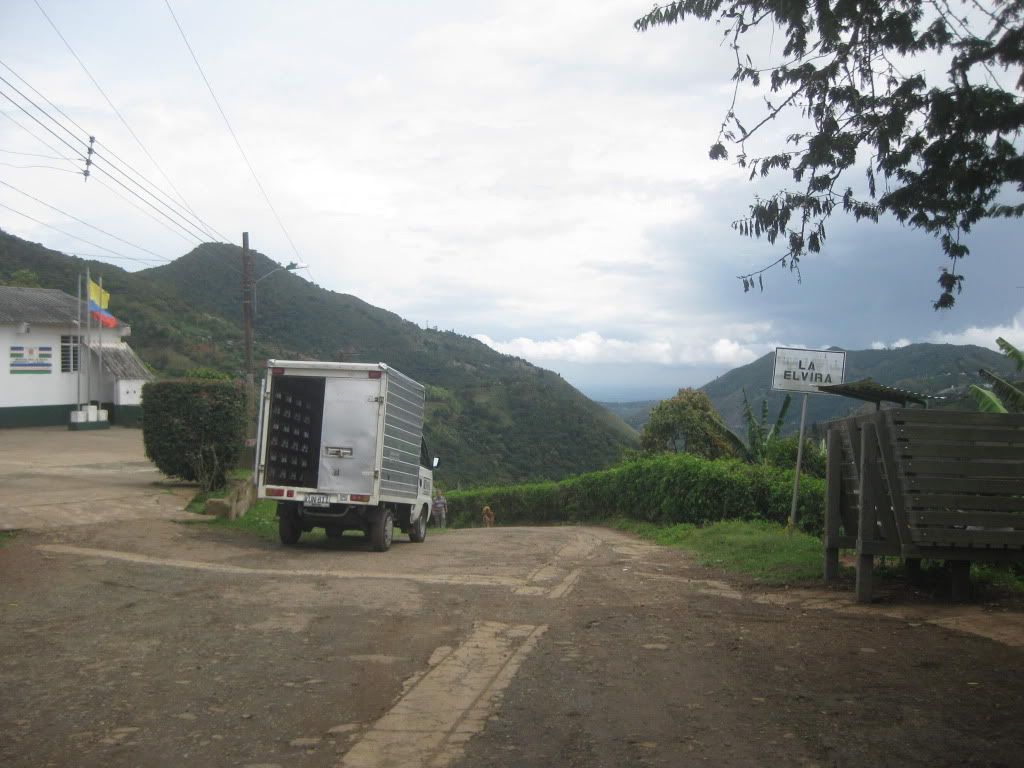
Stopped for some vegtable sancocho and cerveza.

We went a little further and arrived at his friend's lot. His friend lives and works in Cali, but he would be joining us later. We explored the picturesque little farm on the mountainside.
Crazy swing off the edge of the mountain. Pretty intimidating to do for the first time. You slip off and you could very easily die.

Stairs leading down the tilapia pond.
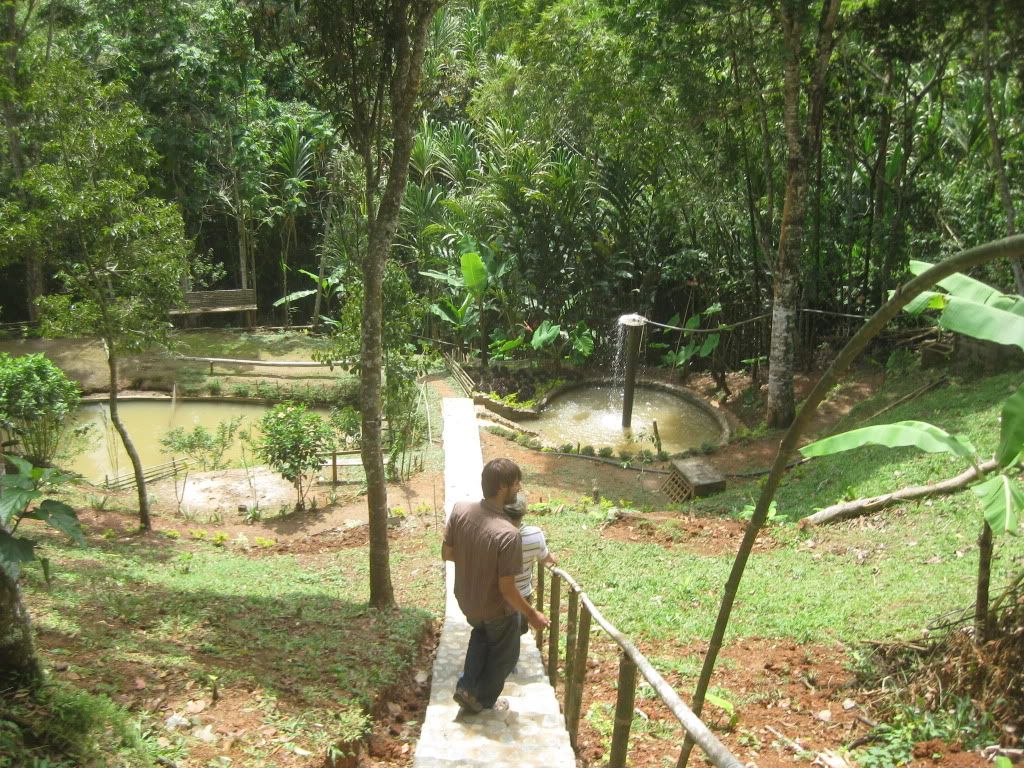
We met a confused rooster, who according to legend was only sexually attracted to shoes. I kicked my shoe at him to find out.

Let's just say there is DNA evidence to prove it.
Next, to the waterfalls. Freezing cold but amazingly beautiful.
Alberto is at the bottom for reference.
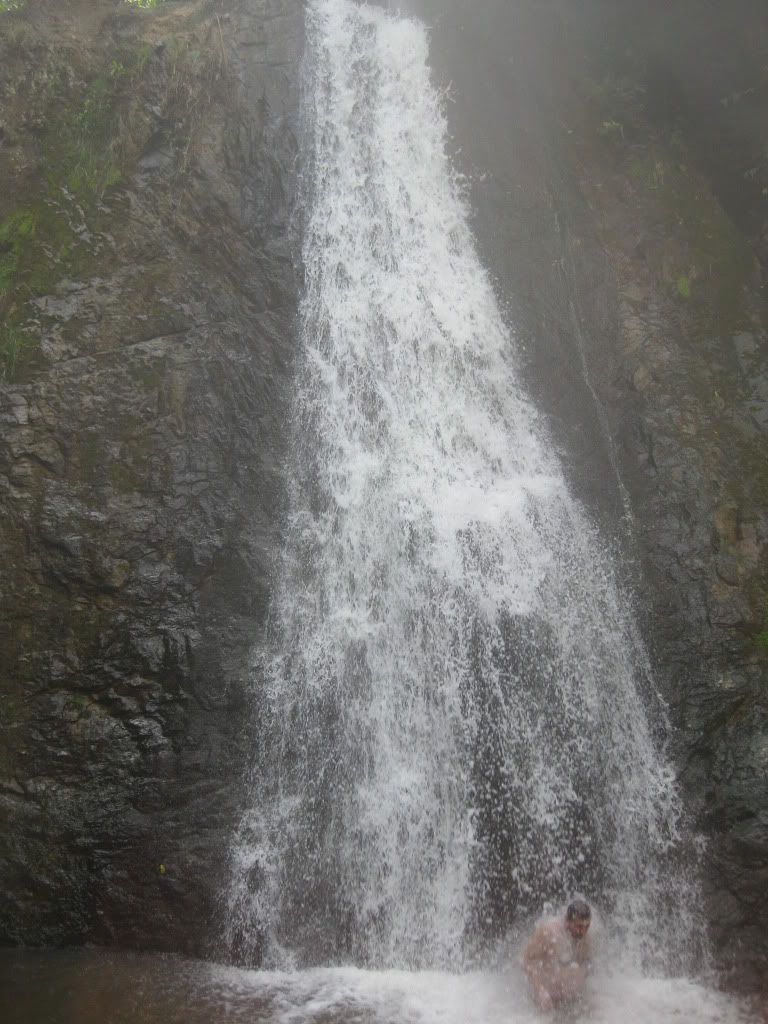
Me and Alberto enjoying our high pressure massages.
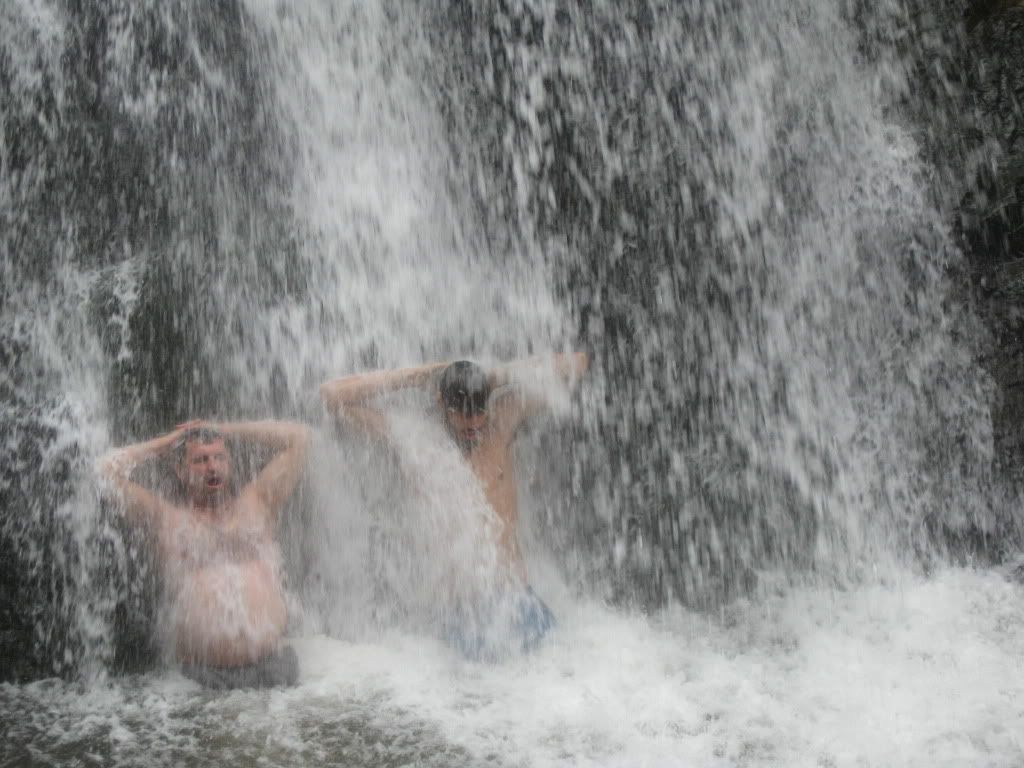
Moving onto the next waterfall.

Alberto diving:

Enjoying the smaller stuff:
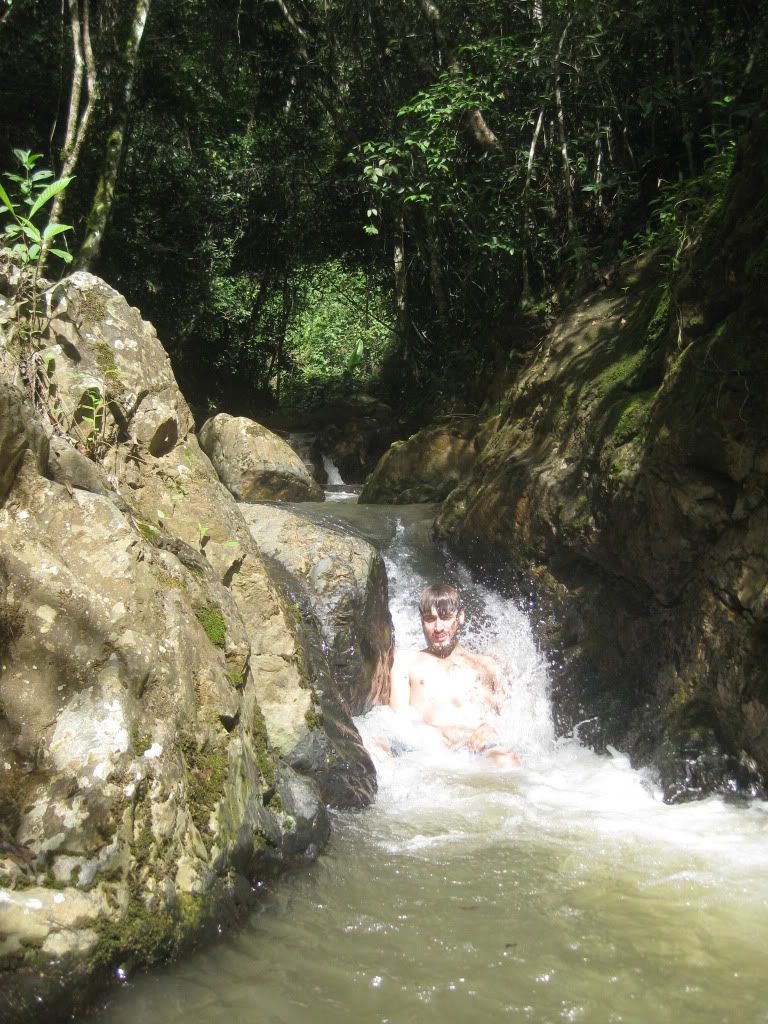
Obviously we're very frustrated at having to return to Cali.
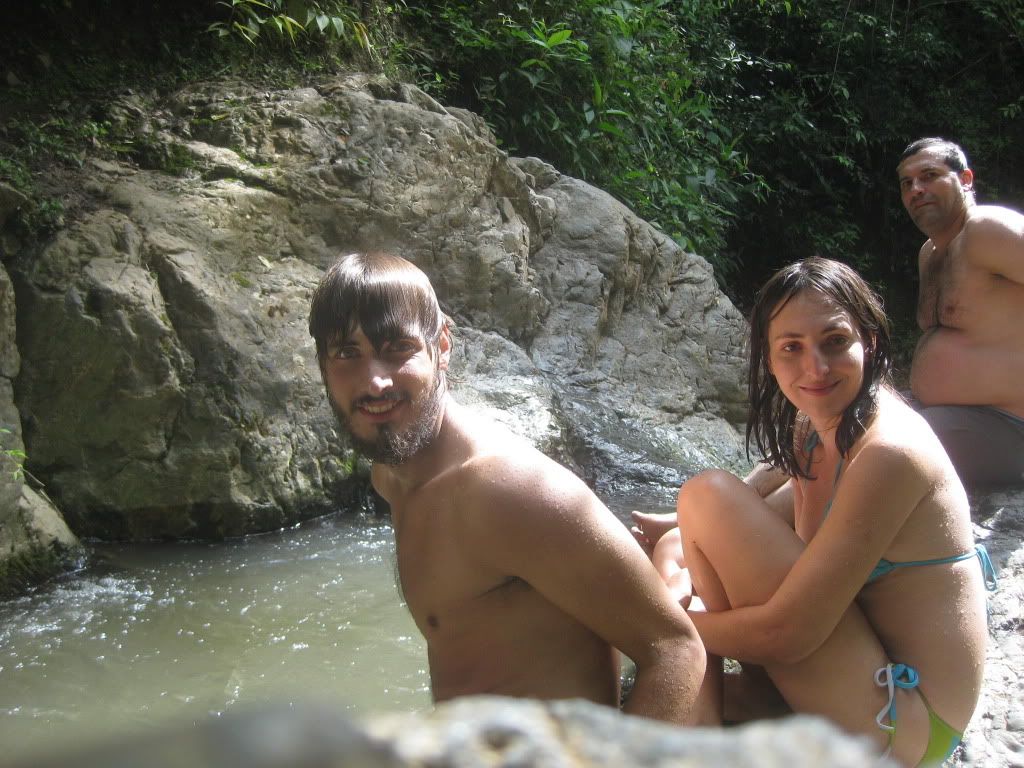
We go back to the farm and enjoy a snack of more bread and cheese. Soon the owner arrives (name forgotten!) with his family, and another friend. I am told that this little village is paradise, and Colombia is the best country in the world. It's hard to disagree.
Michelle talking with Jason, a nephew.

Shortly afterwards we are treated to even more baked confections, along with coffee and agua de panela (boiled fruit water). Turns out this guy owns a bakery too. Bakers are great friends to have.
Alberto has to get back to close the bakery, so we exchange information with out new friends and bid them goodbye.
If you are in Cali, this bakery is around the intersection of 6th avenue and 15th street (as is Hotel California, where we stayed for $5us a night). He loves talking to travelers and if you strike up a conversation with Alberto tell him Jordan and Michelle say hello.
Dinner is granola, bannanas and chess. The little travel chess has gotten plenty of use this trip.

Next day we eat one more delicious breakfast at the bakery and head out.
Eating lunch on the roadside.

The road from Cali to Ecuador is great. After an hour you're out into an area that looks and feels just like Mexico. Dry, hilly desert. The roads were even potholed exactly like they were in Mexico. We spent two hours in dejavu remembering what a great time Mexico was. Then, the next hour we are up towards the clouds again, carving up enormous platueas and valleys. We have seen many beautiful mountain ranges on the trip, but never anything like this.

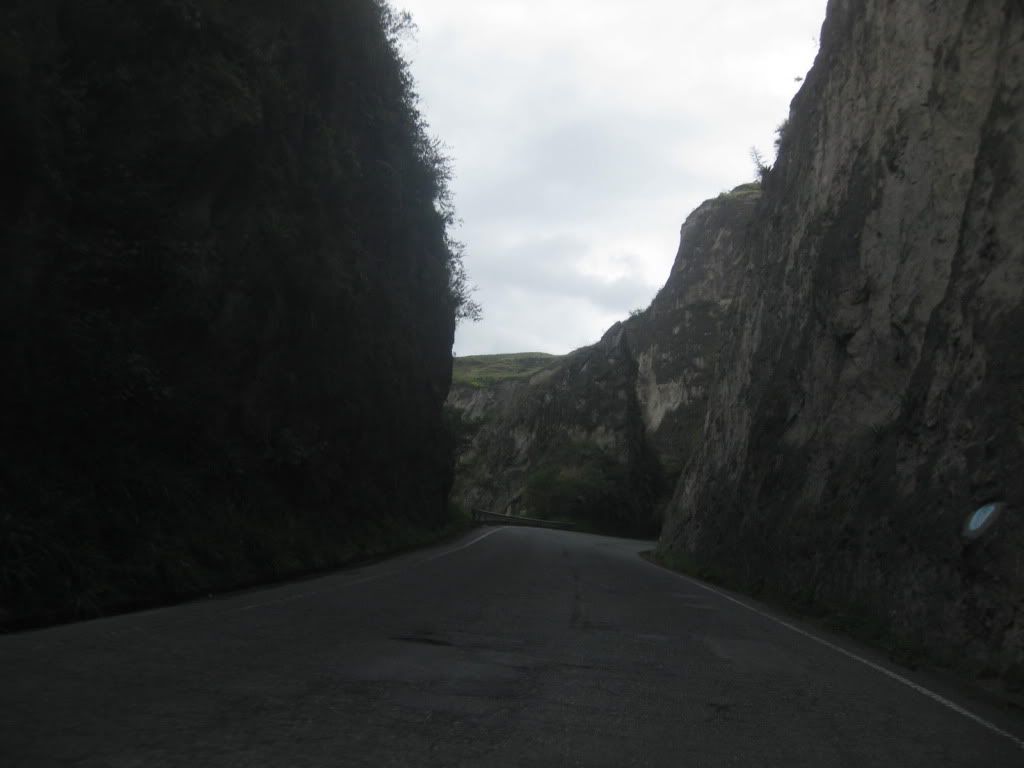
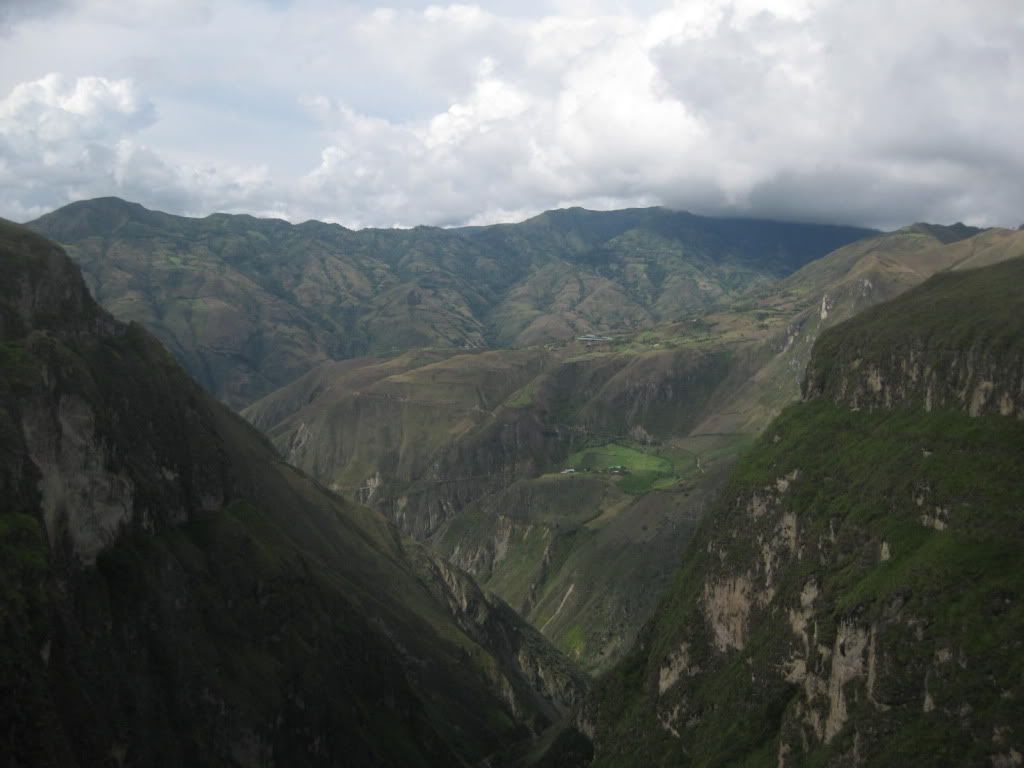
Wow.
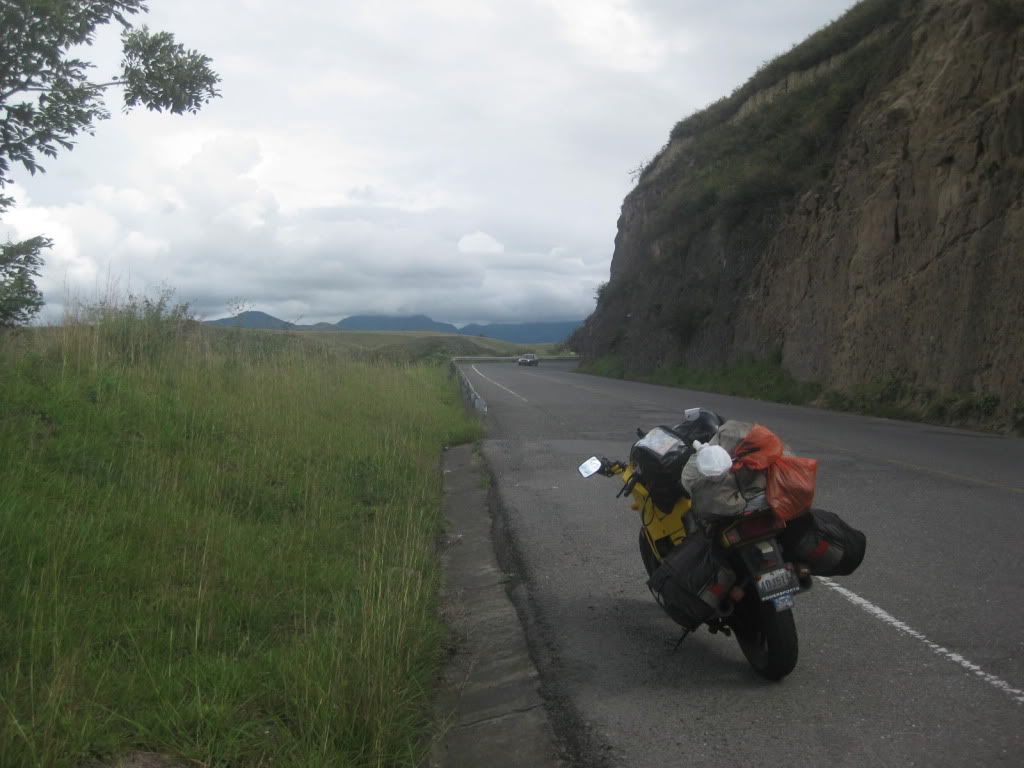
And then soon enough we're back in the clouds, soaking wet.

I actually give a little love tap to the bumper of a car at one point. Guess the wet grip of my China tires isn't up to snuff. No damage though, thank goodness. If I still had a front fender I probably would have left a nice yellow mark. Almost makes the constant stream of dirty water getting thrown up into my visor worth it.
Pasto 3/21/11
We were advised that Pasto was a nice place to stop, and since the weather wasn't looking any nicer we stopped for a place to sleep. As of Today, 3/22/11, that is where I am writing from.
Pasto is a very nice town. Clean. Big enough to have everything you need but small enough to avoid the big city grime. It's very cool and rainy up here, which I like.

I could live here. Michelle says it's too rainy.
Lunch in the market $2500 pesos. Most places were serving "pata". A plate of duck for $2500!

Pata means "duck", but I guess it means hoof as well, because this is what we got. Definitely interesting, I've never tried it before. Incredibly fatty, with many different textures. Michelle was not a fan. If nothing else it was incredibly filling.
Also trying the local Pasto soft drink. A flavor something like big red, but I can´t quite put my finger on it.

Also finally got to try these little tomato looking things I've been seeing this whole country. Turns out they´re nothing like tomatoes. They're more like potatoes, but they have a seed in the middle. Served hot and with salt. Delicious.

And, some good news. We called the DHL office where we stopped briefly a few days earlier, on the off chance that Michelle left her prized notebook there. Yes, they've got it! Getting it shipped to the US would be $75, but getting it shipped here to Pasto is only $4. I guess we're hanging out in Pasto for a day!
Last edited by jordan325ic; 29 Mar 2011 at 16:04.
|

23 Mar 2011
|
|
Registered Users
New on the HUBB
|
|
Join Date: Mar 2011
Posts: 1
|
|
|
Looks like an awesome trip! Also I like that caveman beard you got going on
|

29 Mar 2011
|
|
Registered Users
Veteran HUBBer
|
|
Join Date: Oct 2010
Location: Krasnoyarsk, Russia
Posts: 216
|
|
|
3/22/11 Quito (Ecuador part 1)
Quito 3/22/11
We got the package by 11am and headed out to Ecuador. Not far from Pasto. Goodbye Colombia.
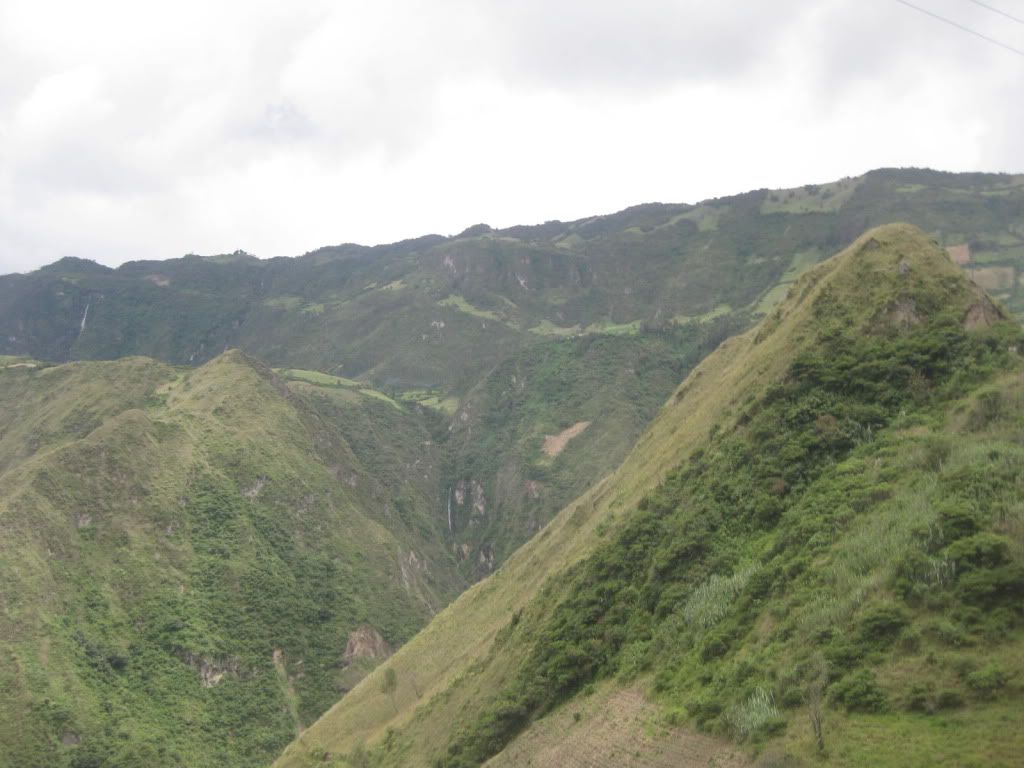
Ecuador border crossing was very easy. Checking out of Colombia only took a moment, checking into Ecuador took 30 minutes and cost nothing.
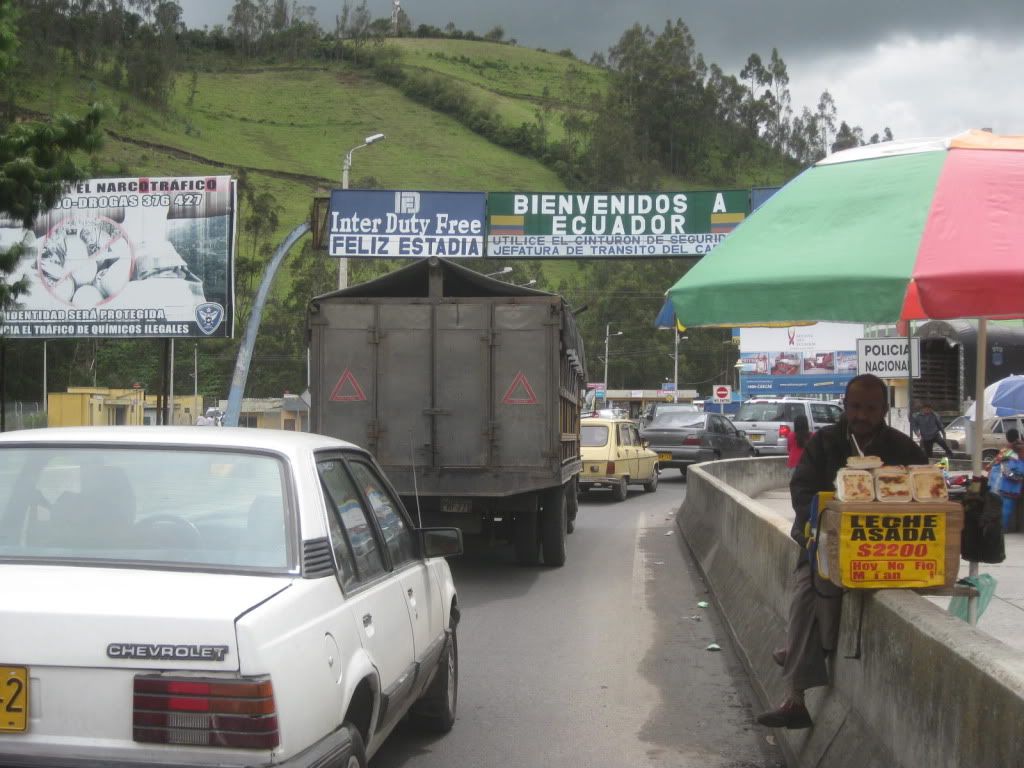
We weren't sure where we would end up that night. All the Colombians we talked to said that Ecuador was cheap, but all the hotels we came across were twice the price of our Colombian hotels ($15 compared to $7), but dusk was fast approaching. The Panamerican was in such great condition that we decided to break our normal no-night-riding rule and keep going to Quito.
Stopped and tried "bizcocho", which were advertised everywhere. Little hard sticks of salt bread.
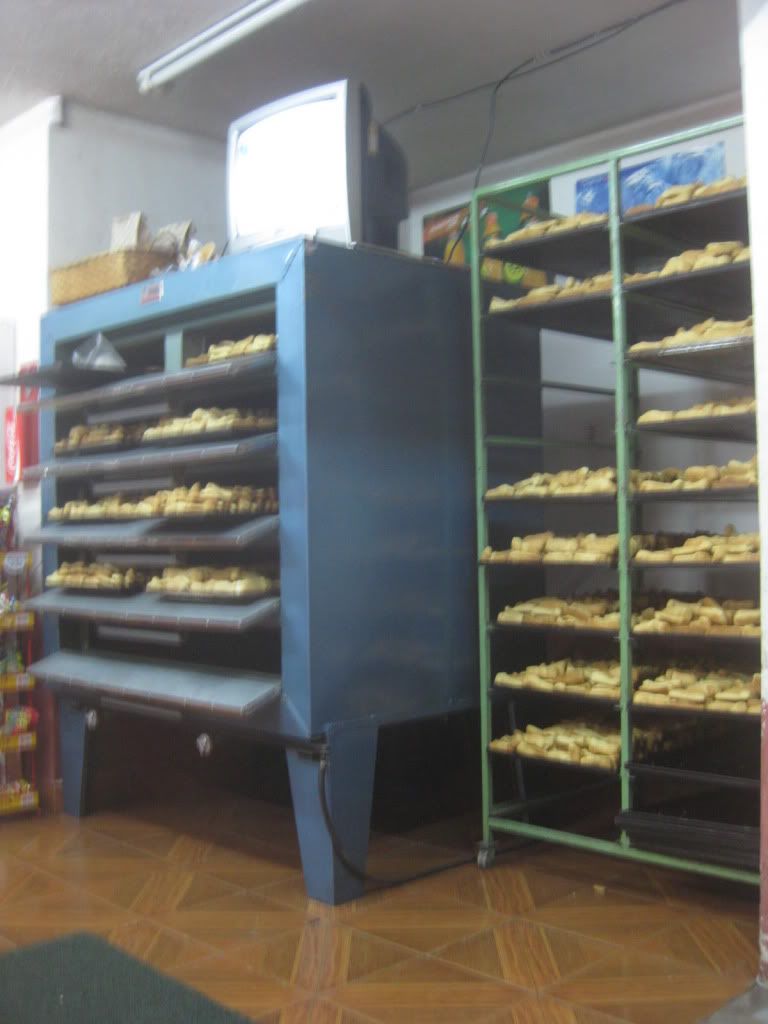
Got to quito, found a hotel ($12 per night, too expensive!) and awoke in the morning to get breakfast. At least the food is cheap here.

Egg, two "tortillas de verde" and coffee for $1.
Stayed two nights in Quito. Lovely city. Second highest capital city in the world. Very clean and cool.
Most impressive Cathedral of the trip, by far. Basilica de Voto Nacional.


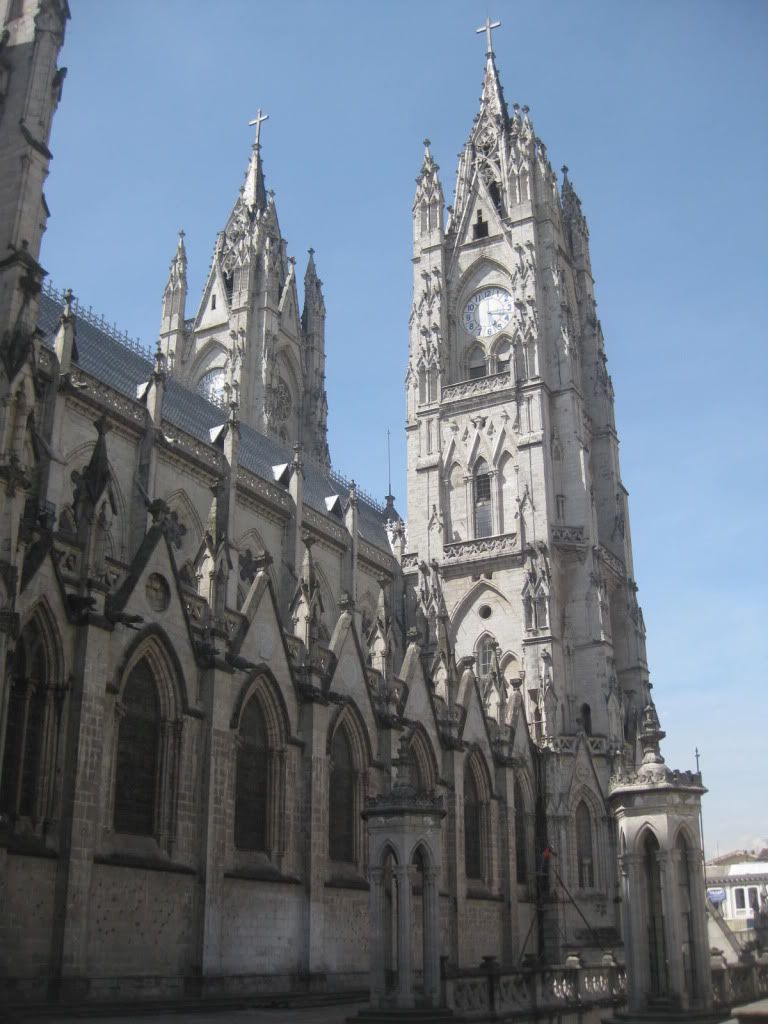
African-American protest in front of the hotel. They had signs with Malcom X and Martin Luther King Jr.

Quito historic district streets:



Center of Contemporary Art:

Favorite art museum of the trip.
Tons of people were selling this:

"Esponilla", means "foam" in spanish. Looks like ice-cream, is actually just some sort of whipped cream. A little too rich for me.
Last day we rode up onto the hill in the middle of the city, where an enormous angel ("El Panacillo") is perched.
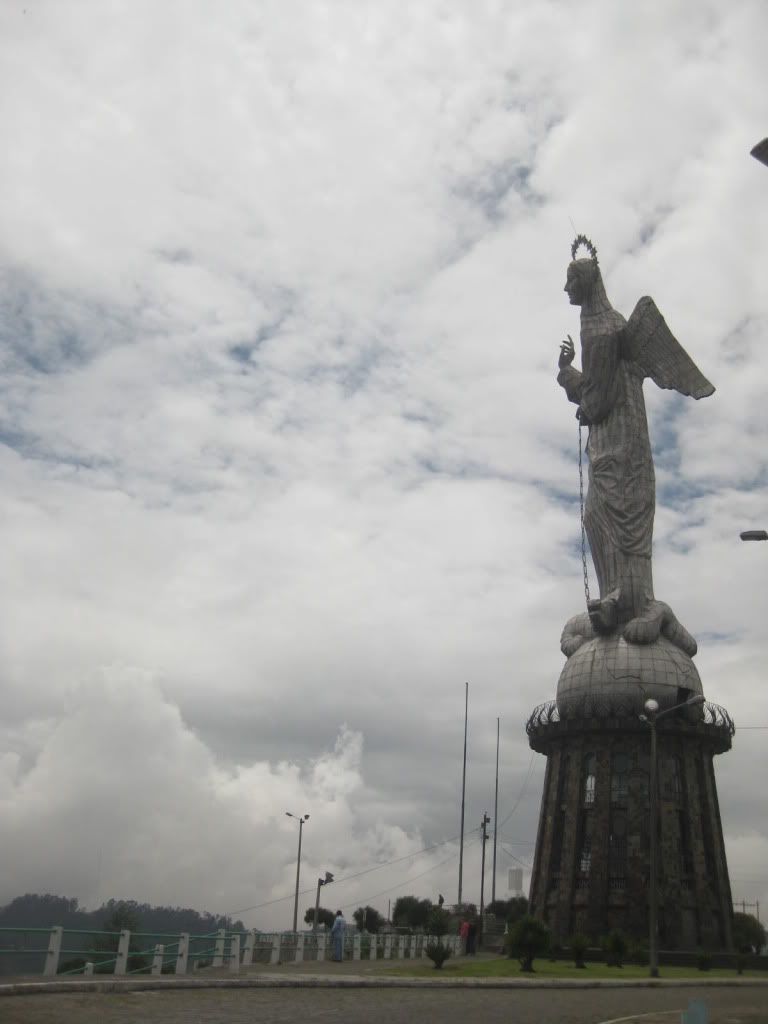
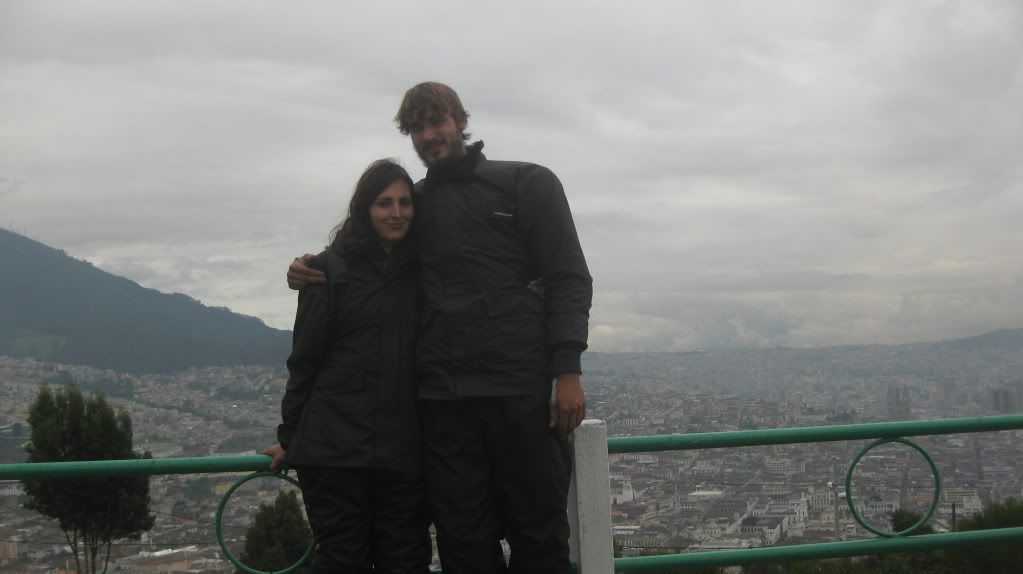

Goodbye Quito:
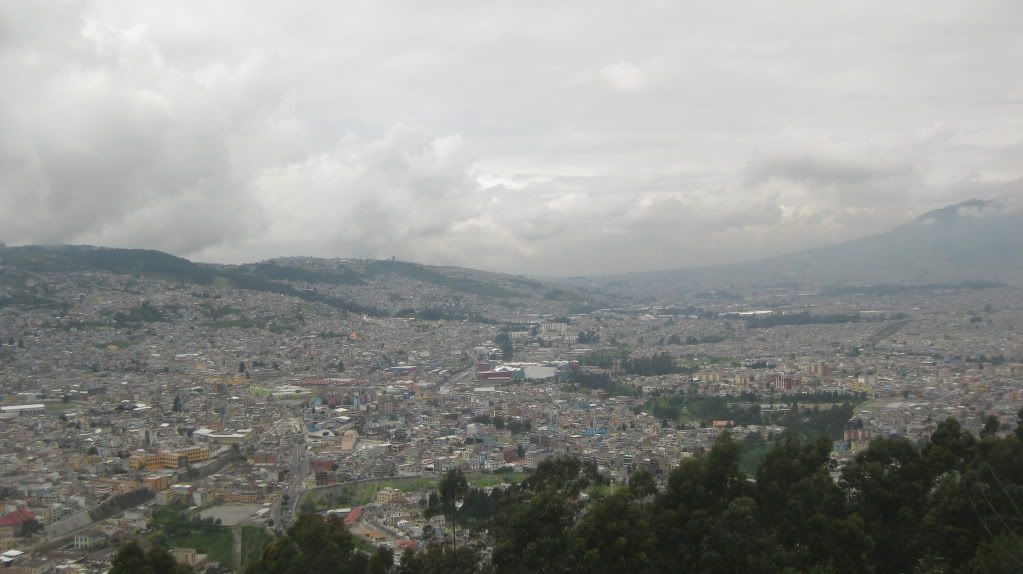
|

29 Mar 2011
|
|
Registered Users
Veteran HUBBer
|
|
Join Date: Oct 2010
Location: Krasnoyarsk, Russia
Posts: 216
|
|
|
3/24/11 Banos, Guayaquil (Ecuador part 2)
Next, to Banos.
First crash of the trip.
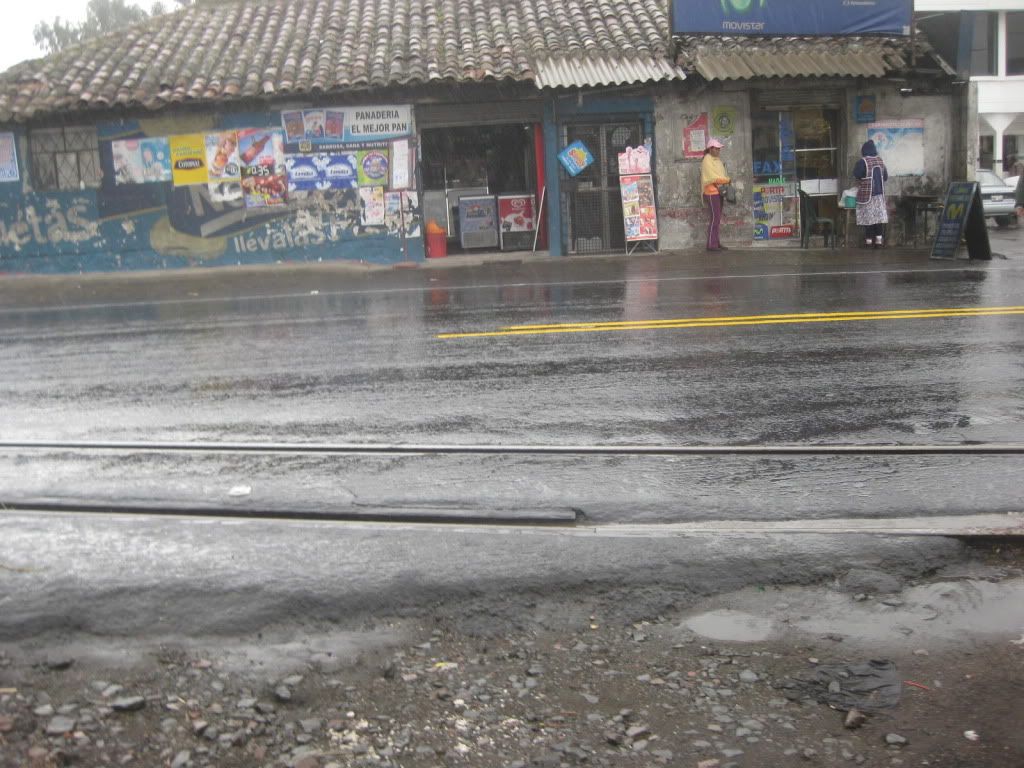
Raining. Came up to these diagonal railroad tracks, didn't realize they had deep wheel-catching trenches until it was too late. Slowed down and tried to go sideways over but didn't take enough of an angle and the front wheel caught the trench. I was only going 5mph, so no damage to us or the bike. Just a few frustrating minutes of trying to clear the flooded carbs. Lucky it was very minor.
Stopped in a Salcedo, where every single shop advertised this special fruit ice-cream. Apparently it's famous all over the world

Probably the best icecream ever. Cream flavor on the right, avacado flavor on the right.
We got to Banos, but kept going to find an appropriate camp spot. Right before the first tunnel after Banos we saw a little place where I could ride the bike up into the reeds. Beyond that, there was a short hill where the tent could be hidden. This looked good:
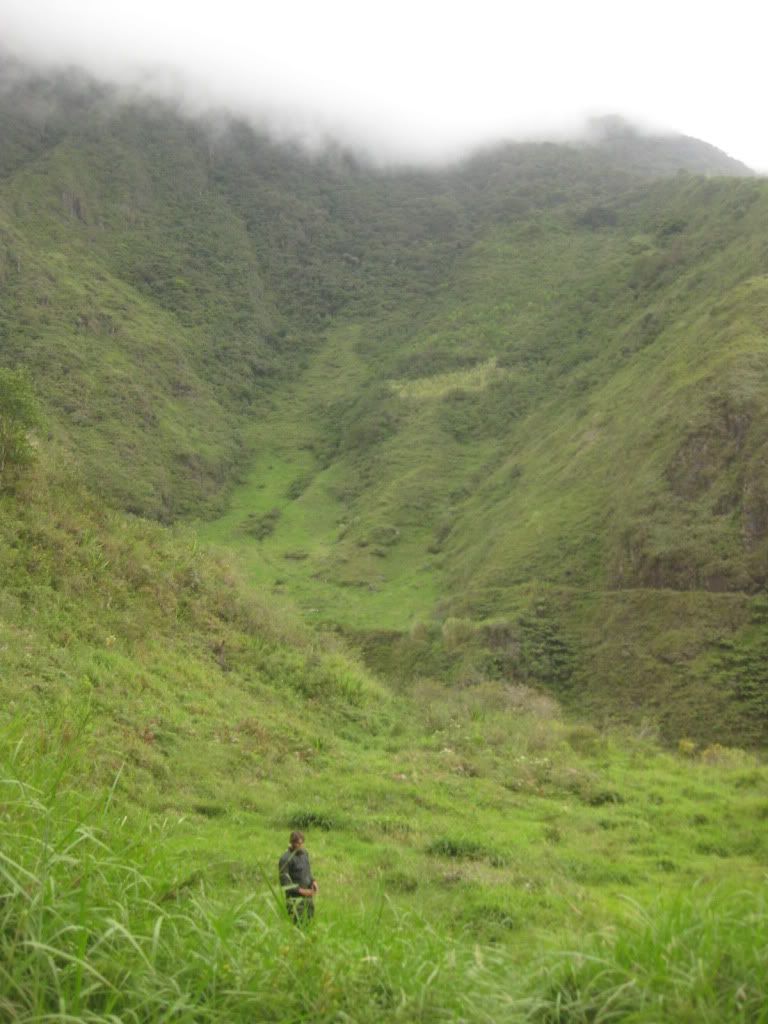
View of the waterfalls going down the canyon.
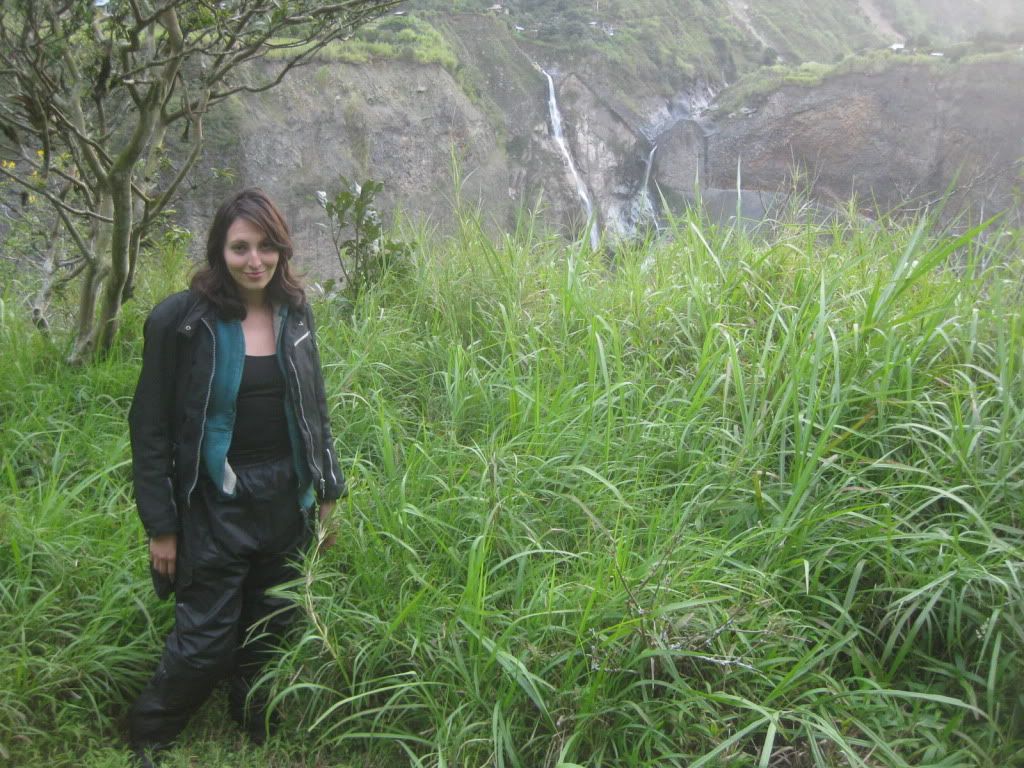
Stealth camping at it's finest.
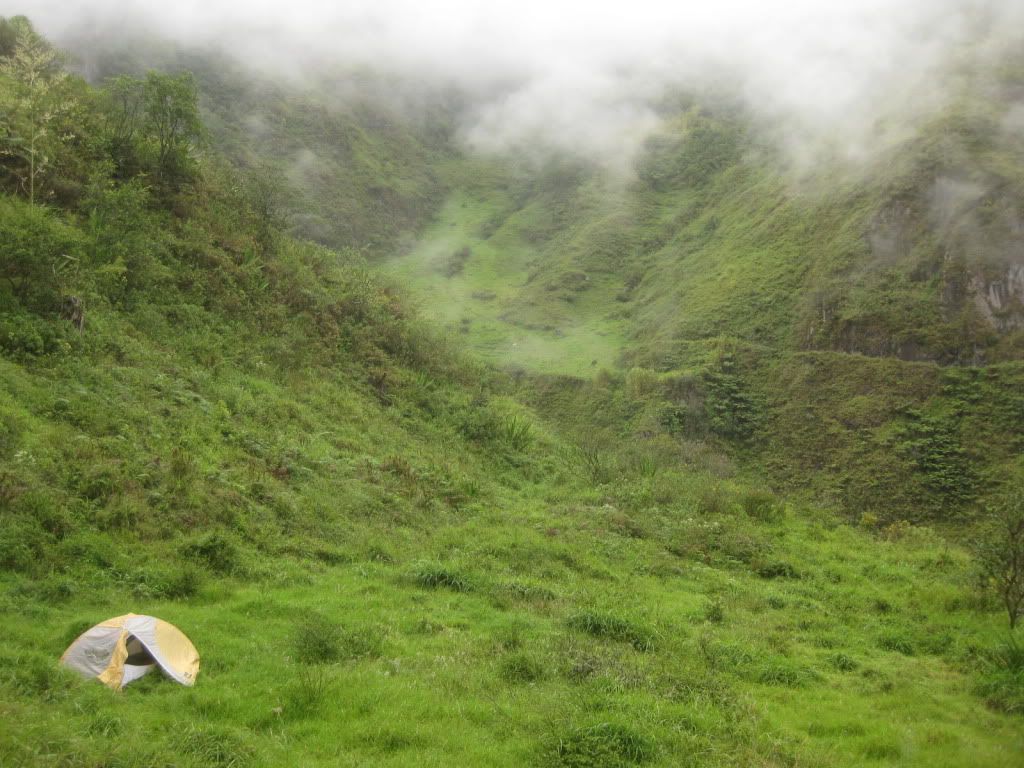
The bike was hidden slightly further up the hill.

Definitely the most beautiful camping spot of the trip thus far. We spent two nights here while we explored Banos.
Paid $1pp to take a hike down to "Pilion Del Diablo", a waterfall.
From a distance:
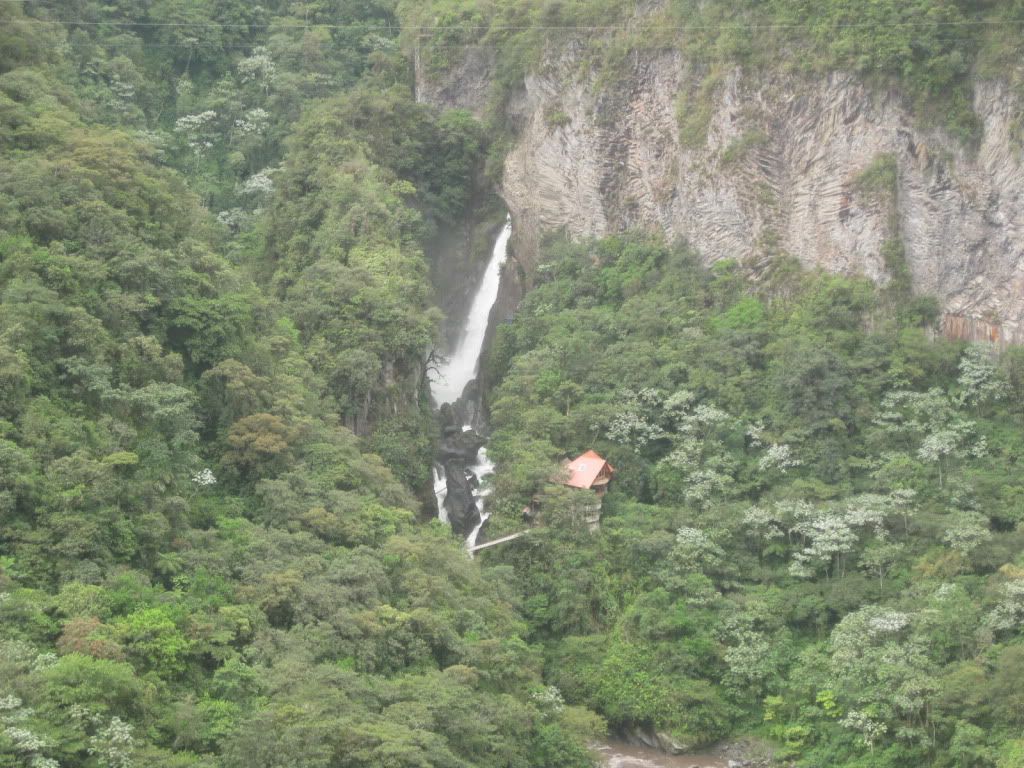
40 minutes later:

You could crawl up a little path to go behind the waterfall. Rain gear came in handy here.

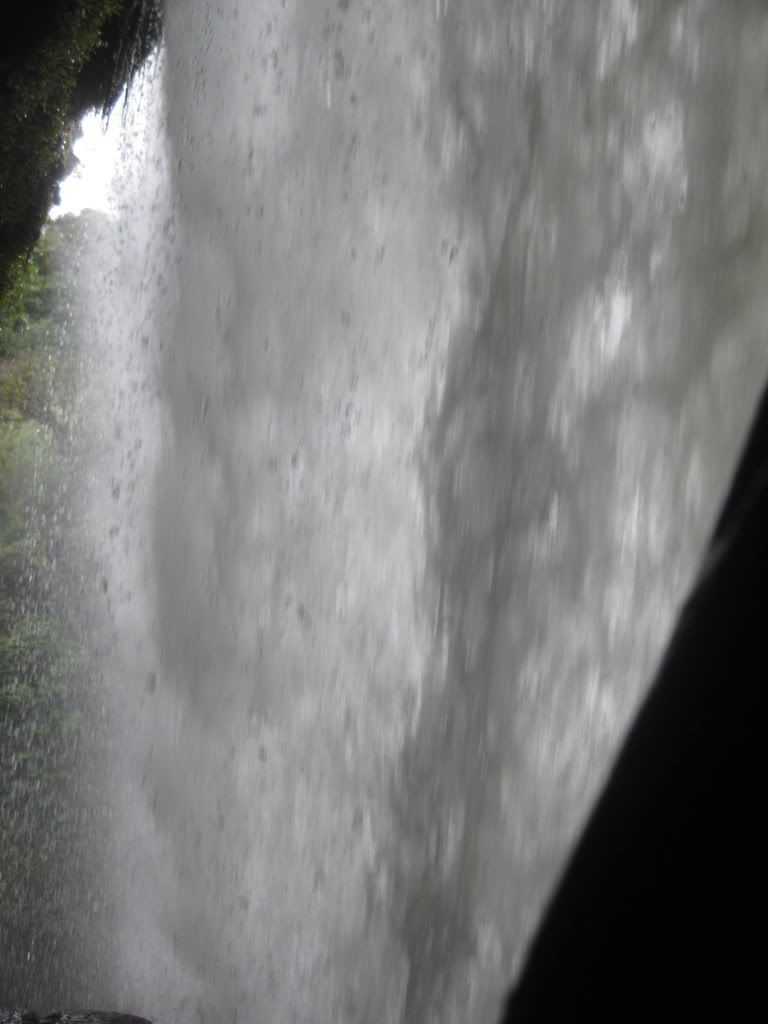
Beautiful place.

Then we went to this bridge:
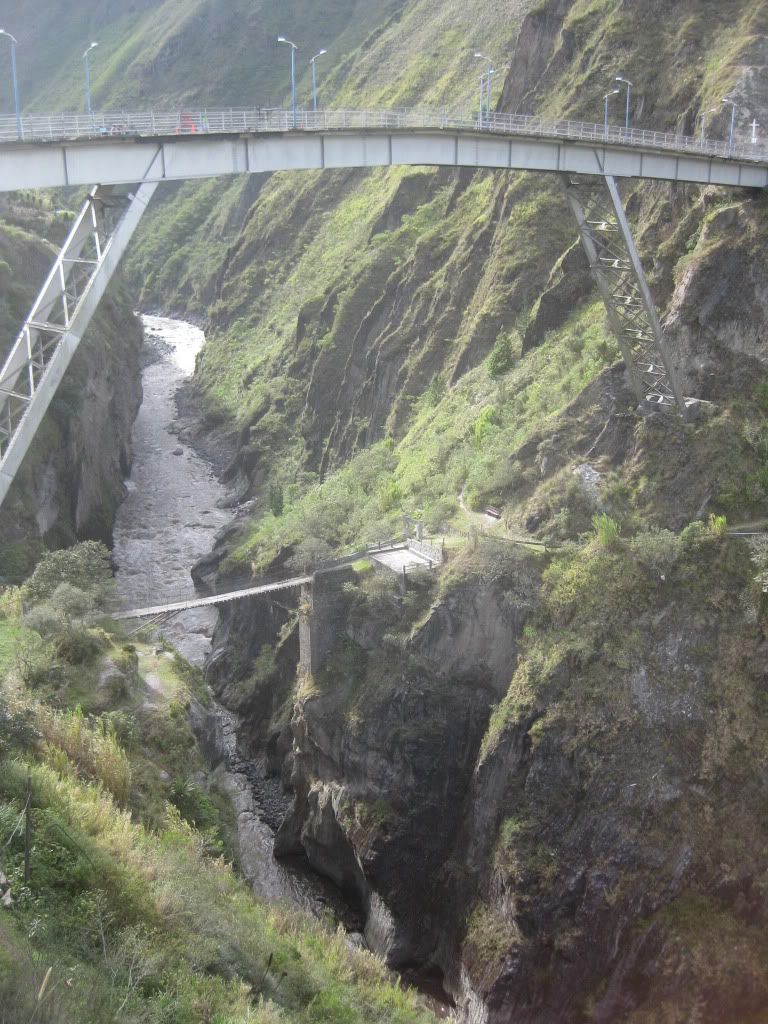
Climbed up on this platform:
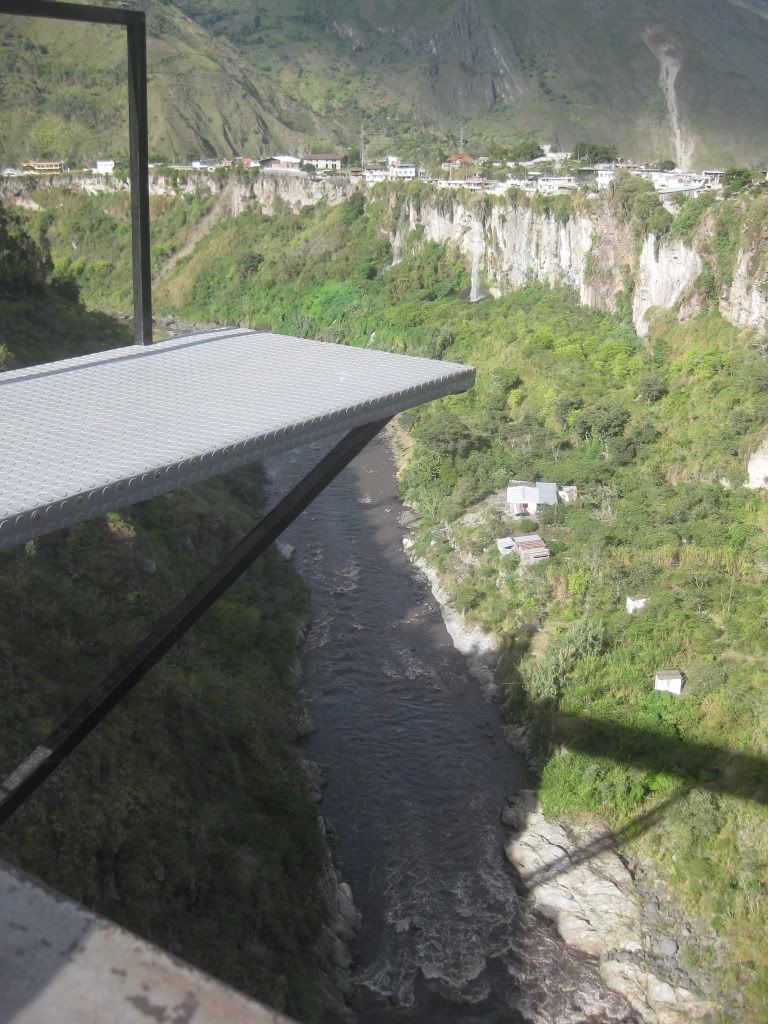
And did this:
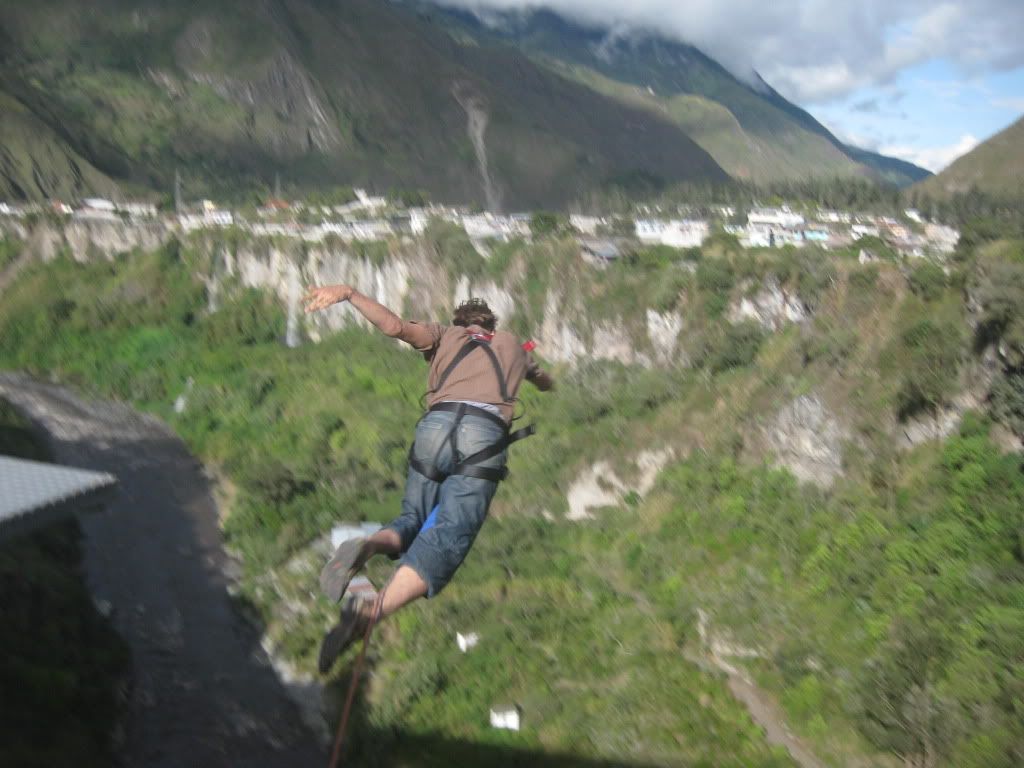
It's called "swing jumpin". Sort of like bungee jumping, but the line isn't elastic. You run out, jump headfirst and when you hit the end of the line you go into a big pendelum.
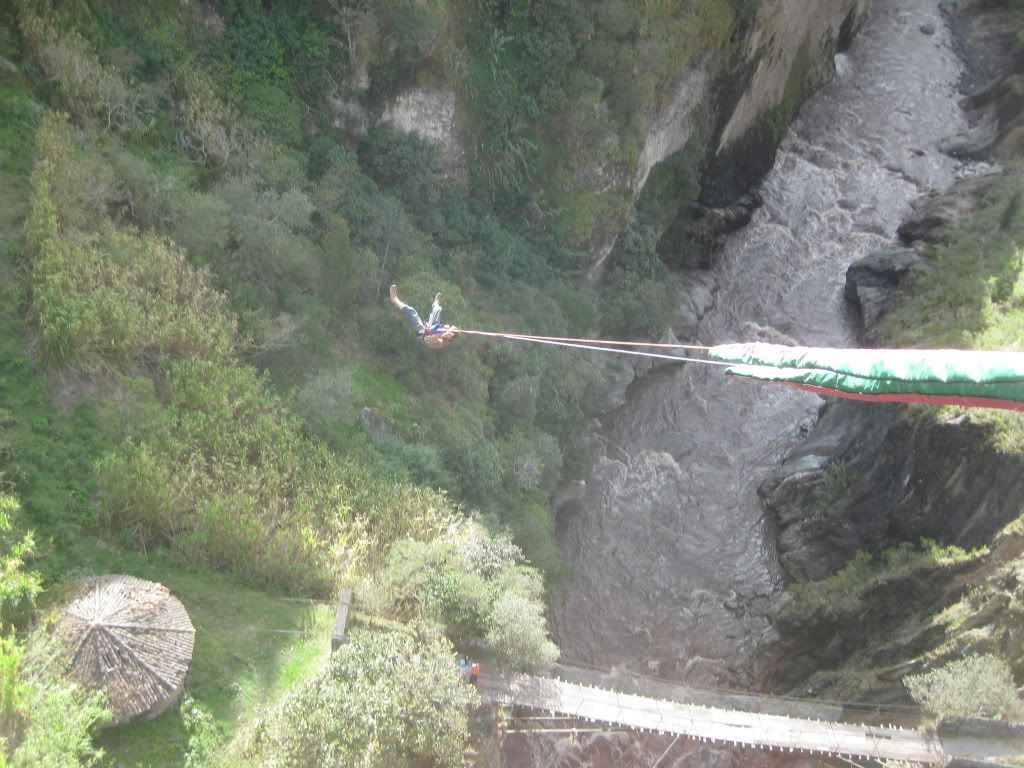
I planned to take a video of Michelle doing it, but 2 seconds into the footage the camera said "memory full", and I didn't have enough time to erase anything before she jumped. What a shame!
Here she is setting up:
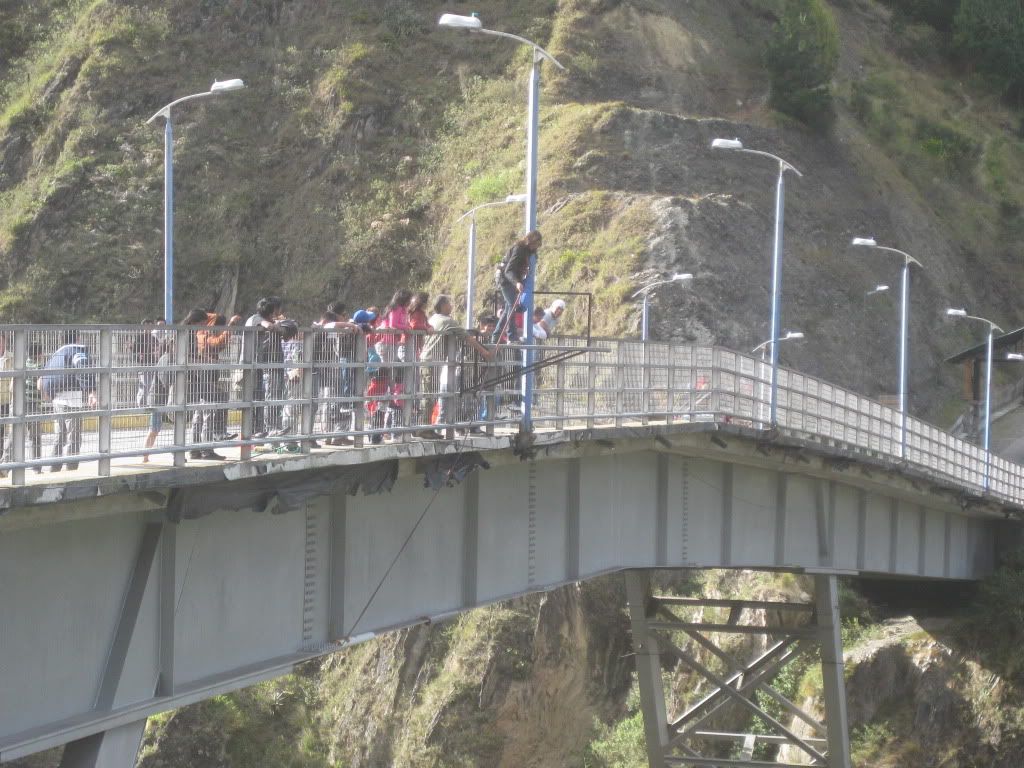
Banos is famous for it's Melcocha, a sugar-cane based candy made by hanging the mix from a doorframe and beating it. It´s all over Banos.
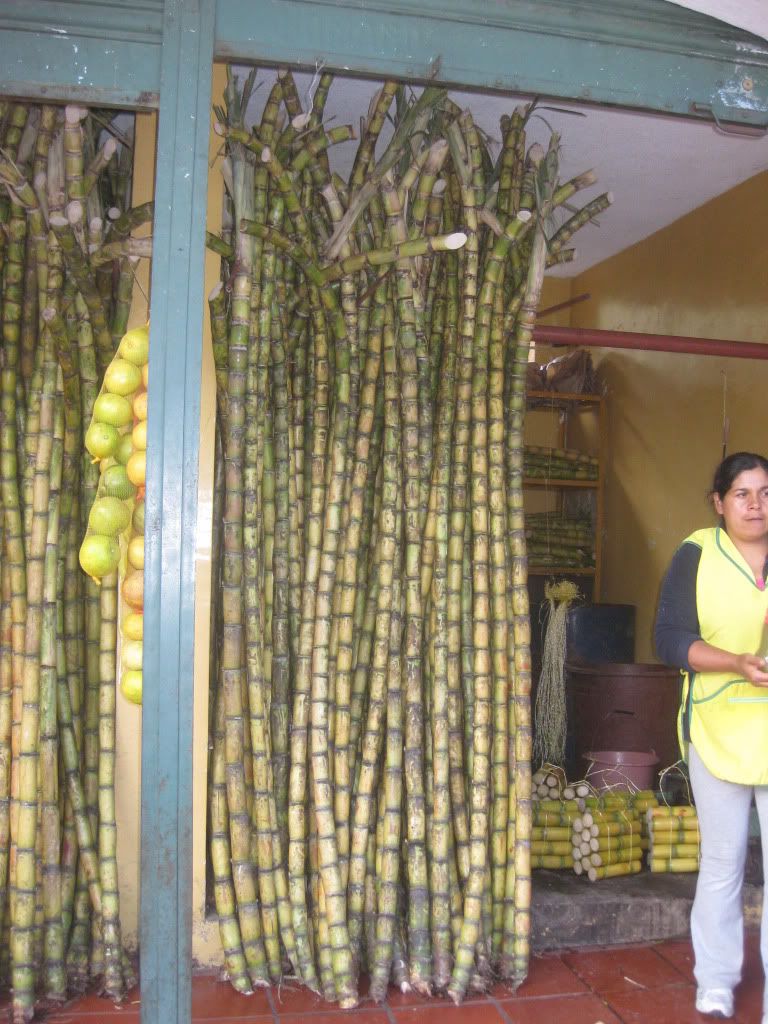
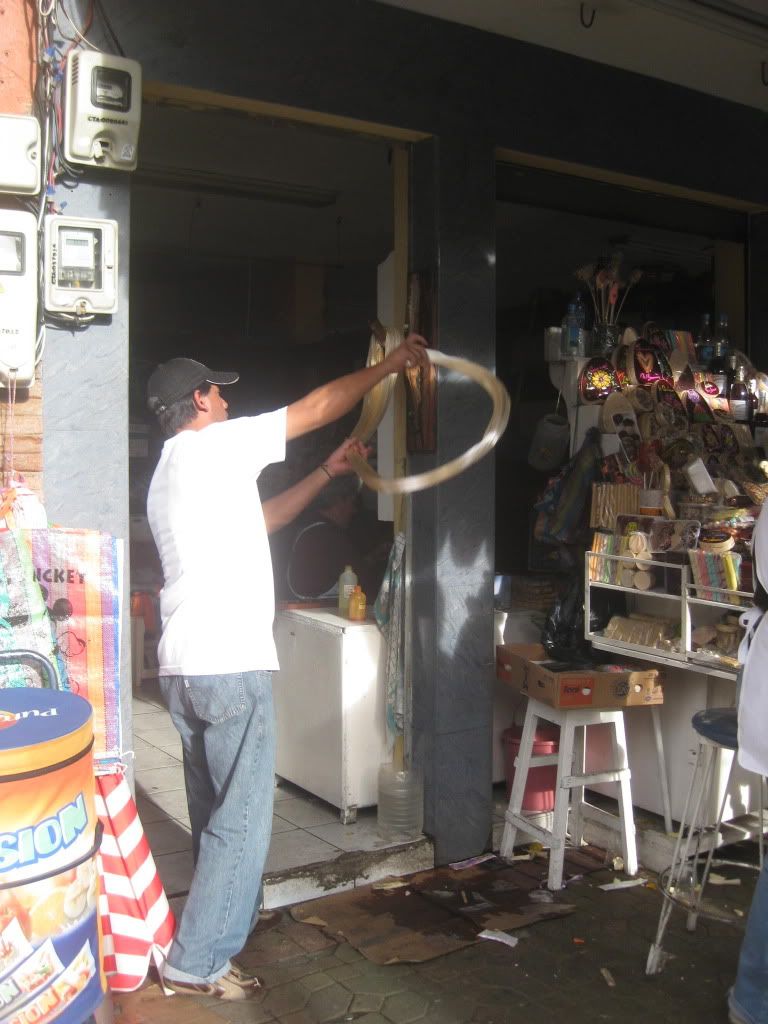

These meals-in-a-bag are common in Ecuador. Normally corn, topped with meat and salad. Quite tasty.

Still have yet to try the Ecuadorian delicacy: Guinea pig
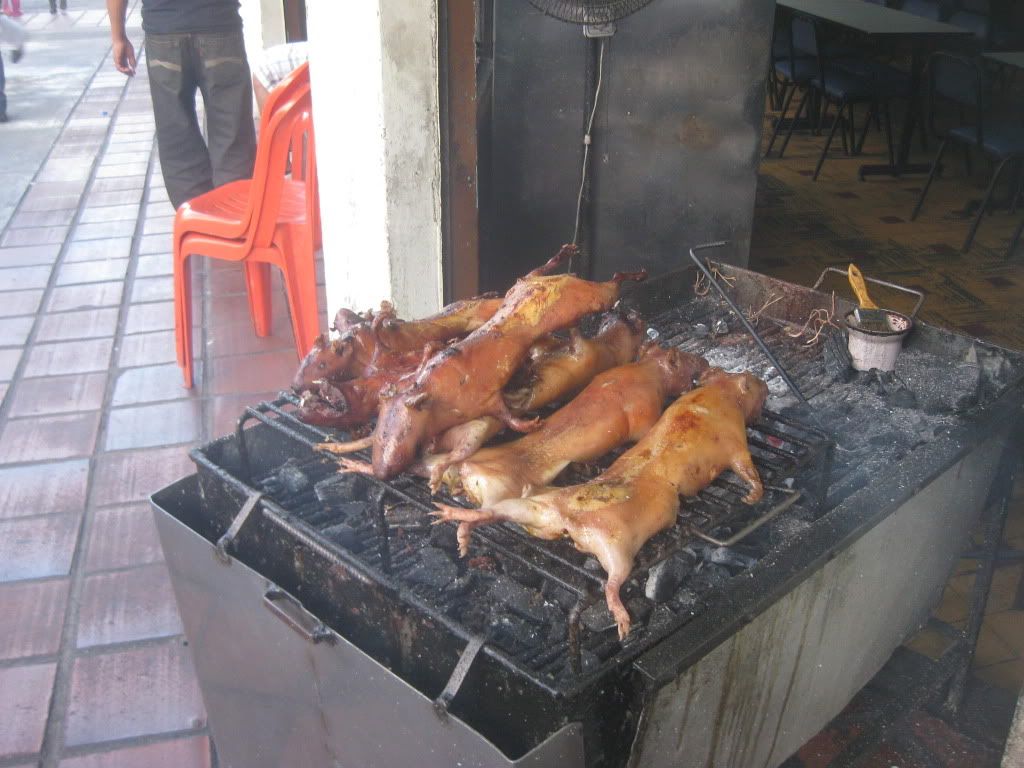
Banos Cathedral at night.

Thermal waters. Super crowded every day.
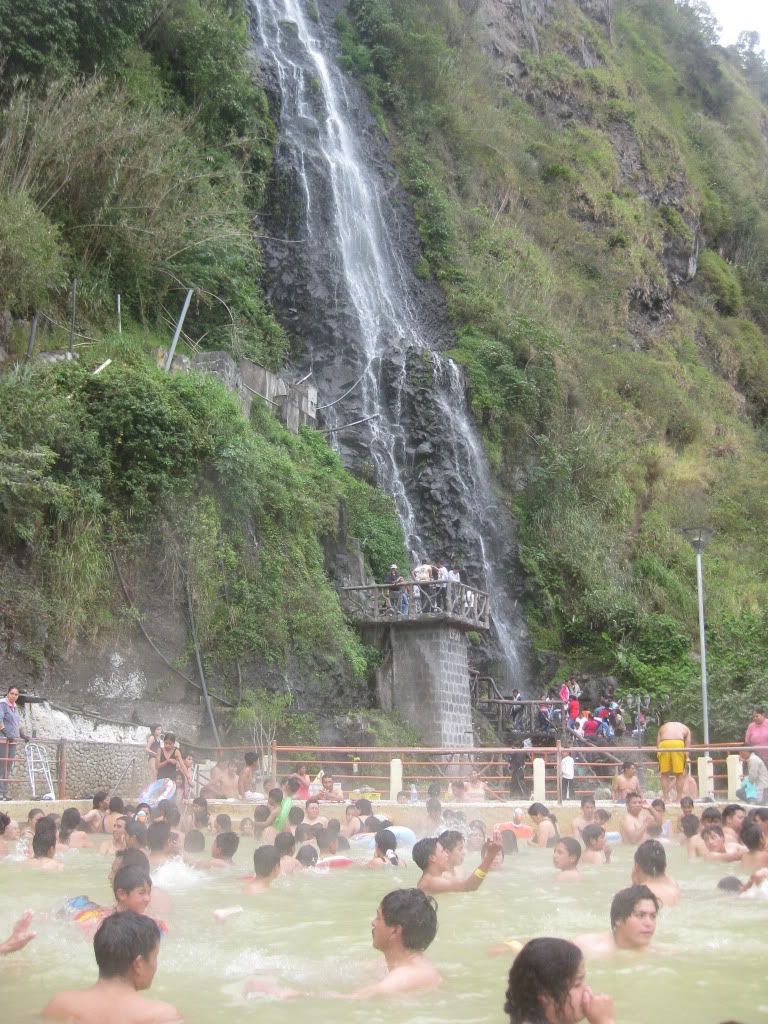
The last day in Banos we rode up to the top of the volcano road to get pictures of the active Volcano and the town. This is what we got:

Damn clouds! The road itself was interesting enough.
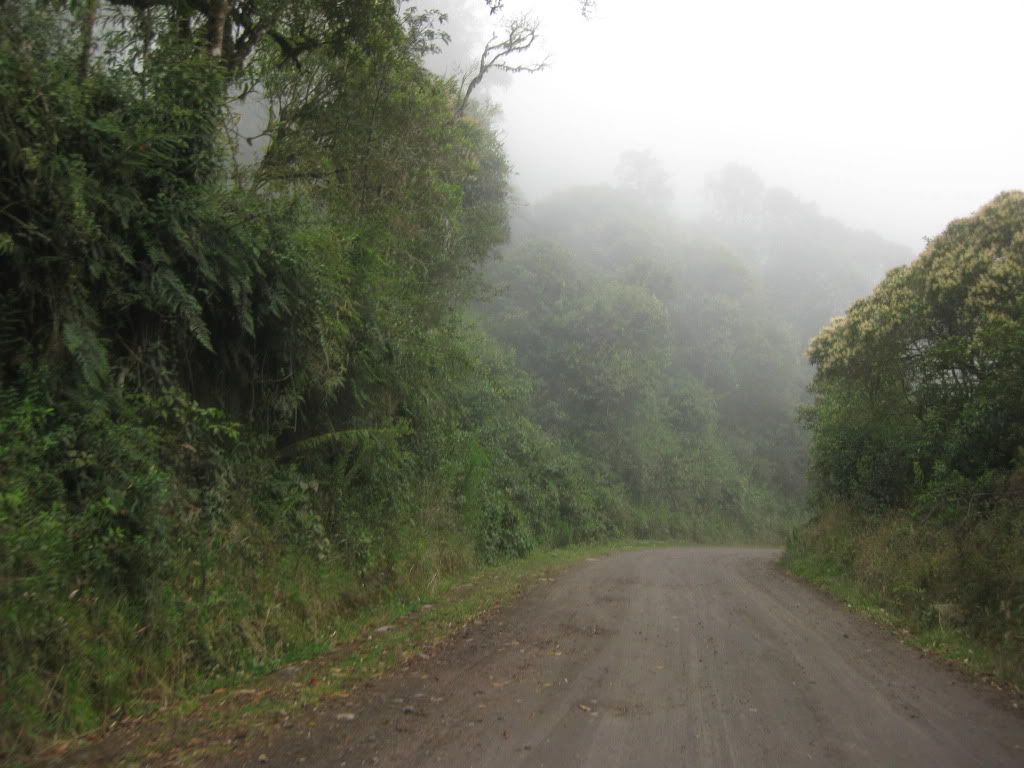
On the way down we took our second tumble of the trip. Going down a rocky hill the front wheel became destabalized from the large rocks in the road. Lost control and had a low-speed tip over. No damage to ourselves or the bike, just a sore knee the rest of the day. Ecuador is just bad luck. Did 9 countries with no spills and now two in 200 miles!
Our next destination was Guayaquil, the second biggest city of Ecuador. Ecuador is a gorgeous country.
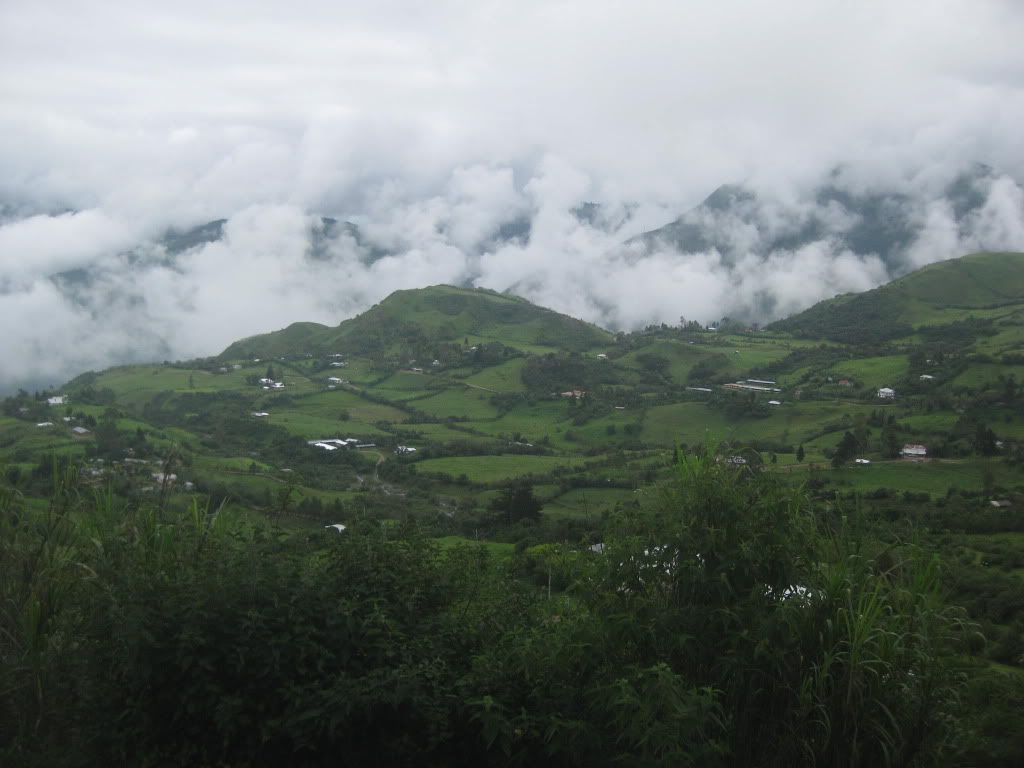
The first part of the day was clear, but after 2pm the clouds and the drizzle came in. We were riding through the clouds for hours. Visibility was only 10 meters, and the road was very wet. Not having a front fender, I had dirty water shooting up into my face constantly. Visor up or down, I couldn't see anything. This, plus numerous Ecuadorian dogs running into the road and tight twisty turns was just too much for me. We turned into a little town and asked for a hotel.

We had no idea where we were at this point. We had started the day following the signs to Guayaquil, but once we hit the clouds even if there had been signs we probably wouldn't have seen them. According to the spot tracker message we were in "Suscal", some secondary route.
The only hotel in town was a strange one. 4 stories high, but completely empty. Eventually a little boy came by, and said the room was $7. We went floor to floor looking at all the rooms that were unlocked. We chose one. A few minutes later a woman approached me on the street asking what I wanted to eat. $2 a plate. Where? She would bring it up to our hotel room. Some little girls walked in an hour later asking why we were in this room. Apparently they lived on that floor and used that bathroom. Strange circumstances, but the people were friendly and we were happy to be warm and dry again.
We ended up paying $10 for the room when we finally found the owner the next day. In the morning we bundled up and hit the road. 2 hours later we at sea level. Probably 50 degree difference. We were dying with all our layers on. Not so bad when we were moving (roads were flat and straight, back to 80mph!) Walking around from hotel to hotel in Guayaquil was a very sweaty enterprise. Guayquil is where we are now, doing laundry, uploading pictures, and all the fun stuff we've been putting off.

|
|
Currently Active Users Viewing This Thread: 1 (0 Registered Users and/or Members and 1 guests)
|
|
|
 Posting Rules
Posting Rules
|
You may not post new threads
You may not post replies
You may not post attachments
You may not edit your posts
HTML code is Off
|
|
|
|

Check the RAW segments; Grant, your HU host is on every month!
Episodes below to listen to while you, err, pretend to do something or other...

2020 Edition of Chris Scott's Adventure Motorcycling Handbook.
"Ultimate global guide for red-blooded bikers planning overseas exploration. Covers choice & preparation of best bike, shipping overseas, baggage design, riding techniques, travel health, visas, documentation, safety and useful addresses." Recommended. (Grant)

Led by special operations veterans, Stanford Medicine affiliated physicians, paramedics and other travel experts, Ripcord is perfect for adventure seekers, climbers, skiers, sports enthusiasts, hunters, international travelers, humanitarian efforts, expeditions and more.
Ripcord Rescue Travel Insurance™ combines into a single integrated program the best evacuation and rescue with the premier travel insurance coverages designed for adventurers and travel is covered on motorcycles of all sizes.
(ONLY US RESIDENTS and currently has a limit of 60 days.)
Ripcord Evacuation Insurance is available for ALL nationalities.
What others say about HU...
"This site is the BIBLE for international bike travelers." Greg, Australia
"Thank you! The web site, The travels, The insight, The inspiration, Everything, just thanks." Colin, UK
"My friend and I are planning a trip from Singapore to England... We found (the HU) site invaluable as an aid to planning and have based a lot of our purchases (bikes, riding gear, etc.) on what we have learned from this site." Phil, Australia
"I for one always had an adventurous spirit, but you and Susan lit the fire for my trip and I'll be forever grateful for what you two do to inspire others to just do it." Brent, USA
"Your website is a mecca of valuable information and the (video) series is informative, entertaining, and inspiring!" Jennifer, Canada
"Your worldwide organisation and events are the Go To places to for all serious touring and aspiring touring bikers." Trevor, South Africa
"This is the answer to all my questions." Haydn, Australia
"Keep going the excellent work you are doing for Horizons Unlimited - I love it!" Thomas, Germany
Lots more comments here!

Every book a diary
Every chapter a day
Every day a journey
Refreshingly honest and compelling tales: the hights and lows of a life on the road. Solo, unsupported, budget journeys of discovery.
Authentic, engaging and evocative travel memoirs, overland, around the world and through life.
All 8 books available from the author or as eBooks and audio books
Back Road Map Books and Backroad GPS Maps for all of Canada - a must have!
New to Horizons Unlimited?
New to motorcycle travelling? New to the HU site? Confused? Too many options? It's really very simple - just 4 easy steps!
Horizons Unlimited was founded in 1997 by Grant and Susan Johnson following their journey around the world on a BMW R80G/S.
 Read more about Grant & Susan's story
Read more about Grant & Susan's story
Membership - help keep us going!
Horizons Unlimited is not a big multi-national company, just two people who love motorcycle travel and have grown what started as a hobby in 1997 into a full time job (usually 8-10 hours per day and 7 days a week) and a labour of love. To keep it going and a roof over our heads, we run events all over the world with the help of volunteers; we sell inspirational and informative DVDs; we have a few selected advertisers; and we make a small amount from memberships.
You don't have to be a Member to come to an HU meeting, access the website, or ask questions on the HUBB. What you get for your membership contribution is our sincere gratitude, good karma and knowing that you're helping to keep the motorcycle travel dream alive. Contributing Members and Gold Members do get additional features on the HUBB. Here's a list of all the Member benefits on the HUBB.
|
|
|















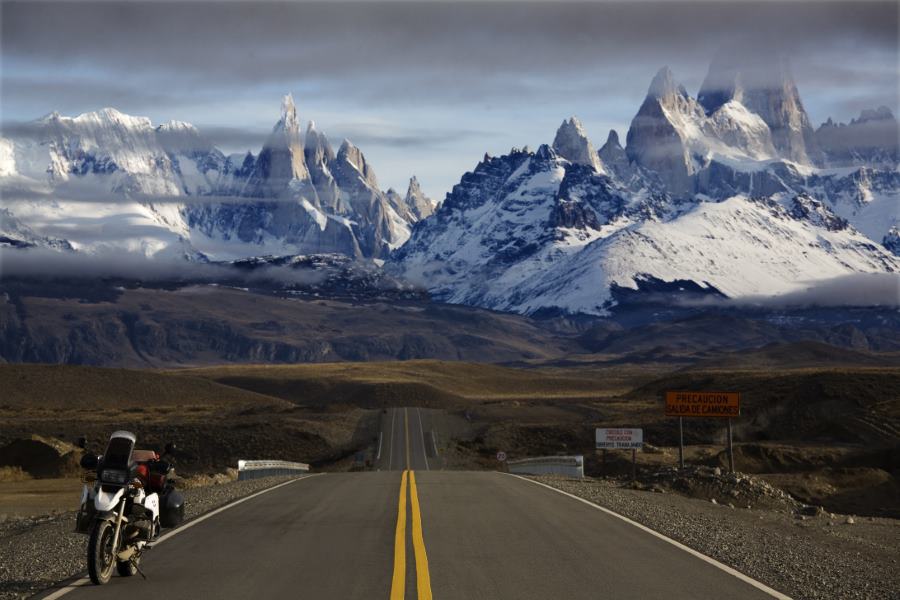

 1Likes
1Likes



















































































 and coffee. Live music, incredible actors and actresses. Very cool.
and coffee. Live music, incredible actors and actresses. Very cool.





































































































 Hybrid Mode
Hybrid Mode



